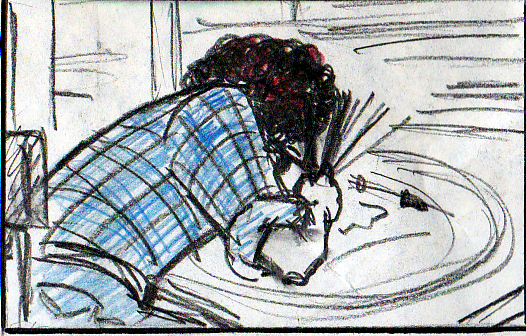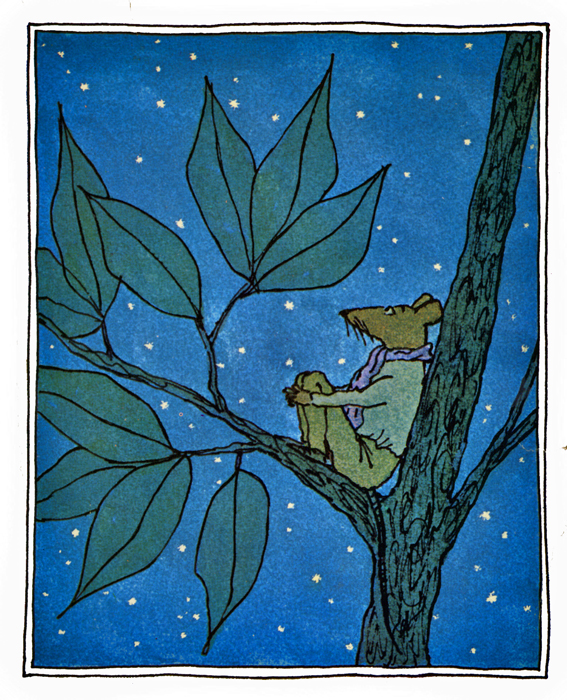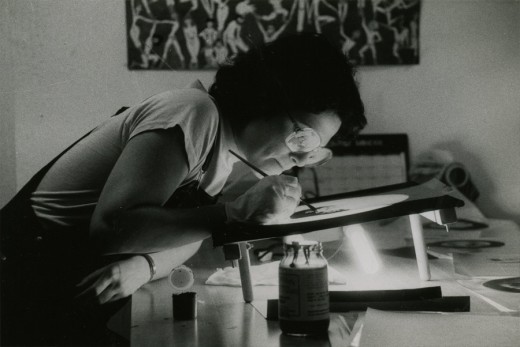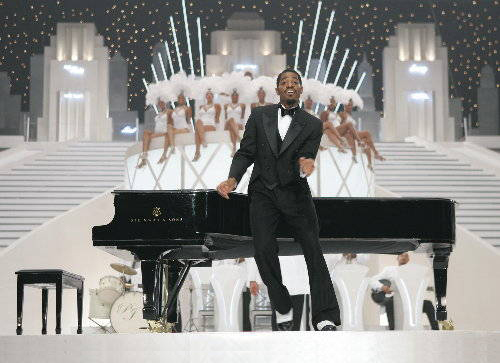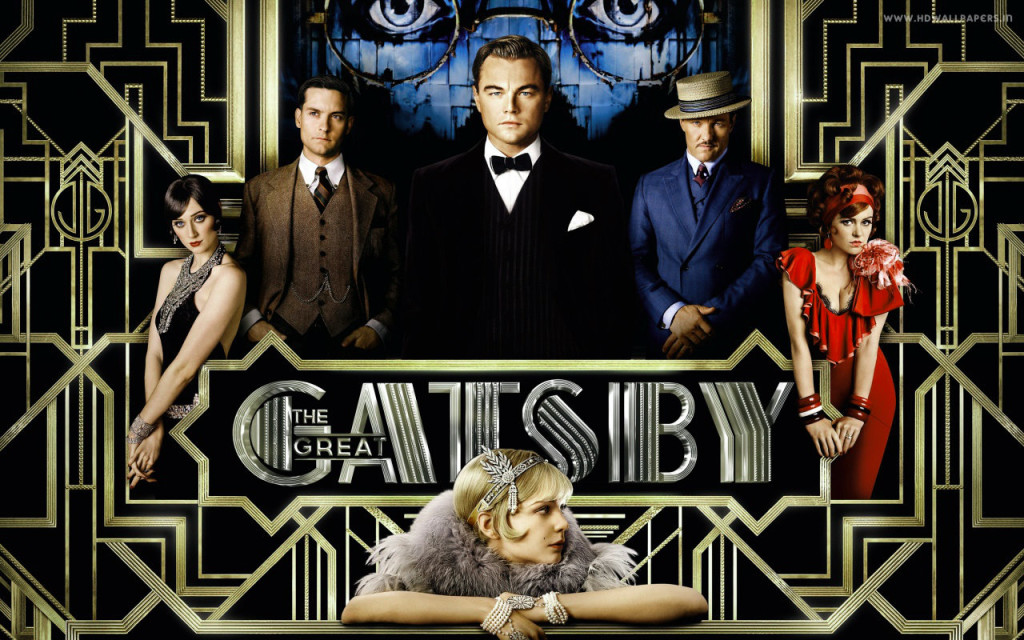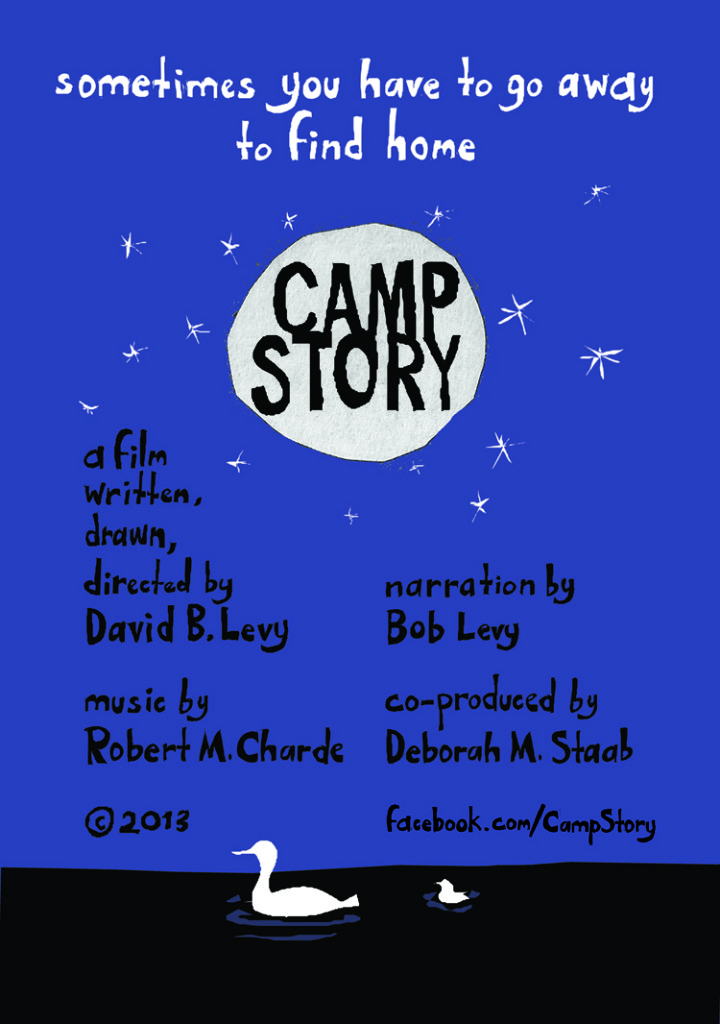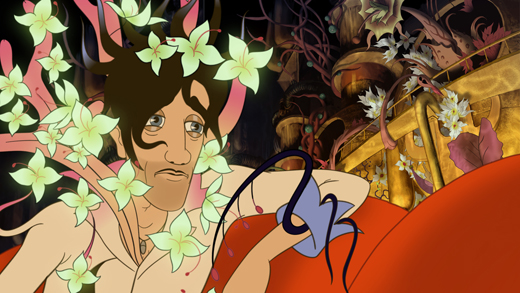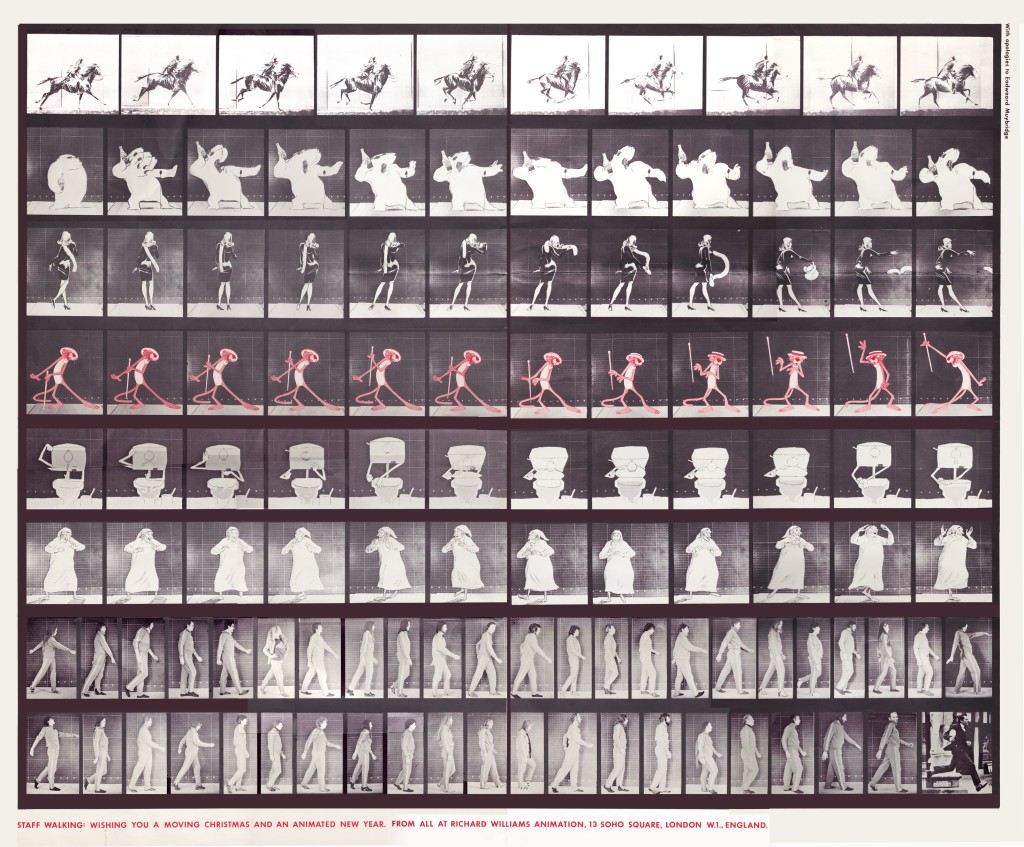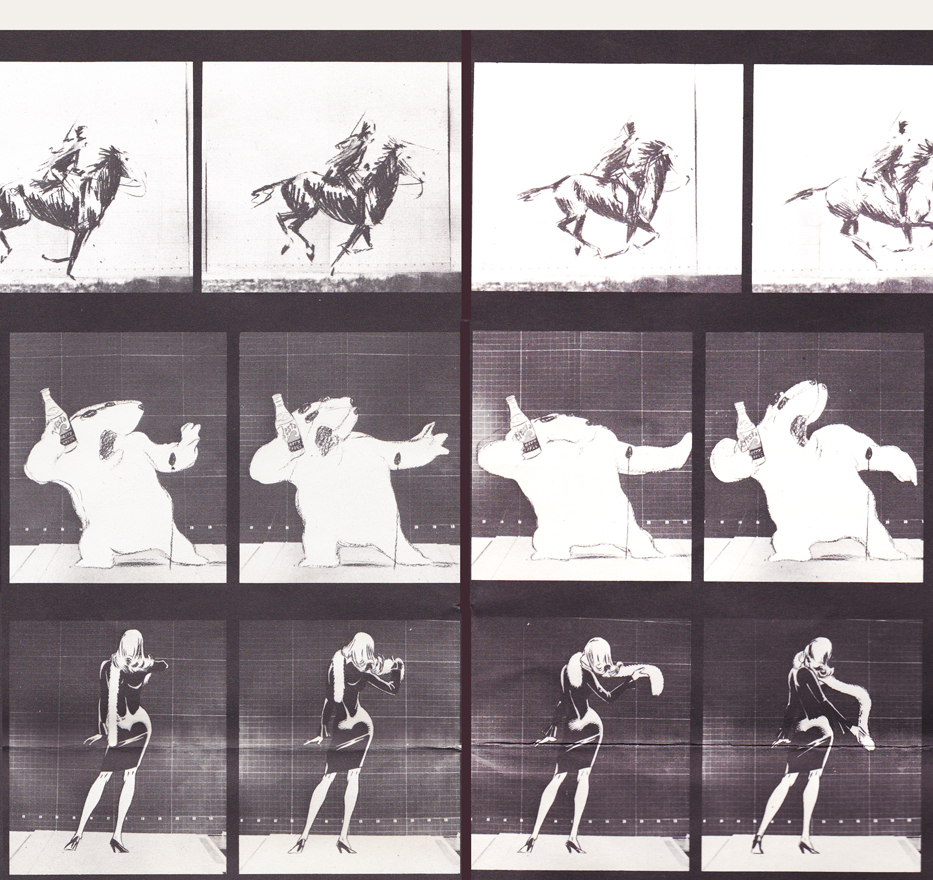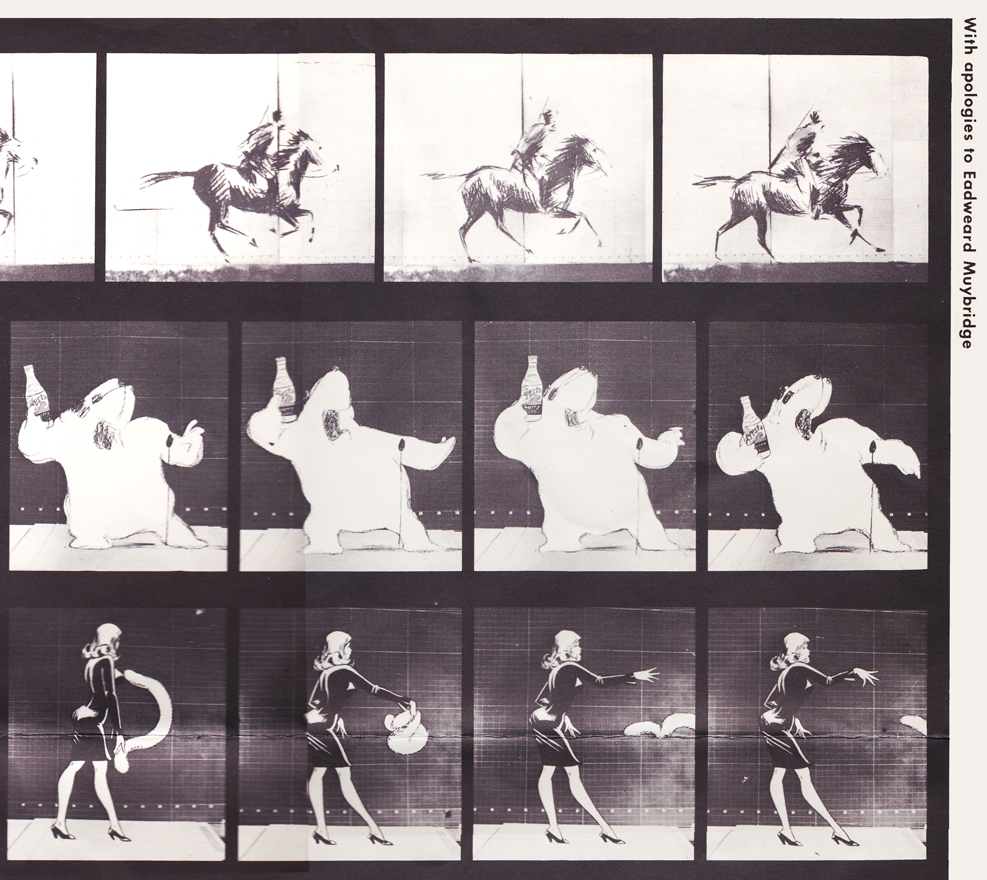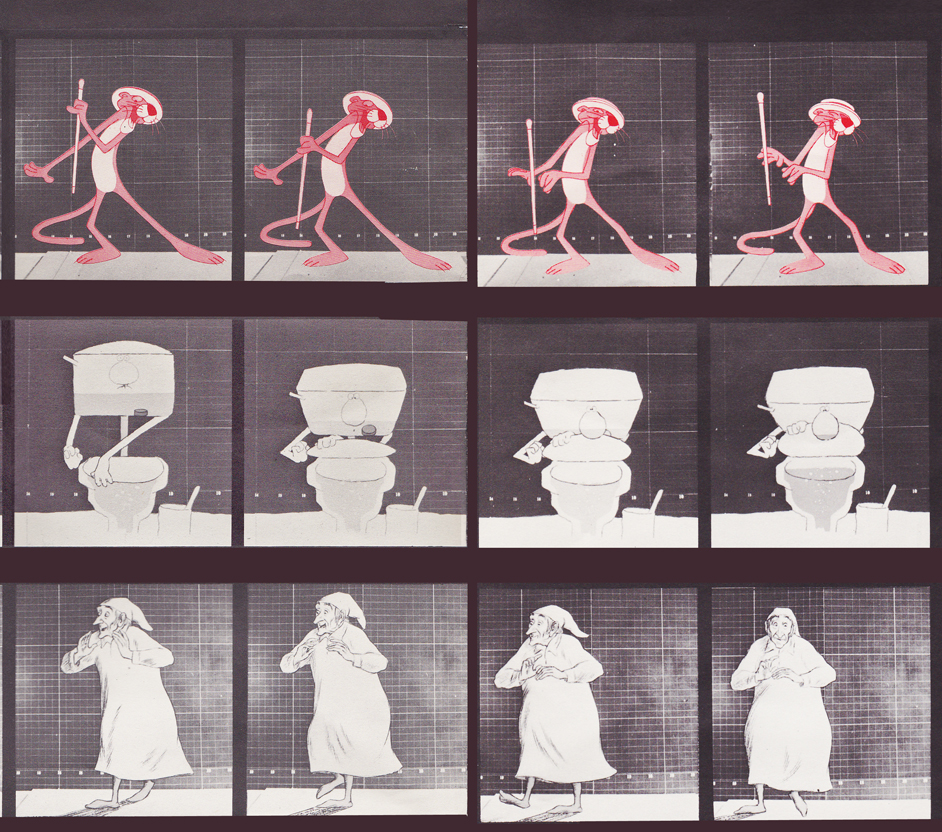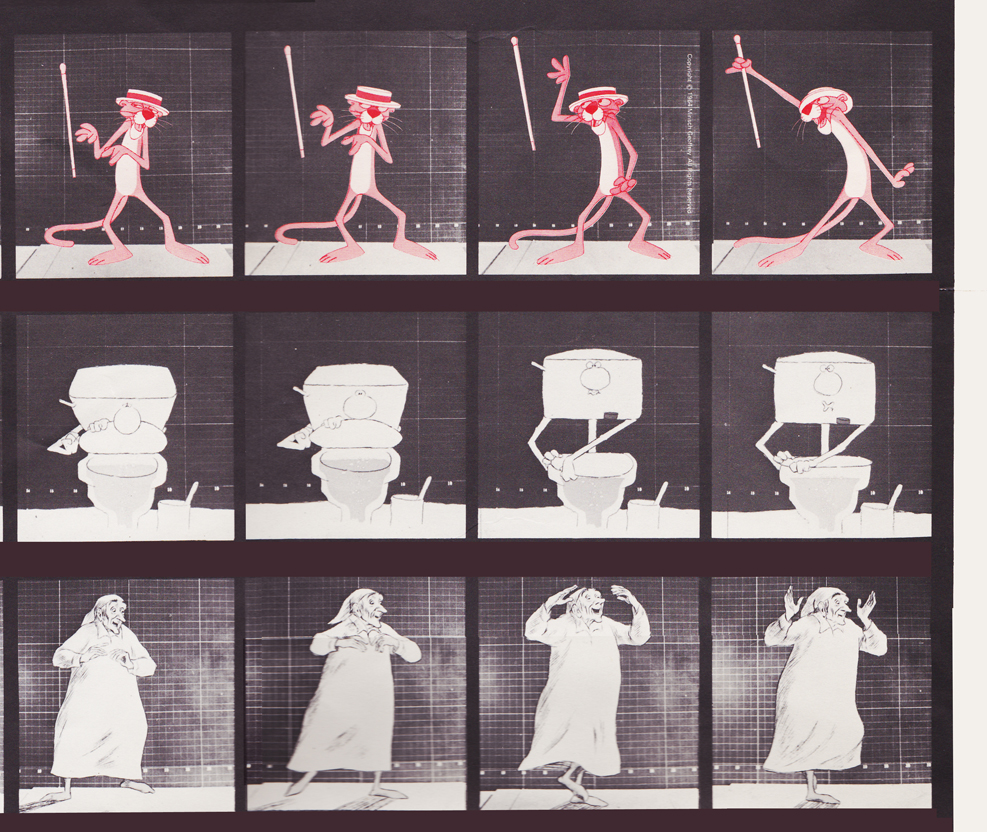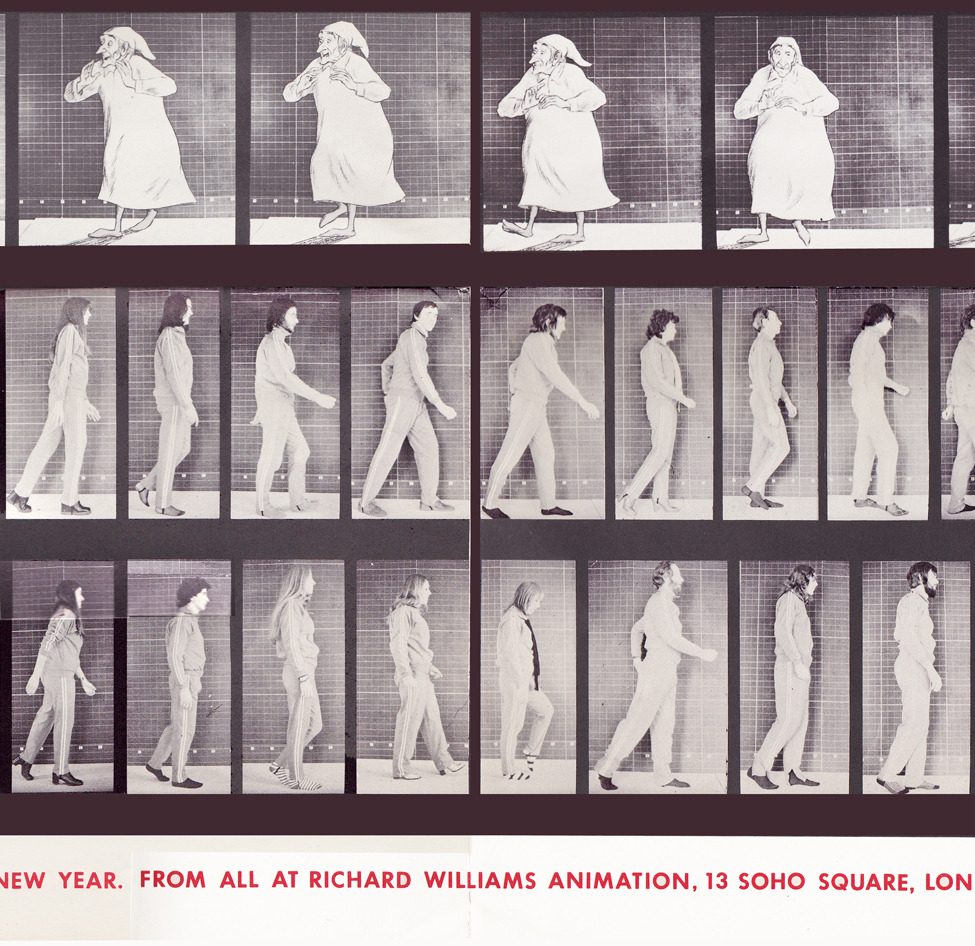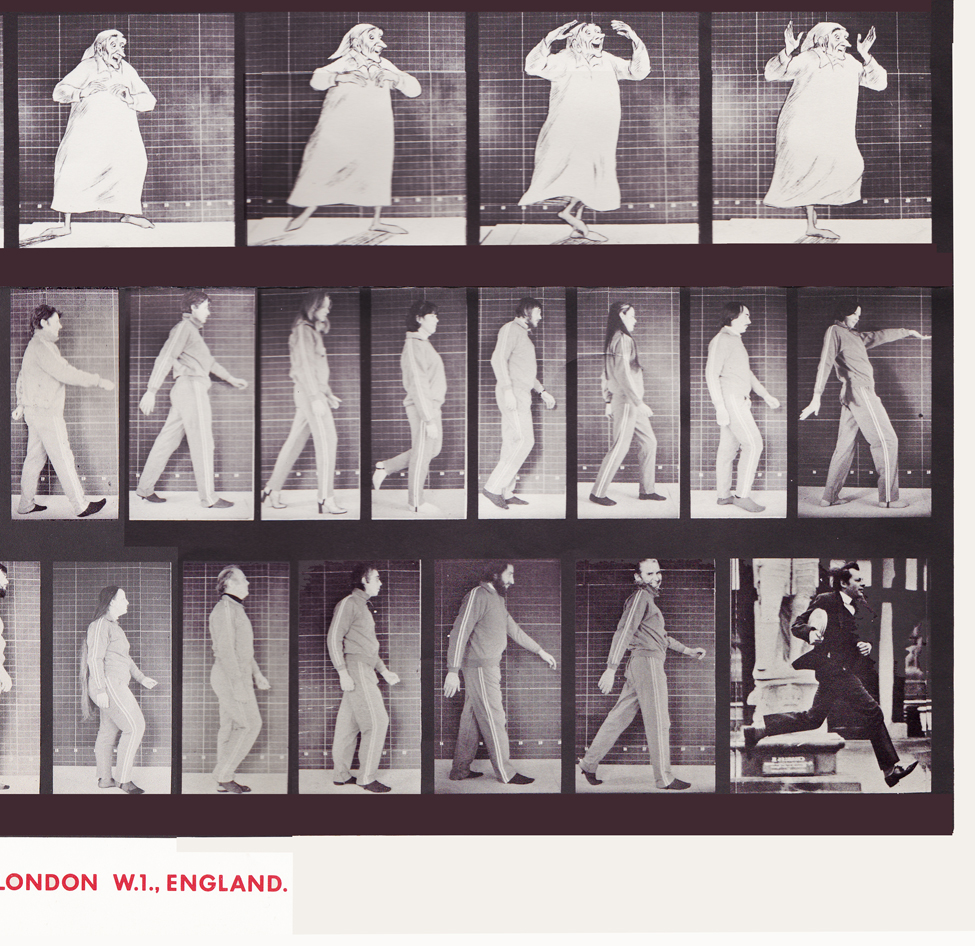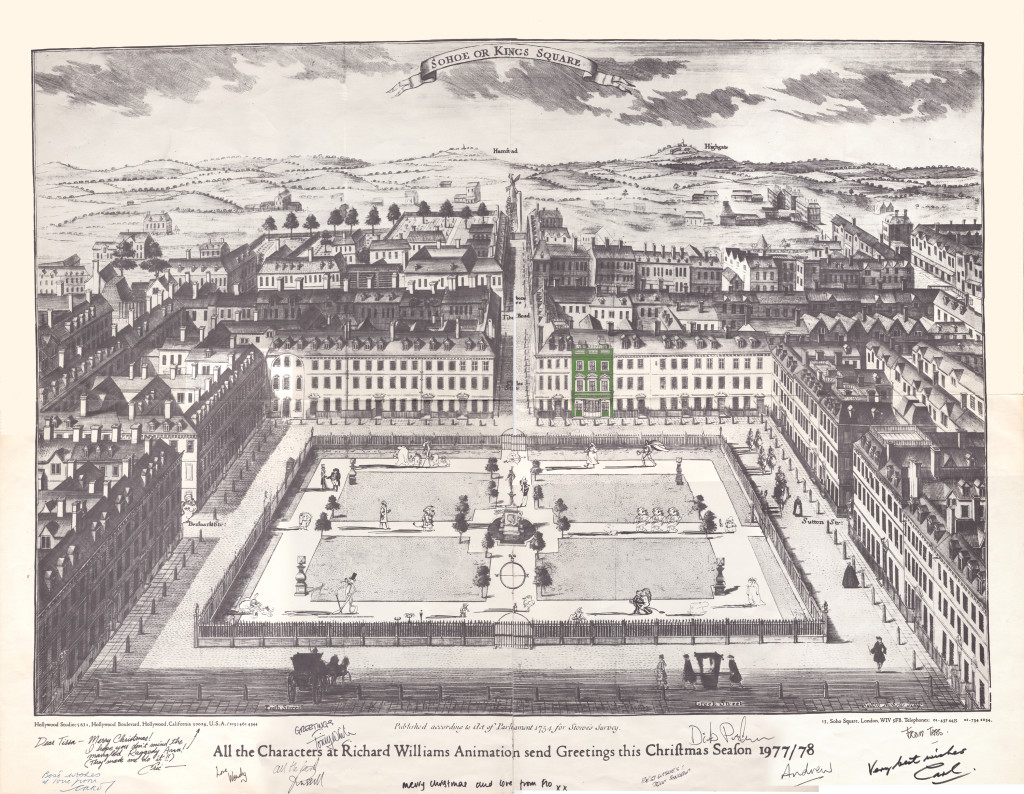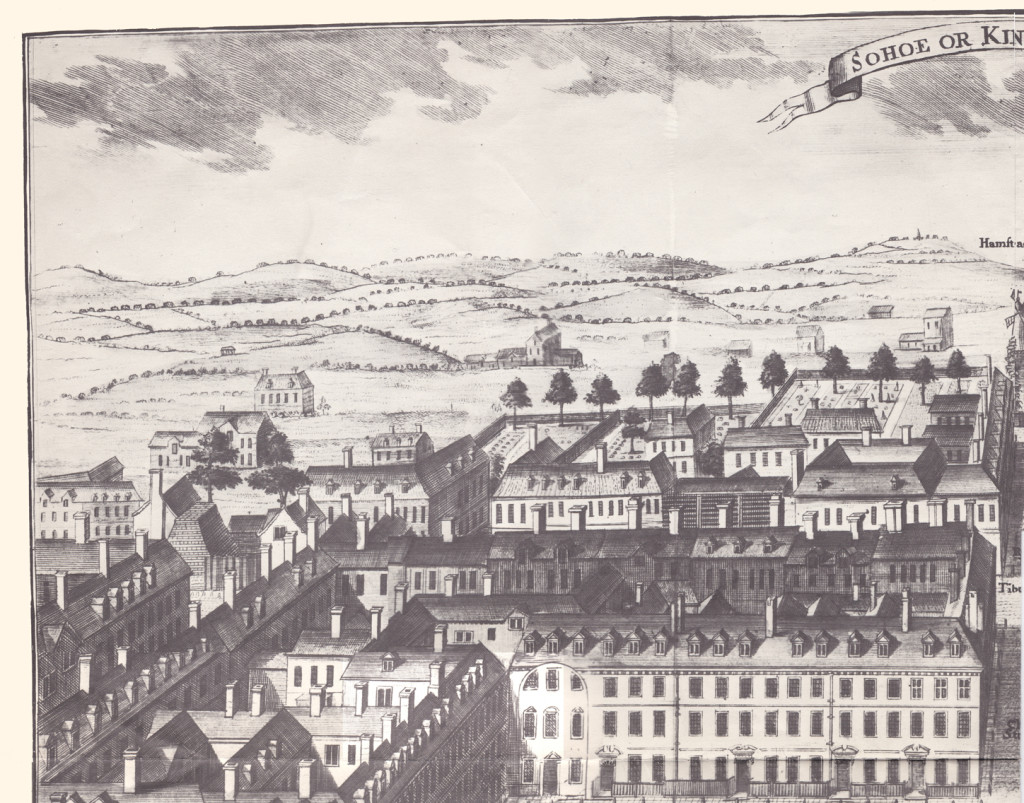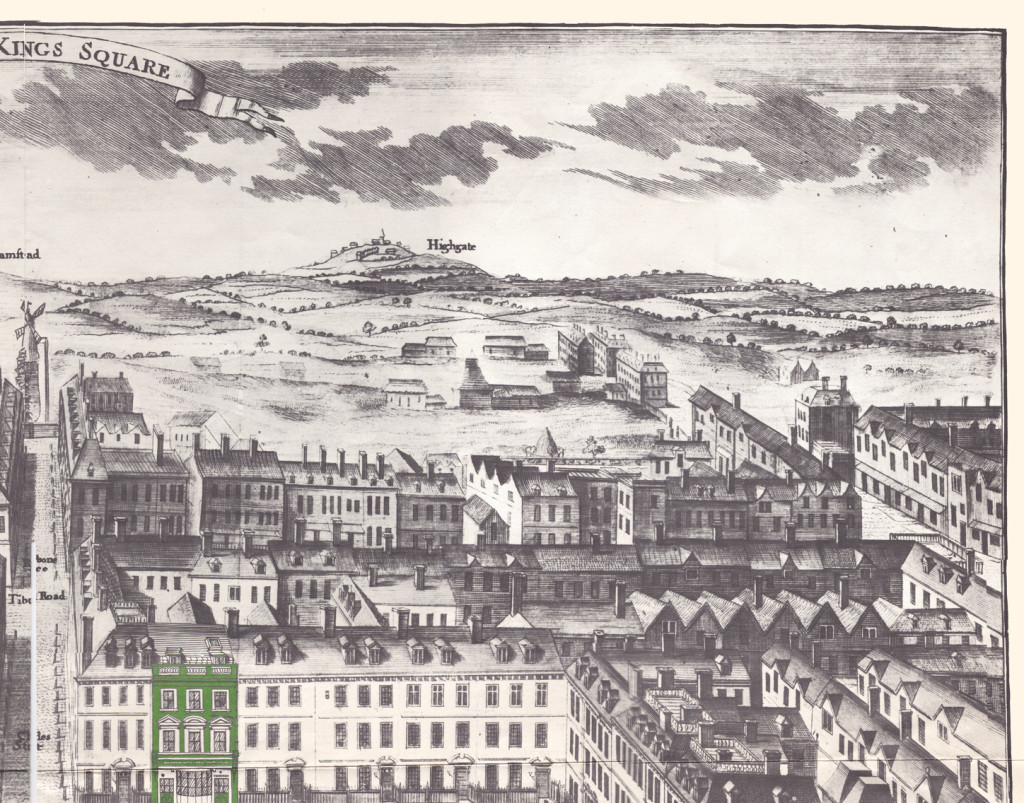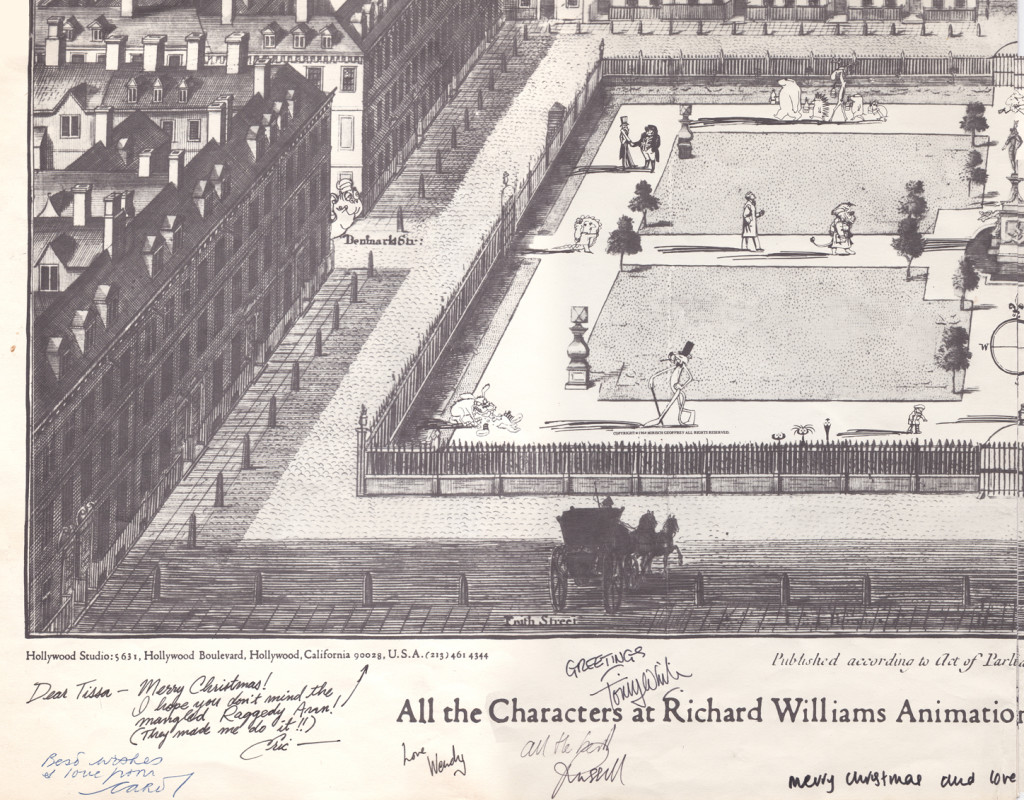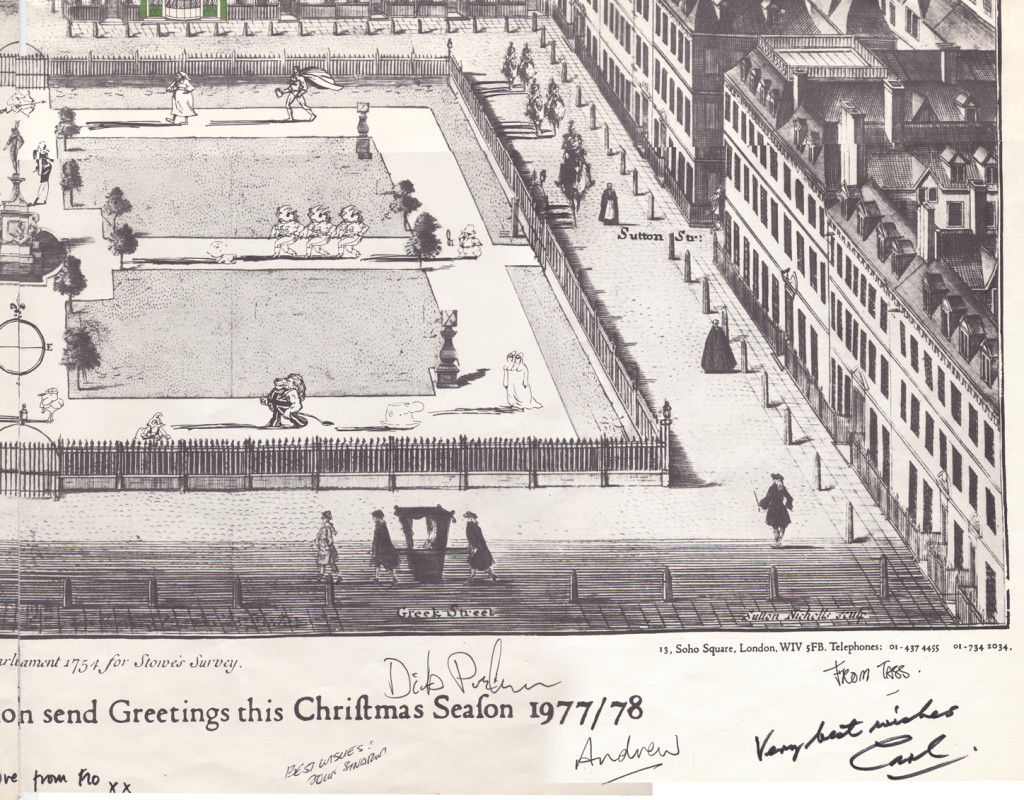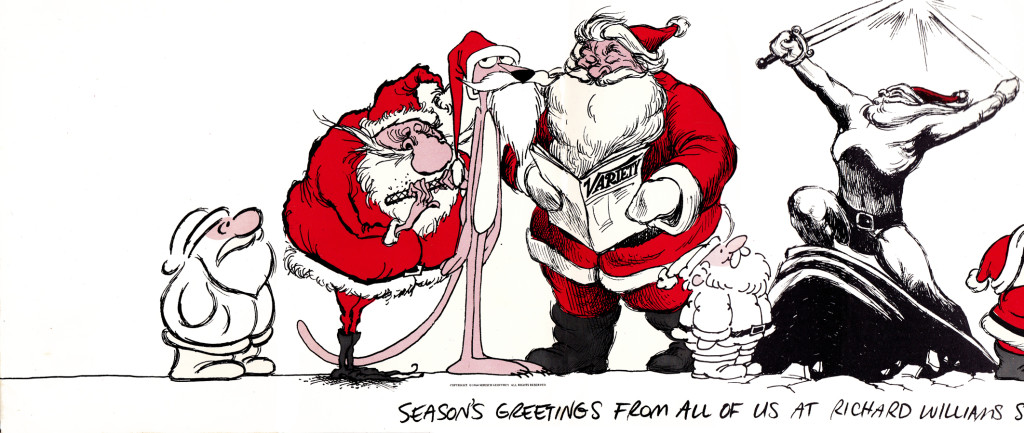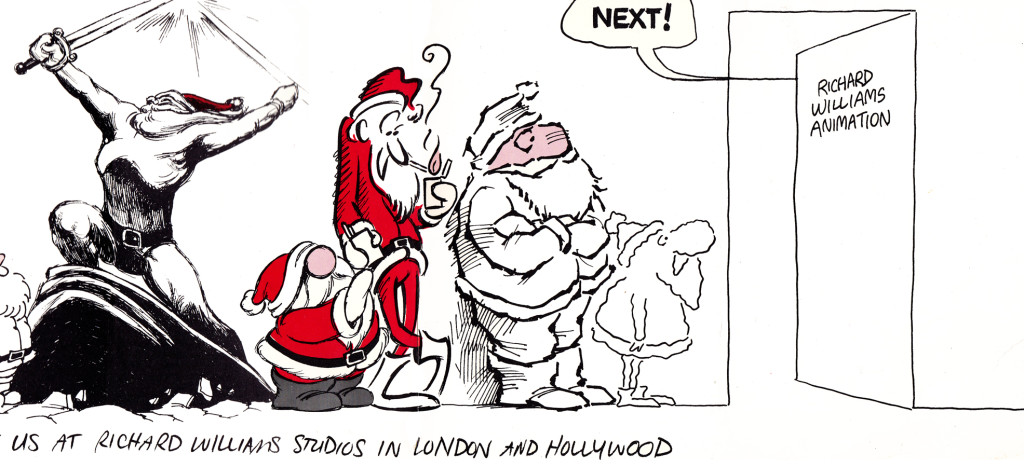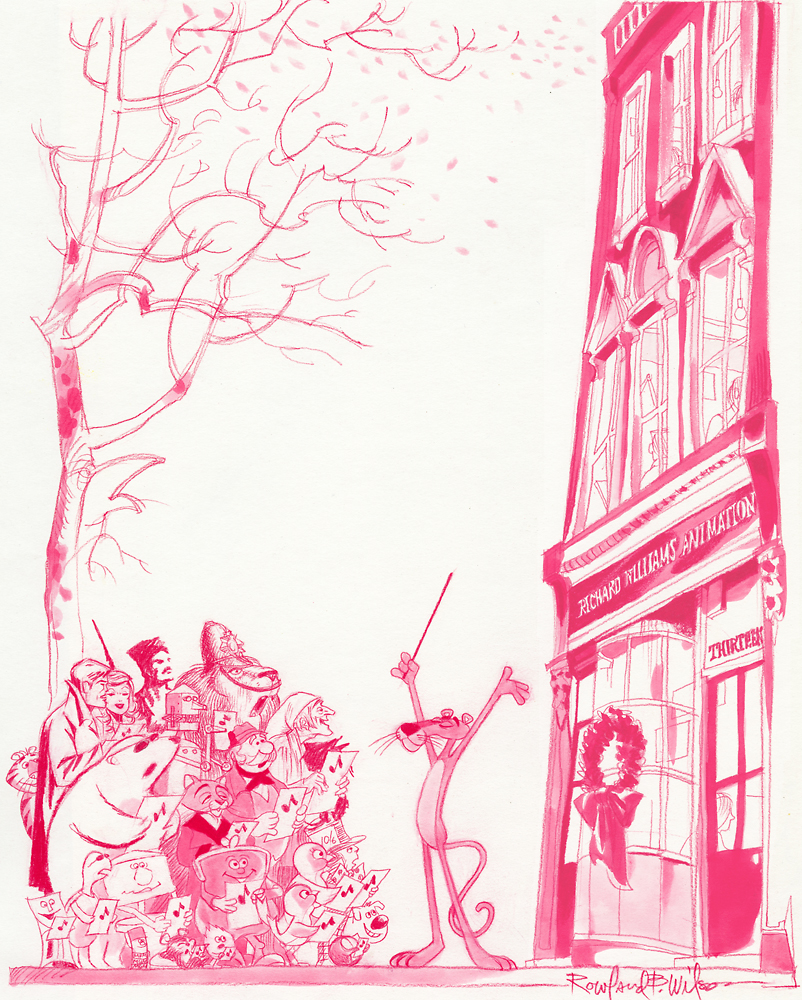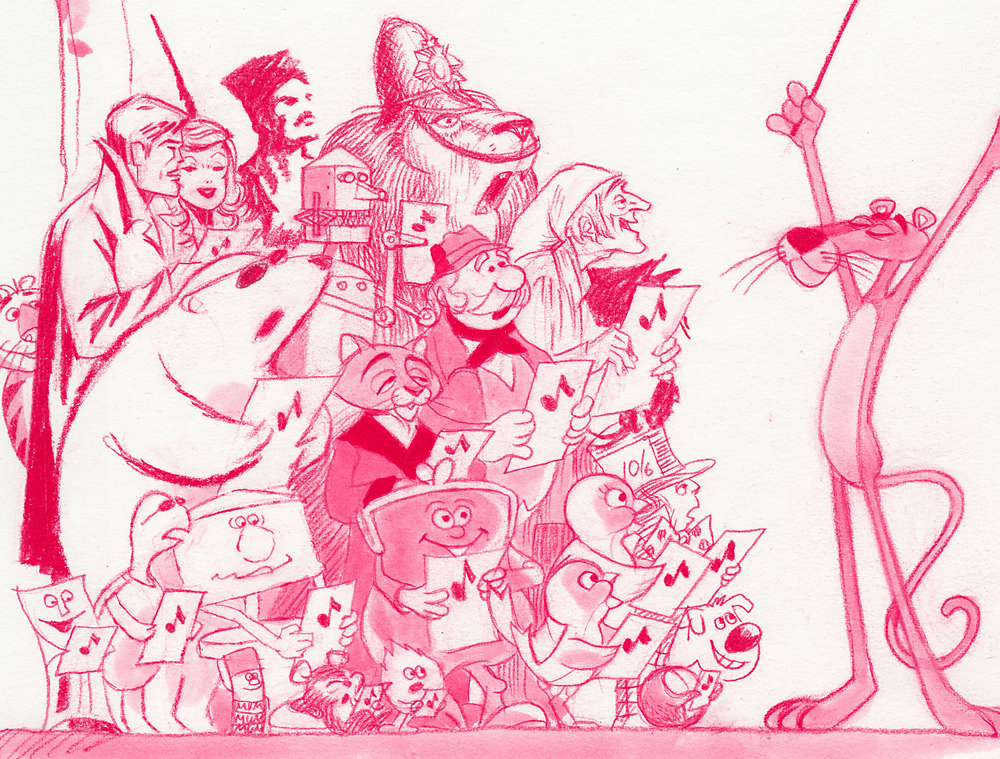Search ResultsFor "Raggedy Ann"
Daily post 07 Feb 2015 05:00 pm
Animation Day of Rememberance for Michael Sporn
Today in Hollywood, Tom Sito and Yvette Kaplan will represent Michael at the Animation Day of Remembrance. Tom and Michael go all the way back to 1976 and Raggedy Ann. Yvette met Michael at The Hubley Studio here in NYC. I have requested that they include Ray Kosarin’s superlative memorial to Michael and his studio. It was written by Ray for Michael’s Memorial Celebration at the AMPAS Lighthouse screening room on March 31, 2014. Tom asked me if he could use the Michael’s rendering of the mouse, Abel, talking to The Star from Abel’s Island by William Steig for the program cover. I said, “Absolutely!” Both Tom and Yvette will be speaking. Michael would have been very pleased to be represented by such artists and friends. Tom will be sending some pics of the event that I will post later.
The image of Michael animating is by the great Tissa David. This image is one panel from a storyboard birthday card she drew for him in 1999 celebrating how they met at the Hubley Studio in 1972.
Ray’s memorial and Michael’s rendering of Abel are posted below. If you look closely at Abel’s eyes, you will see Michael.
Heidi
31 March 2014
Ray Kosarin
MICHAEL SPORN MEMORIAL
What Animation Should Be:
On Working with Michael
Michael was an extraordinary artist and his studio was an extraordinary place. And the two or three generations of animation artists, like me, who worked with Michael remain to this day something of an extended family. A great many of us admired Michael, learned from him and were, often importantly, influenced by him. This influence, along with Michael’s remarkable body of work, is a vital part of his legacy.
What makes Michael’s films as distinctive—and as good—as they are comes from who he was: from what mattered to Michael, in art of any kind, and his convictions about what animation was. His studio was something like a repertory company of artists he trusted, and from whom he coaxed the work he wanted. And the way did was rare and exciting.
When you worked for Michael, he invested you in what mattered to him. He shared films and art of all kinds he thought were good; he made clear (at times brutally) what he did not; and he demonstrated by his own example, continually infusing you with his ethos of what animation should be. Figuring out what to do about it was your problem. And you felt determined to get it right.
In this way, Michael’s direction was both firm and, thrillingly, open-minded. He’d hand out full sequences, casting animators according to their sensibilities, and if you wanted to do a particular sequence, he almost always made sure you got it, trusting there was probably a good reason it spoke to you. He seldom gave too-specific directions, preferring to watch where your instincts carried the scene.
This made for a studio atmosphere of personal responsibility and shared purpose. Your work had better be good, but not conspicuous about it. When busy on a production, Michael moved swiftly and spoke little, which sharpened you to the small but critical signals whether you were giving him what he wanted. When OK’ing a line test of a scene you’d just animated, he might enigmatically say, “It moves,†then get on with something else. But when you gave him something he really liked, he’d usually just say, “Great.†At least you were pretty sure that’s what he said. But he said it quickly, while already striding away toward his desk: there was other work to do. When the studio was humming, it felt like a large family, all cooking dinner.
Without a doubt, the quality Michael most prized, both in the work he admired and the work he made, was economy.
Michael is somewhat legendary for the small budgets with which he made most of his films. As his good friend, animation historian Michael Barrier—who’s with us tonight—wrote: “Michael’s genius, and his curse, was that he could do so much with such tiny budgets. I will never cease to wonder what he might have accomplished with the money that always seems to be available to people with only a fraction of his talent and none of his integrity.â€
Yet it would also be a mistake to think that the economy in Michael’s films was strictly about money. In fact, something much more important was going on—something about artistic morality.
Always Michael was drawn to artists who did powerful work with conspicuously minimalist means: painters like Paul Klee, composers like John Adams. Michael often played in the studio minimalist music by Adams, or Philip Glass—music balanced so precisely that, after many bars reiterating the same arpeggio, one note’s climbing a semitone became an epic event. Minimalism was no apology for limited means: it was an expression of artistic purity—a virtuosic display of an artist in peak control of his powers.
So Michael drove you to do much with little. He goaded you by example, dropping valuable hints through his running commentary on his own work. He might, after pencil-testing a scene, triumphantly shout, “Ten drawings!†and then do his pirate laugh.
But through it all was an unmistakable higher purpose. The leaner your animation got, the more focused—a quest for the sweet spot where the interval between one drawing and the next, as with the minimalist composers, became the richest possible event. You were not cheating the audience out of drawings: you were showing them the respect not to squander on them drawings that only smoothed, but did not tell.
It worked wonders. It forced you to work smarter. And, low budgets or not, the films stubbornly won Emmys, ACE Awards, festival prizes, endless critical praise.
All of us who were lucky to work with Michael have of course had our own experiences. And yet our shared experience working with him, as we always remember when our paths cross today, importantly shaped and strengthened us all—as artists and individuals. The vocabulary Michael shared with us for how to know and make good work, to this day, coaxes us to do better, even on projects Michael might not have deemed worthy. Michael’s habit of dogged perseverance reminds us of our own reserve. And stubbornly alive in all of us are Michael’s sharp eye and infallible taste. This is Michael’s living—and loyal— legacy.
Who could wish one any better?
Ray Kosarin
Animation &Commentary &Independent Animation 22 Jul 2013 04:25 am
A Friend in Lou
- I’ve been thinking a lot about my friend, Lou Scarborough, this past week. So why not write about him? That’s what I’m going to do. Just random thoughts, good and bad, I guess. All just random. I’m sure I’ll have other posts to add to this, eventually.
I met Lou years ago the same way I met a whole core of NY friends and folk.
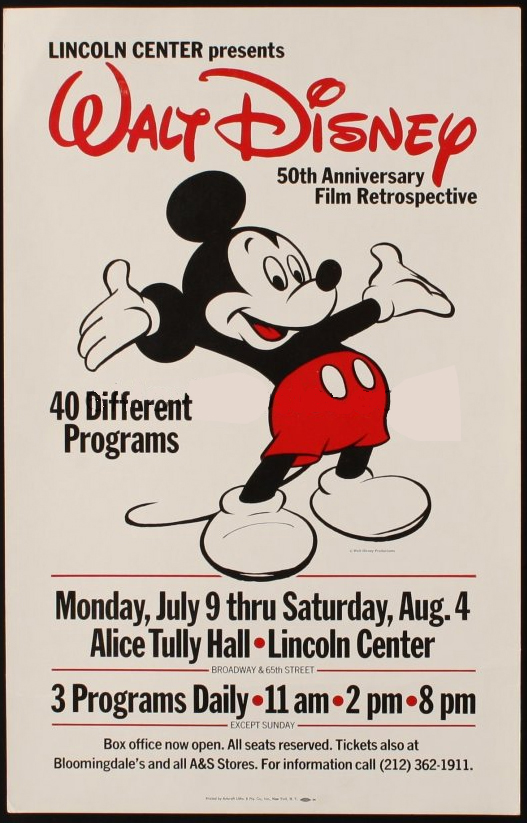 Back in 1978, Disney celebrated the 50th anniversary of Mickey Mouse’s creation. History for a lot of us – I mean, here, the celebration not the creation. The MoMA had a retrospective of all 50 years of Mickey cartoons in chronological order. They started with a bunch of silent Alice in Cartoonland followed by Oswald the Rabbit cartoons. They were shown silent. I mean SILENT – no audio, not even an organ. They ended that first program with Steamboat Willie. Now there was the invention of sound. You could hear it, you could feel it, you knew a new era had begun. Soundies.
Back in 1978, Disney celebrated the 50th anniversary of Mickey Mouse’s creation. History for a lot of us – I mean, here, the celebration not the creation. The MoMA had a retrospective of all 50 years of Mickey cartoons in chronological order. They started with a bunch of silent Alice in Cartoonland followed by Oswald the Rabbit cartoons. They were shown silent. I mean SILENT – no audio, not even an organ. They ended that first program with Steamboat Willie. Now there was the invention of sound. You could hear it, you could feel it, you knew a new era had begun. Soundies.
Up at Lincoln Center, they were showing all the feature films, animated as well as live action films. Things like Pollyanna and Treasure Island as well as Lady and the Tramp and Dumbo.
The best part, though, was around the corner, daily, at the Library of the Performing Arts. Speaker/Guests included Animators: Frank Thomas, Ollie Johnston, Woolie Reitherman, Designer: Eric Anderson, and John Culhane moderated a bunch of it. They showed clips of a lot of the feature animated films; they told famous stories for the millionth time, they told stories we hadn’t heard before. (e.g. Reitherman wanted the disco ball and the changing colors as the cats of the Aristocats played jazz in the attic. His was not something others wanted in the film. The director got what he wanted including a lot of reuse animation. Reitherman learned something about Xerography other than inking stories during 101 Dalmatians.
Anyway, to get into this series of programs (I’m sure there were four of them) you’d sit on the ground in the hot sun waiting for the doors to open when they handed out tickets. I was working for John Hubley at the time. A lot of the others: Dan Haskett, Tom Sito, Pat Sito, John Lopez, Kevin Petrilak, Bob Lusk, and, of course, Lou Scarborough, all worked at a place called Tele-Tactics where they were paid horrible wages as animators working on something called The Days of Liberty.
Over time, a lot of those people went to Raggedy Ann in a direct route uptown once that studio opened. I was teh first hired there, so I got to watch the influx as animation began.
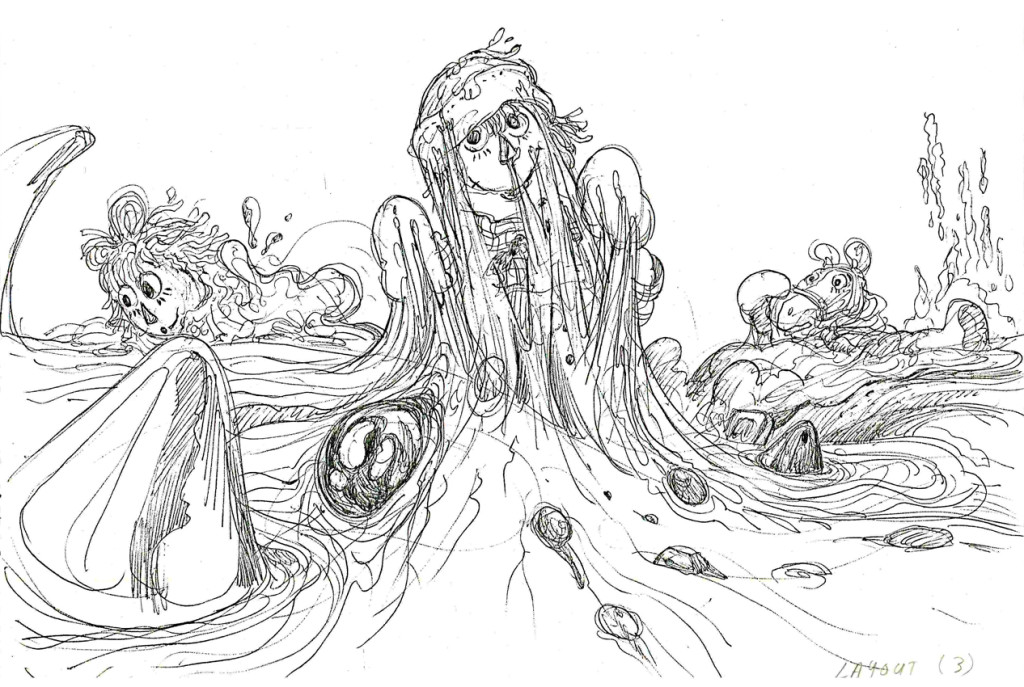
Lou went with a whole group directly into the Taffy Pit to clean up and inbetween the elaborate and gutsy drawings of the master, Emery Hawkins. Exhausting work but they were all friends and had a group all their own during Raggedy’s world. A new era of sorts had begun – the taffy pit folk. Ultimately, they all moved out to LA, worked at Disney for a bit and at a bunch of other feature studios for a bit.
- I also remember during the late 70′s and early 80′s that Lou Scarborough was closely involved with Wendy and Richard Pini‘s fantasy characters from Elf Quest.
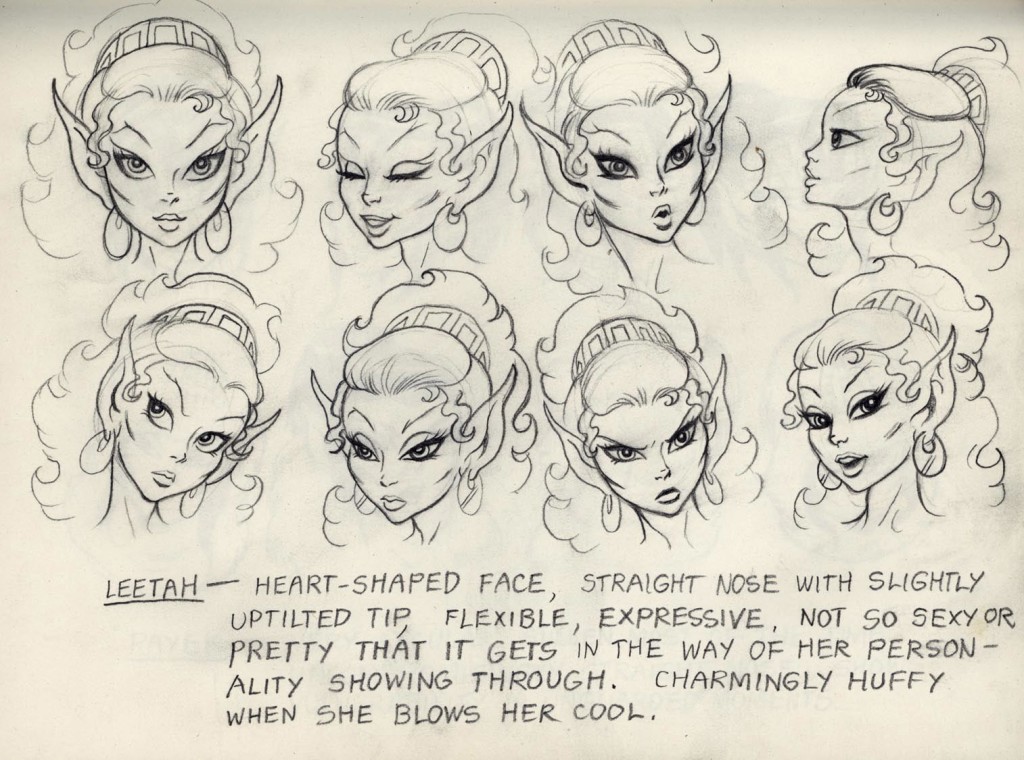
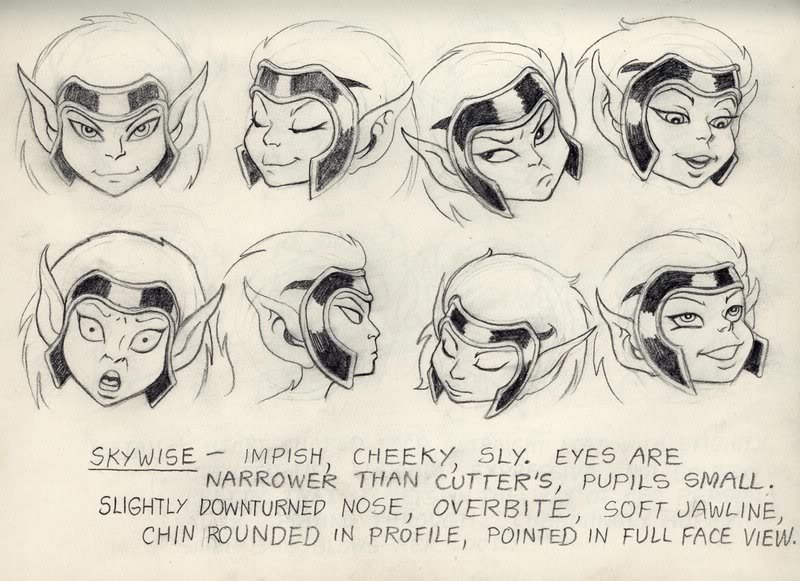
A sample of the Elf Quest art
Along with Dan Haskett and other friends he helped build model sheets and tried desperately to get the comic books animated. I don’t believe much happened with the work, especially after it moved to cgi. In my opinion it lost any magic it had in the 2D cartoon drawings and completely lost everything in the clumsy cgi artwork.
In a way, it seems to me that this art style seriously affected Lou. Though I was certainly not a fan, I did appreciate the hard work all the artists did in putting it together. The whole enterprise, though, seemed like too many other fantasy pieces that were out there.
Lou was one of the last to leave New York City for the West Coast. He did a couple of jobs for me before he left. There were some Sesame Street spots, dances, that he animated. Then there were a couple of episodes of a show called Brain Games done before Sheila Nevins moved in and took over at HBO. I did about 45 minutes of the six half hour shows Sheila produced with Jeff Schon as co-producer. . It was all fun work. Lou animated a centurian and oddly he had the guy move wildly from the forth pose to the fifth. There was an enormous surprise when this character moved, so traditionally drawn, and moved beautifully. The large
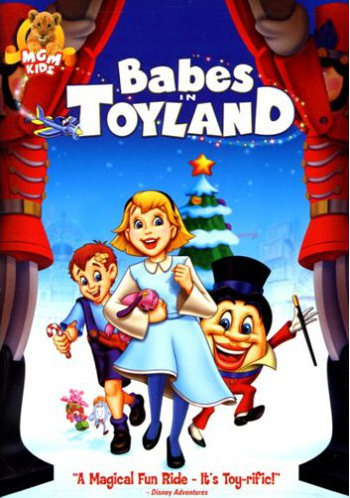 arc worked for the character and found me imitating Lou’s move more than once in future scenes. A peculiar layout that worked so well. I was the only one who noticed it and the only one who worried about it. No problema, it worked.
arc worked for the character and found me imitating Lou’s move more than once in future scenes. A peculiar layout that worked so well. I was the only one who noticed it and the only one who worried about it. No problema, it worked.
Lou moved to LA and worked on various business out there. He did a number of MGM musicals for home video. Things like Babes in Toyland, The Quest for Camelot, as well as The Adventures of Sonic the Hedgehog.
In the end, Lou ended up without money but still a lot of dreams. Now he’s fighting cancer in a hospital at a young age. Life’s tough, and I’m watching my friend closely. I hope his luck gives him a couple of good breaks.
Commentary 14 Jul 2013 01:10 am
For Lou
For Lou, whenever it’ll happen.
These days are his.
Tom Sito wrote: Yvette Kaplan and I visited with Lou Scarborough today
and spent time with him, Mark, and Lou’s brother Cecil.
Lou was alert but weak. He could not speak because of the respirator, but
he recognized us and understood what we were saying to him.
I felt that if he did not have the respirator
he might have been able to speak.
We chatted about Art&Design, Teletactics, Raggedy Ann
and the upcoming Comicon, and he understood it all.
Cecil said the cancer is in his prostate, colon, liver and now the lungs.
We left when they were about to take him off the respirator.
If he can breathe on his own, they will move him from the ICU to
a Hospice Care. We helped him complete his Will.
I joked that we were signing him into the Foreign Legion with Pepe LePew,
and I could see in his eyes he understood and was smiling.
This Hospital is a Charity Hospital, so no one spoke of money.
It is a nice facility. Jerry Beck and I have ASIFA and
the U-nion ready to fundraise should he need it.
We did not stay to see the results of his having his respirator turned off.
I trust Mark or Cecil will contact us with any future news.
If there is more, I’ll pass it on.
From BARRY CALDWELL later Sat.
I arrived at Lou’s bedside a little while after Tom left
and was present when they removed the breathing tube.
As Tom wrote, he was alert but weak. Fortunately, he was
able to breathe well on his own and spoke a little. He was
advised to rest in general and especially his vocal chords,
so my visit was very short.
Barry
Thanks, Tom, Barry and others, for sharing the information. It’s sad
for all of us who loved Lou during his short complicated lifetime.
Thanks to Steve Fisher for the use of his photos.
Animation &Animation Artifacts &Commentary &SpornFilms &Theater 19 May 2013 06:09 am
WOTY – again
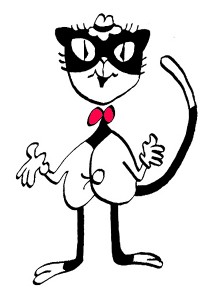 – I’ve posted a couple of pictures from Woman of the Year (called WOTY by those in the know) in the past but thought I go a touch deeper now.
– I’ve posted a couple of pictures from Woman of the Year (called WOTY by those in the know) in the past but thought I go a touch deeper now.
Woman of the Year was a project that came to me in the very beginning of my studio’s life – 1981. Tony Walton, the enormously talented and fine designer, had gone to Richard Williams in search of a potential animator for WOTY (as we got to call the name of the show.) Dick recommended me. But before doing WOTY, there were some title segments needed for Prince of the City, a Sidney Lumet film. (I’ll discuss that film work some other day.)
Tony Walton designed the character, Katz, which would be the alter-ego of the show’s cartoonist hero, played by Harry Guardino. Through Katz, we’d learn about the problems of a relationship with a media star, played by Lauren Bacall. (All images enlarge by clicking.)
.
It turned out to be a very intense production. Three minutes of animation turned into twelve as each segment was more successful than the last. There was no time for pencil tests. I had to run to Boston, where the show was in try-outs, to project different segments weekly; 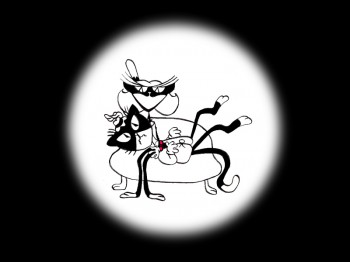 these went into the show that night – usually Wednesdays. I’d rush to the lab to get the dailies, speed to the editor, Sy Fried, to synch them up to a click track that was pre-recorded, then race to the airport to fly to the show for my first screening. Any animation blips would have to be corrected on Thursdays.
these went into the show that night – usually Wednesdays. I’d rush to the lab to get the dailies, speed to the editor, Sy Fried, to synch them up to a click track that was pre-recorded, then race to the airport to fly to the show for my first screening. Any animation blips would have to be corrected on Thursdays.
There was a small crew working out of a tiny east 32nd Street apartment. This was Dick Williams‘ apartment in NY after he;d finished Raggedy Ann. He was rarely there, and when he did stay in NY, he didn’t stay at the apartment. He asked me to use it as my studio and to make sure the rent was paid on time and the mail was collected. Since we had to work crazy hours, it was a surprise one Saturday morning to find that I’d awakened elderly Jazz great, Max Kaminsky, who Dick had also loaned the apartment for a night. Embarrassed, at the awkward confrontation, I ultimately moved to a larger studio – my own – shortly thereafter. Dick was convinced I was upset at him and the two of us didn’t talk for years afterward.
Here are a couple of photos of some of us working on WOTY:
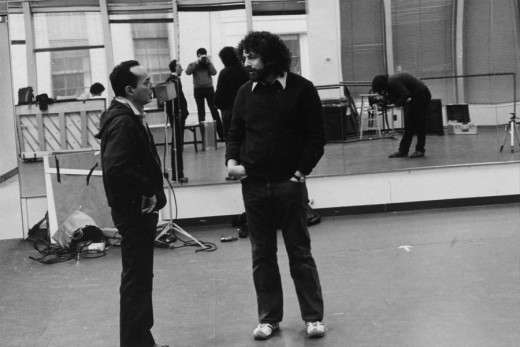
Tony Charmoli was the show’s choreographer. He worked with me in plotting out the big dance number – a duet between Harry Guardino and our cartoon character. I think this is the only time on Broadway that a cartoon character spoke and sang and danced with a live actor on stage. John Canemaker is taking this photograph and Phillip Schopper is setting up the 16mm camera.
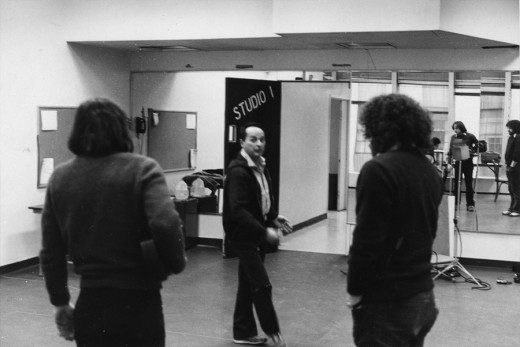
Here Tony Charmoli shows us how to do a dance step. Phillip Schopper, who is filming Tony, figures out how to set up his camera. We used Tony’s dancing as reference, sooting Tony’s dancing in 16mm, but our animation moves were too broad for anyone to have thought they might have been rotoscoped.
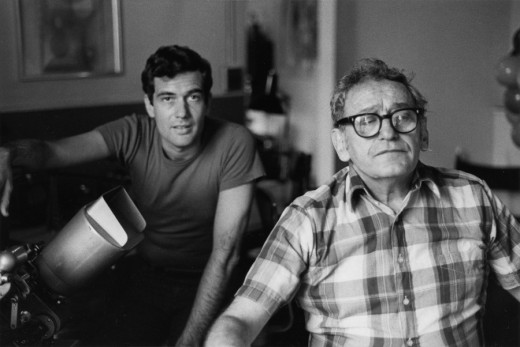
John Canemaker worked with Sy Fried, our editor. John did principal animation with me on this one big opening number. Here they’re working with the click track and the live footage of Tony Charmoli to plot out the moves.
At one point I asked John to have the character, Katz, flick his tale at Harry Guardino, tripping the live actor mid-dance. It got a laugh at every performance.
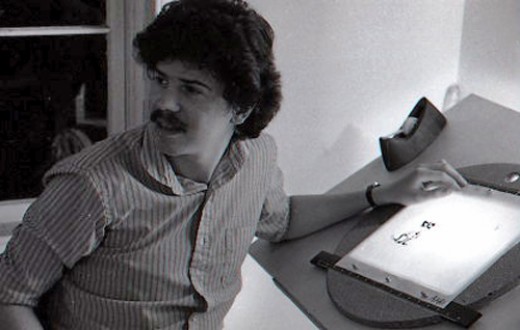
Steve Parton supervised the ink and paint. To get the sharpest lines, we inked on cels and didn’t color the drawings. It was B&W with a bright red bow-tie. A spotlight matte over the character, was bottom-lit on camera by Gary Becker. It was shot almost like a pencil test with high contraxt to get those very sharp lines.
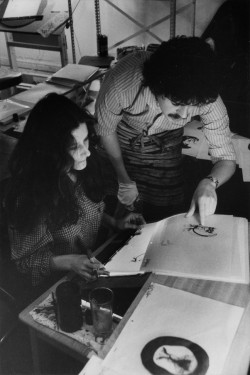 5
5 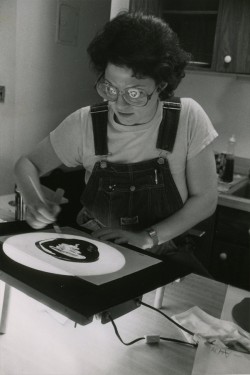 6
6
5. Steve Parton works with painter Barbara Samuels
6. Joey Epstein paints with fire in her eyes.
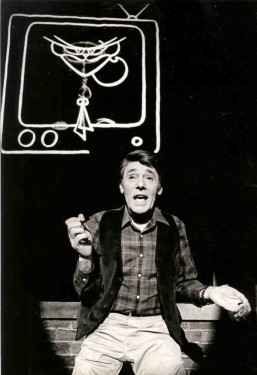 8
8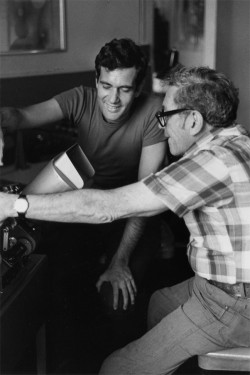 9
9
8. Harry Guardino on stage with the creation of “Tessie Kat” developing on screen behind him. This was Harry’s first big solo.
The filmed segment was shot backwards so the matte would develop as the song sang on.
The entire seqeunce took about 2½ minutes.
9. John Canemaker gets to see some of his animation with Sy Fried, editor.
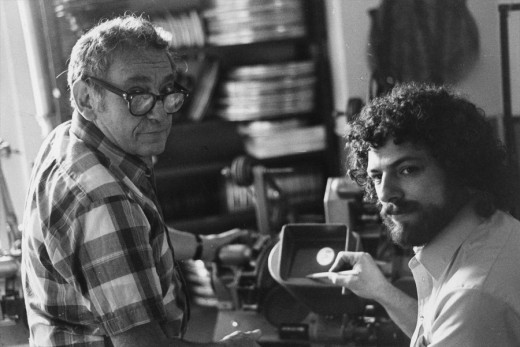
One of my quick stops from the lab on the way to Boston? No, I think this is a posed photo.
All together we had more than 12 minutes of animateion song duets between Harry Guardino and Katz. It was originally supposed to be three pieces totaling about five minutes. The animation was so successful in the tryouts in Boston that they kep adding more material. Finally the last song added – about 1½ minutes never made it to New York. Harry never properly learned it in Boston and he was too nervous for the Broadway opening to learn it for the big Opening. So the number was cut.
Lately there’s been more animation on Broadway and off-Broadway. Things are done with digital screens, and the technical aspect has gotten easier. One version of Sunday In the Park with George had painted backgrounds developing via animation as the characters sang their songs. Too bad the show didn’t offer the heart that was in the original Sondheim gem, when here wa no animation involved. Hopefully, eventually there will be something more. We did a show that was very successful (the show wasn’t successful; the animation was.) I’d love to try again. The only other try I had was to do musical scenics for the Overture to Meet Me In St. Louis on Broadway. The producers were irritants and didn’t help move things forward. I did get to meet the songwriter, Hugh Martin, before he passed away. That was my treat in that project.
Daily post 12 May 2013 07:19 am
Even More Raggedy Photos – 3
We haven’t quite finished with the collection of photos John Canemaker loaned me; these were the images he took for his Raggedy Ann book. Not all were chosen, but all were snapped by John.
I’ve chosed to post the photos and use them as a way for me to reminisce on the subject at hand. Lots of looking back, memories and other photos in my mind.
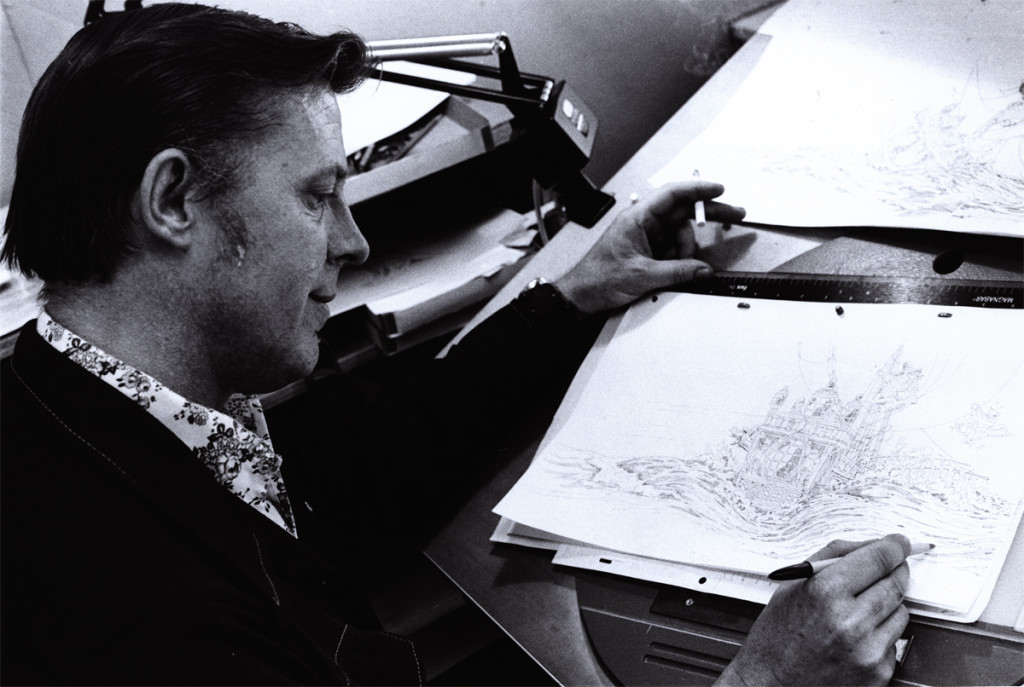 1
1Here we have animator, Doug Crane. Doug has always specialized
in the details animated. Animated roads, moving crowds or
animated news papers. doug has animated these all as his forte.
In Raggedy Ann, Doug was to do much the same as those scenes that
were animated by Corny Cole. Lots of moving sea, ships and cross
hatching. His scenes all have the necessary dynamic of a vast sea
of lines.
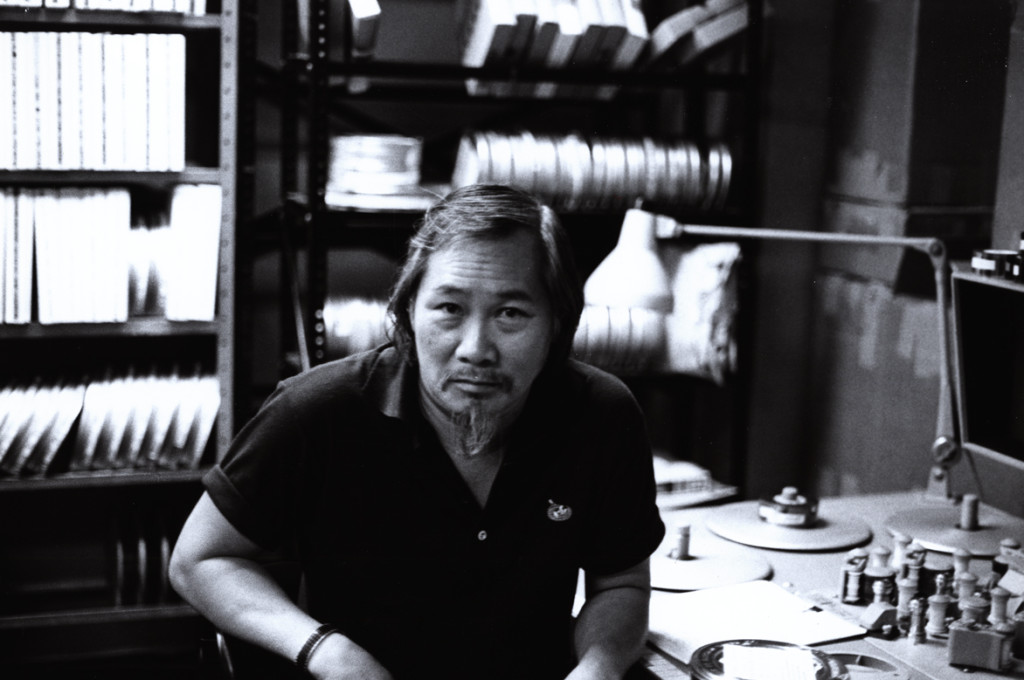 2
2
Harry Chang was a number 1 editor of animation in NYC prior to
his being hired by Dick WIlliams for this job. Harry maintained
his status, though they did pull an older editor out of retirement
to do the track readings. Max Seligsman was so
brilliant at the track reading that I still haven’t found anyone who
did the job as meticulously as he. His music readings broke all the
sounds of the orchestra down to color-coded frames. Unfortunately,
there were no photos of Max in this collection.
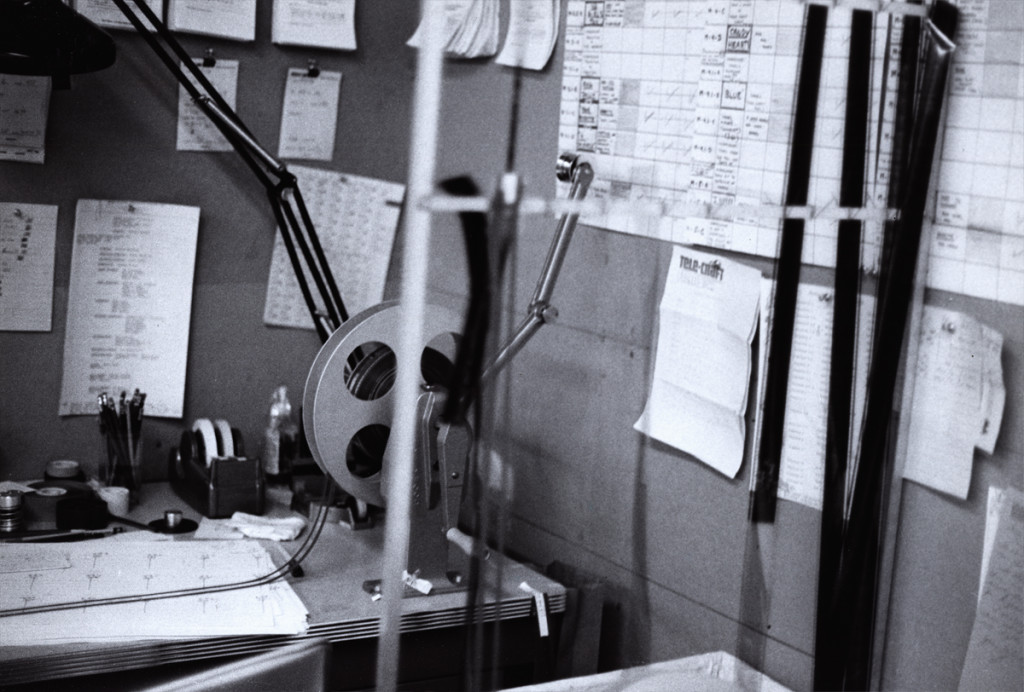 3
3
This is the editing table of the NY editor, and the film’s
lead editor, Harry Chang. He was very particular
and kept a very neat editing room. I often spent hours working
with him and Dick as we analyzed what was wrong with some of the
early animation scenes.
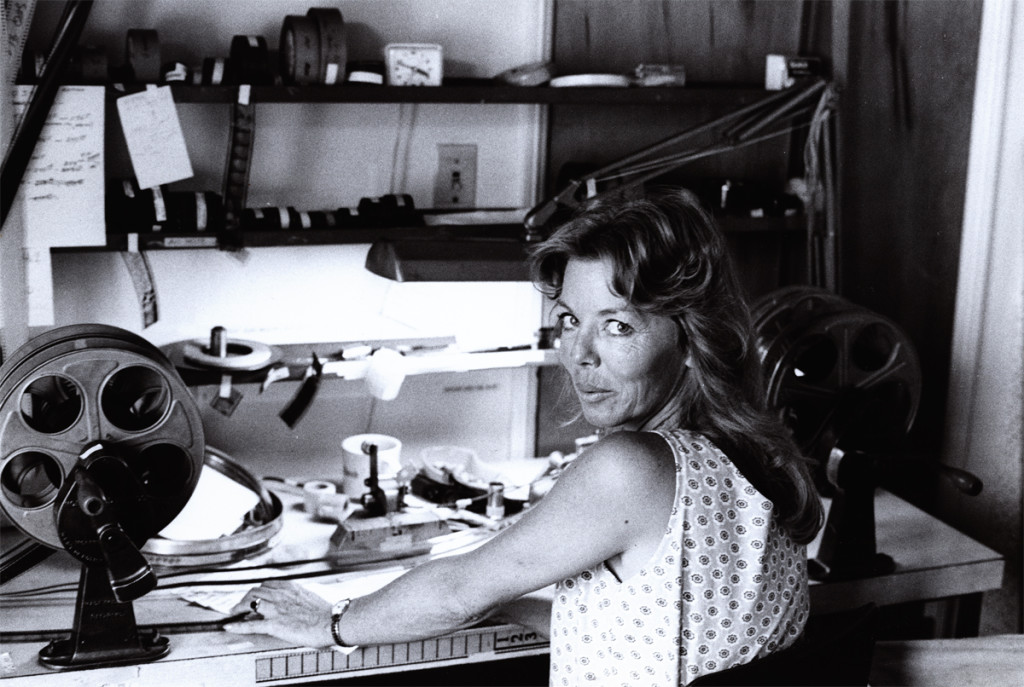 4
4
This is Lee Kent. She was the West Coast’s animation editor.
She came to New York toward the end of the production when
it was decided to house the East & West Coast Units under the
one roof. Lee had to work with Harry to get everything in sync
and in place for the ever-growing movie.
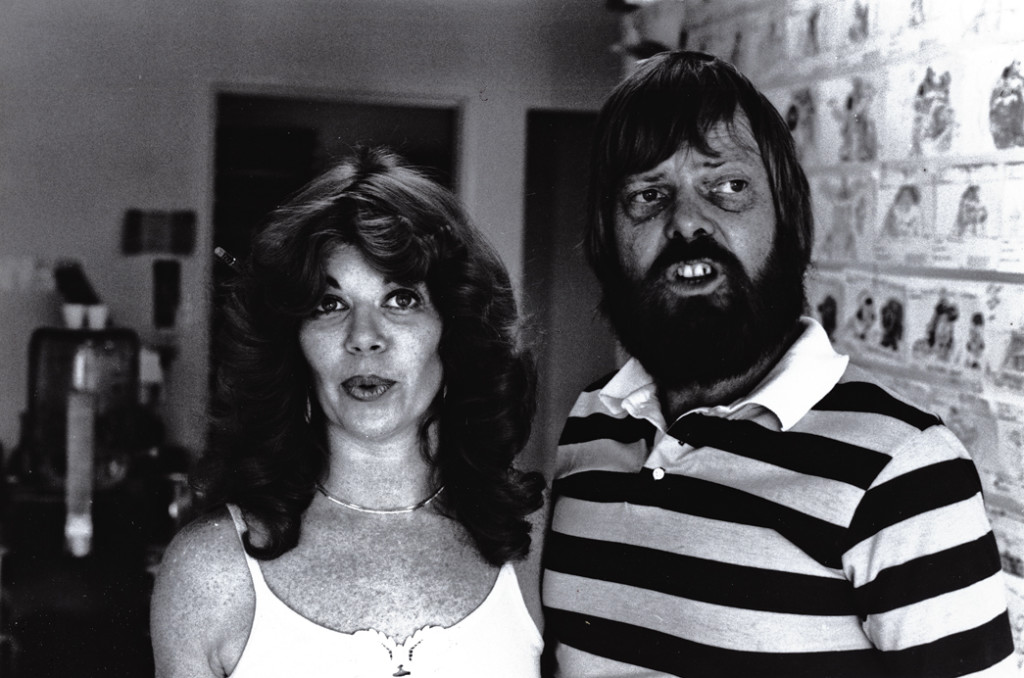 5
5
Paulette(assistant animator) and Charlie Downs (animator).
I looked forward to meeting Charlie. When Ward Kimball had
to pull a number of assistants up to being animators for
the Disneyland TV shows he had to rush out for Disney,
Charlie Downs was among that group. He made the rise just
slightly faster than he might have. There’s no doubt he was
ready for the promotion.
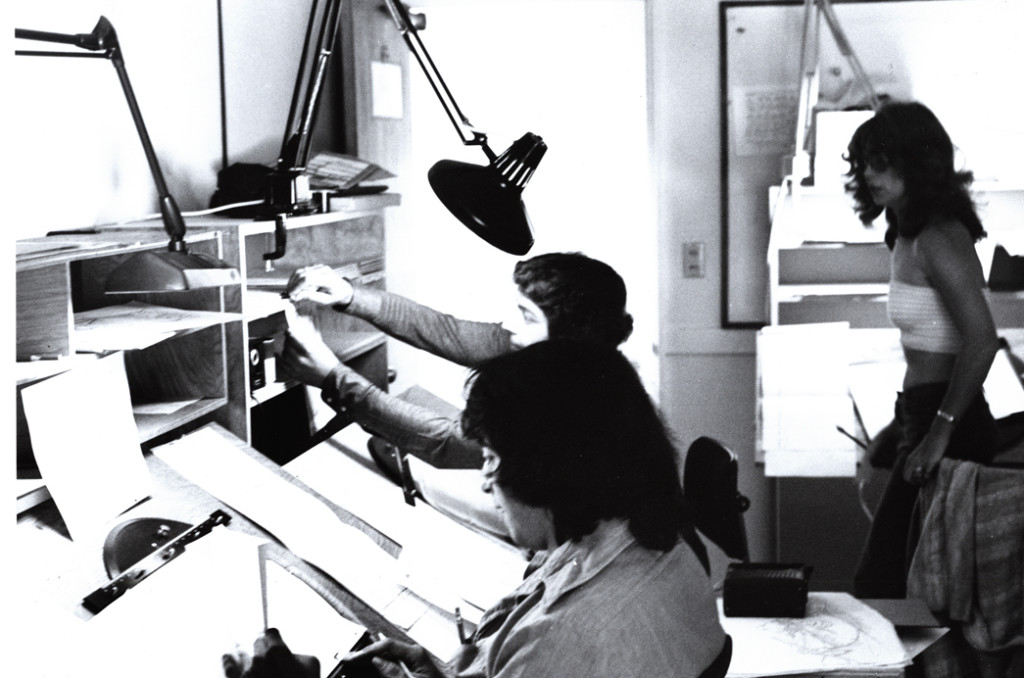 6
6
A photo from the West Coast’s group of people:
Animators Art Vitello (foreground) and John Bruno (middle),
and assistant animator, Paulette Downs (in rear).
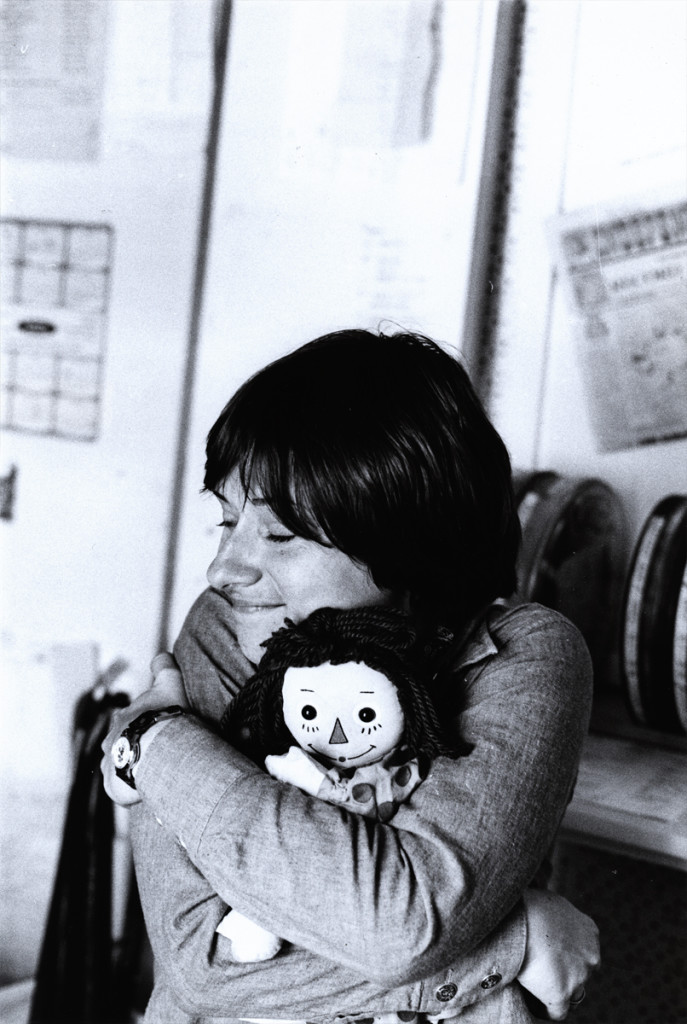 7
7
Animator, Crystal Russell rose quickly on Raggedy Ann. Her animation
style beautifully blended with Tissa’s animation of Ann & Andy.
Crystal became important for picking up many of the scenes that Tissa
couldn’t get to. She did many rich, ad strong scenes bringing a
lyricism to the work. Dick brought her to London on completion of
Raggedy Ann & Andy. She worked there for about six months before
heading back to LA where she did some great work on Lord of the Rings.
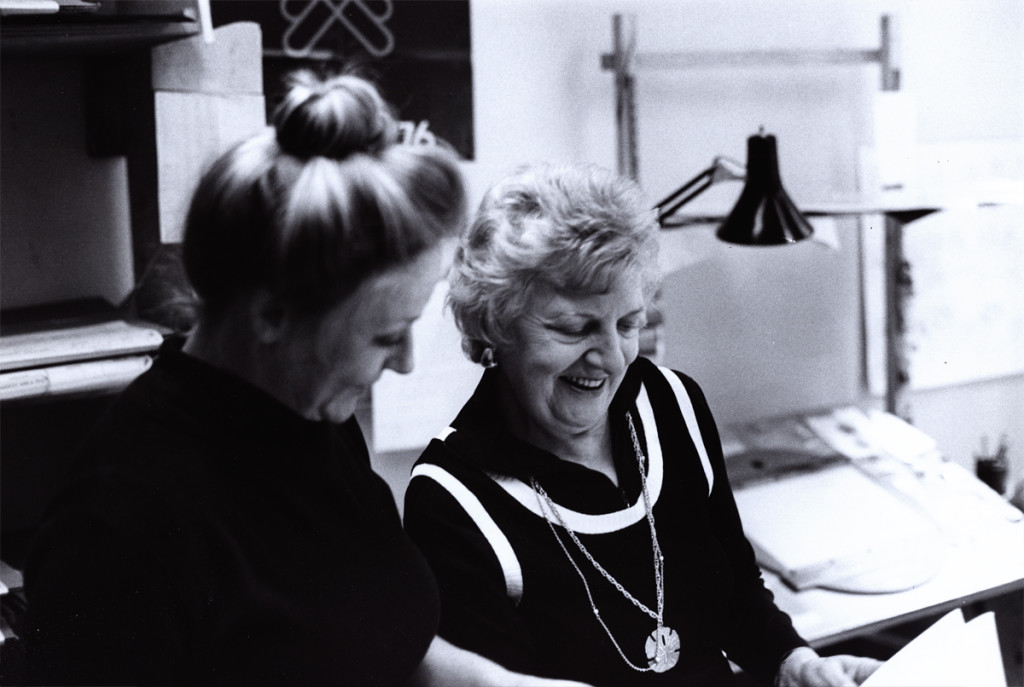 8
8
Ida Greenburg (right) and Nancy Lane (left).
Ida was the head of Ink and paint on the film. There were about
150 people working for her. Nancy Lane was Ida’s 2nd in command.
I had worked closely with Ida at the Hubley studio on a few
projects. I really liked her enormously and enjoyed going down
to the I&Pt det to help clarify some problems their checkers would
find. I’d spend about an hour or two there each day depending on
complications they’d locate.
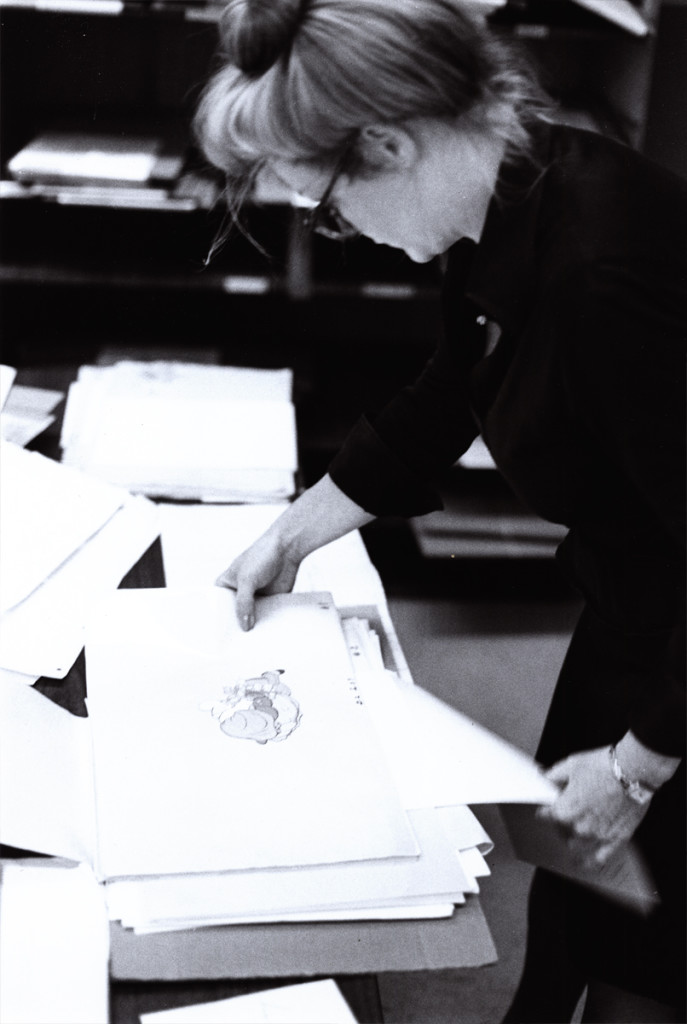 10
10
Nancy Lane. I’d been there when Nancy got her first promotion
to supervising a project. She was a real go getter who absolutely
took charge of anything job she was given.
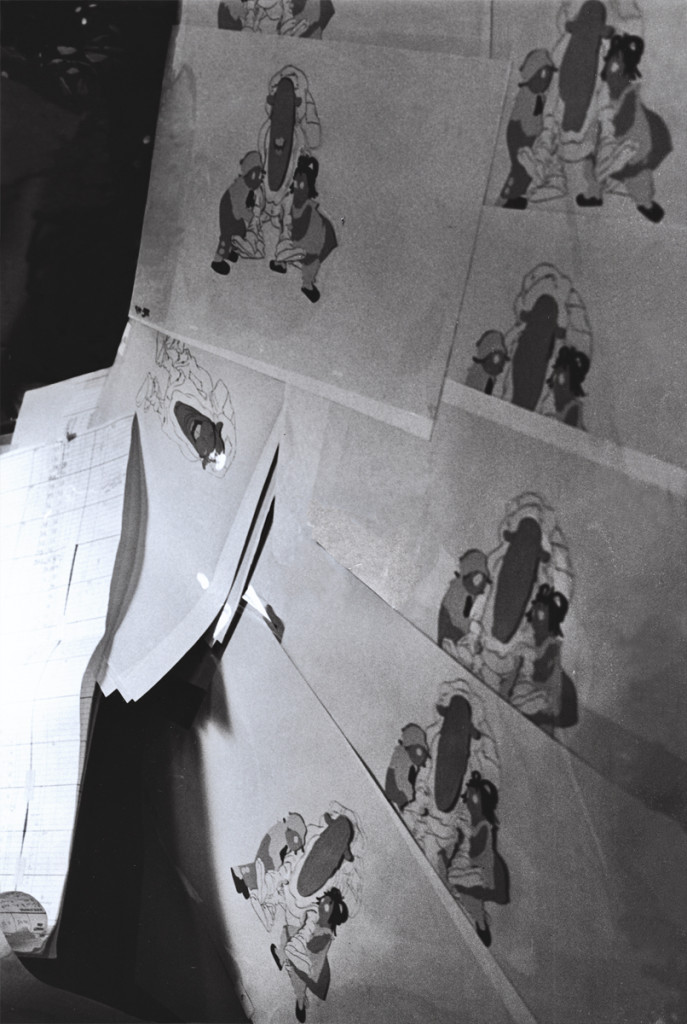 11
11
A wall of cels from Art Babbitt‘s sequence.
The Camel with the Wrinkled Knees. He also had bad feet.
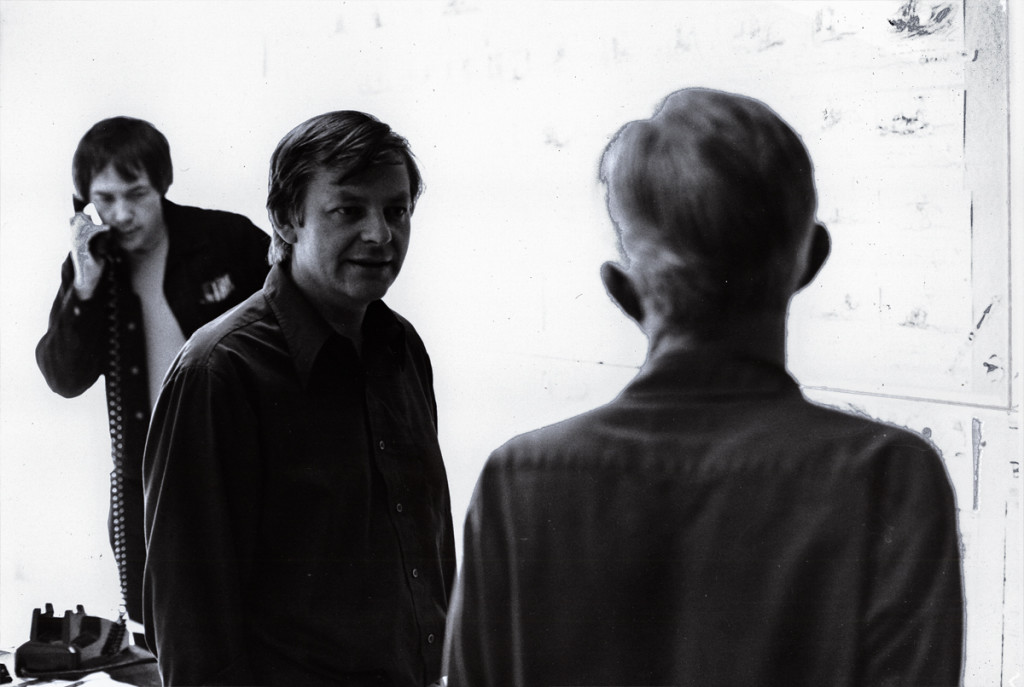 12
12
Art Babbitt with Dick Williams.
I always felt that they’d had similar animation styles. They
took different paths getting there, but the work was not too different.
That’s production manager, Carl Bell, on the phone.
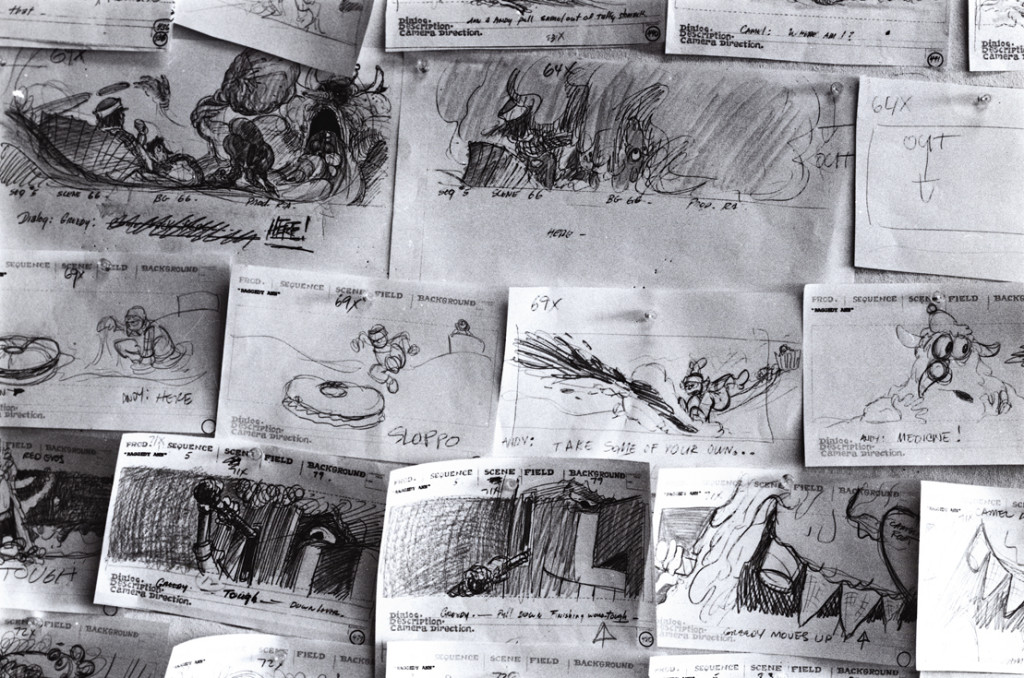 13
13
The storyboard. Andy has a problem in the taffy pit.
That was Emery Hawkins’ sequence. He only made one
short trip to NY, and I didn’t get to meet him. We
did speak on the phone a couple of times.
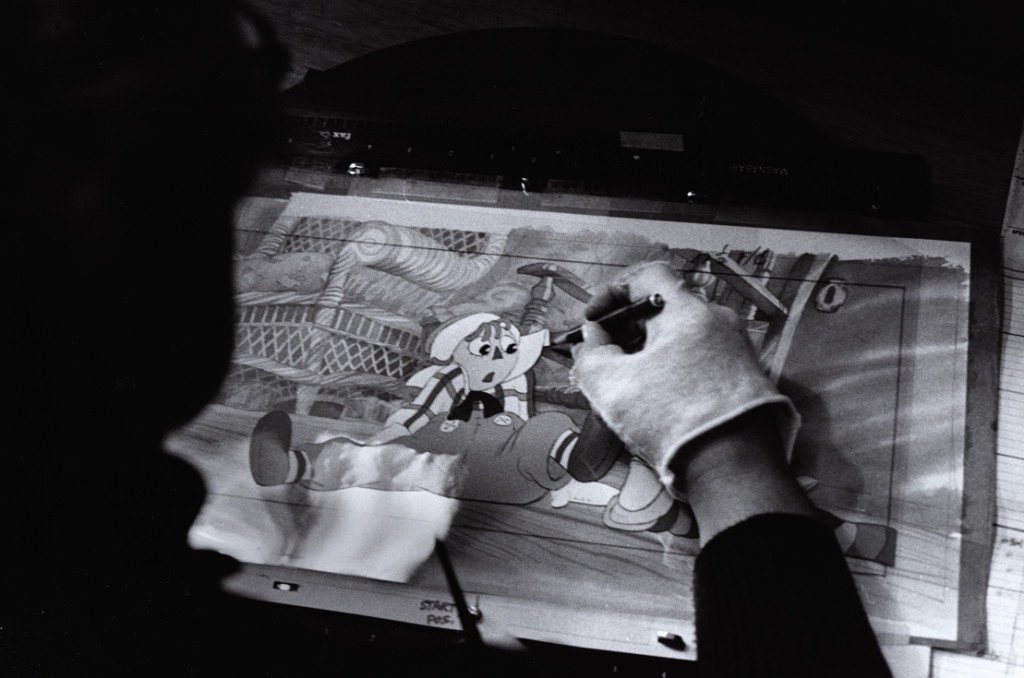 14
14
Andy lands on the floor to end a musical number. The days
when cels were painted. Here, an inker is doing touch up
work on the Xerox line. She’s using a “lumograph” pencil.
These pencils were able to draw on cel. Dick would animate
on cel with these pencils. This is what he used to animate
the Jovan commercial.
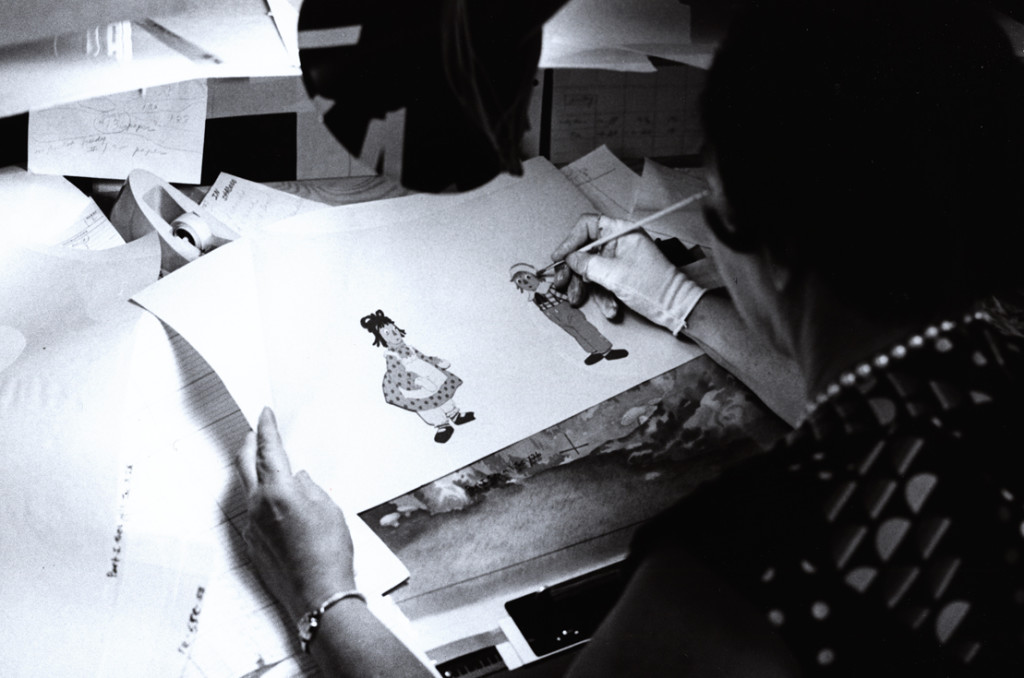 15
15
Here a checker makes a small touch-up on a cel.
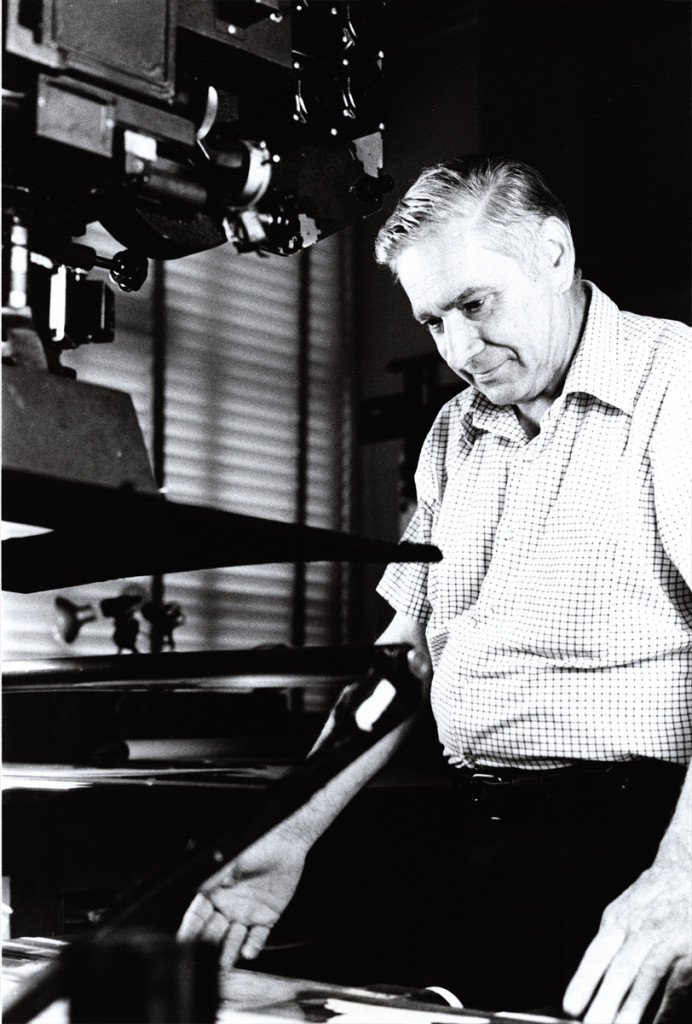 16
16
Here camera supervisor, Al Rezek, is shooting a scene
on the Oxberry camera.
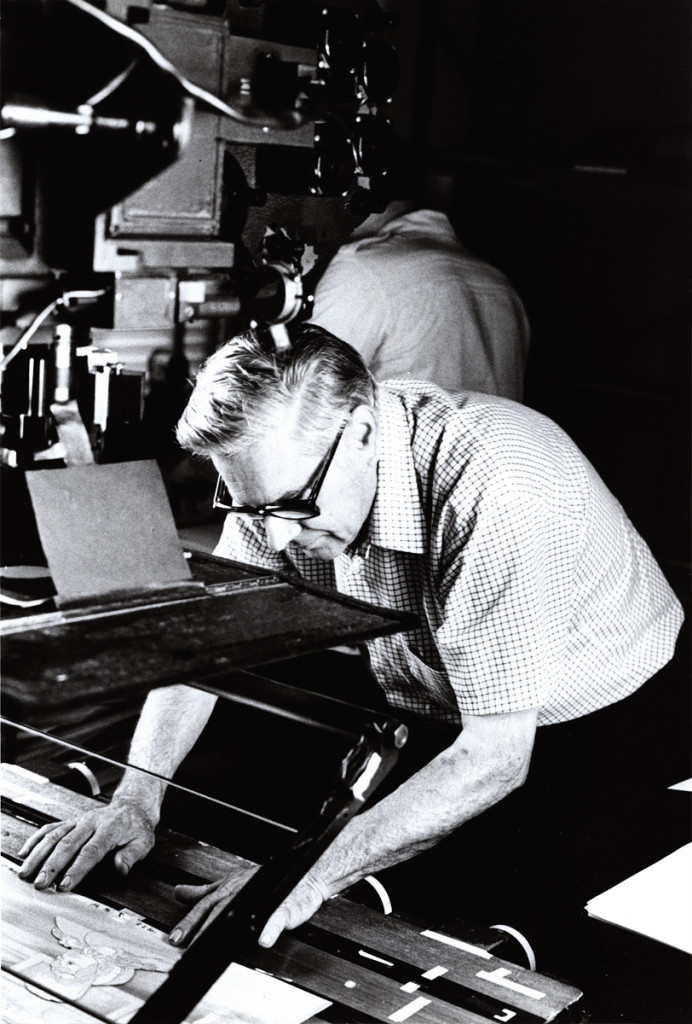 17
17
The camera was tricked out with a Panavision lens which was
rented from Panavision. At first there were a lot of problems
with the Cinemascope format, and a lot of tests were done for
the larger screen. However, when I saw it at a local theater.
They reduced the image and cut off the top and bottom.
Ultimately, the screen size was smaller – not larger.
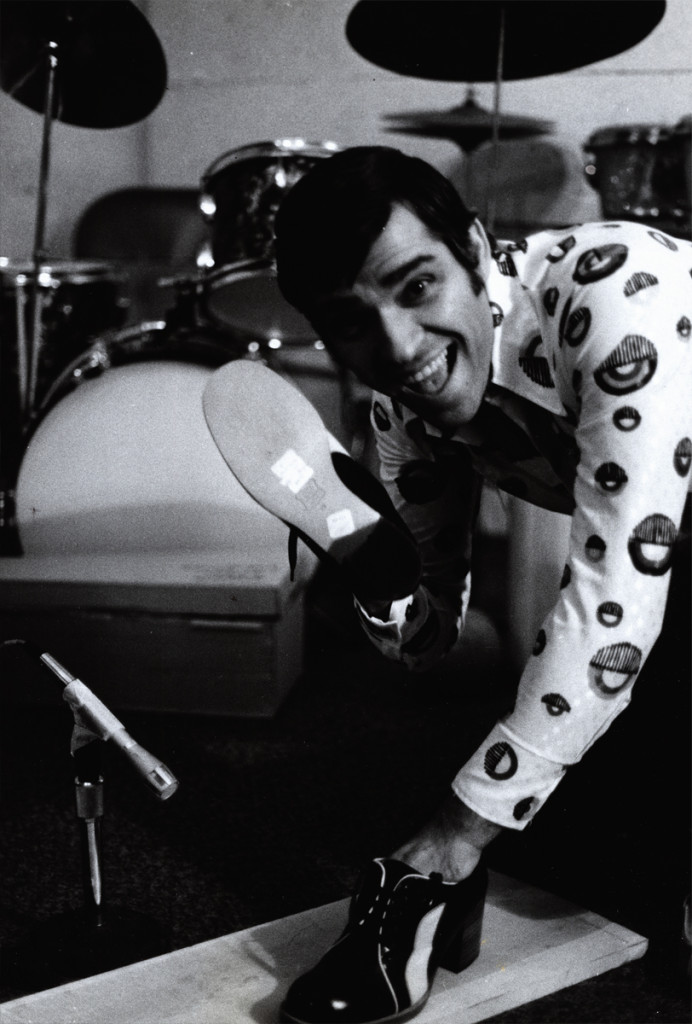 18
18
This is Jim Petries. He was this sound effects guy who
specialized in animation. He’d show up and would foley
the entire film on the spot in the mix studio. The film
makers got to watch quite a show a he pulled it off.
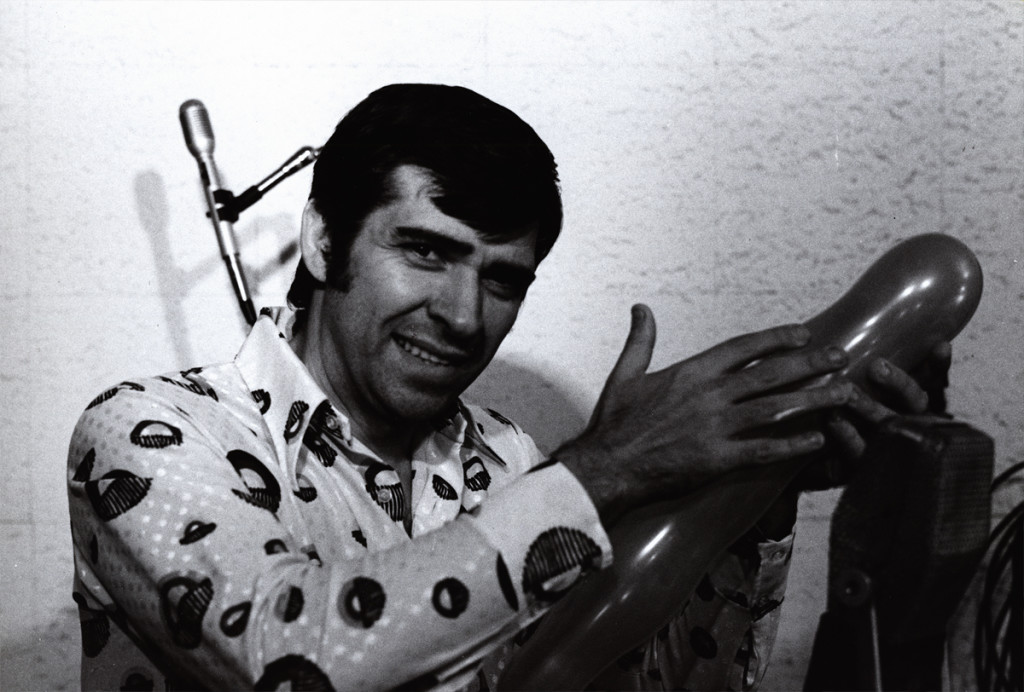 19
19
I believe Jim also did some work on Everybody Rides the
Carousel for John & Faith Hubley.
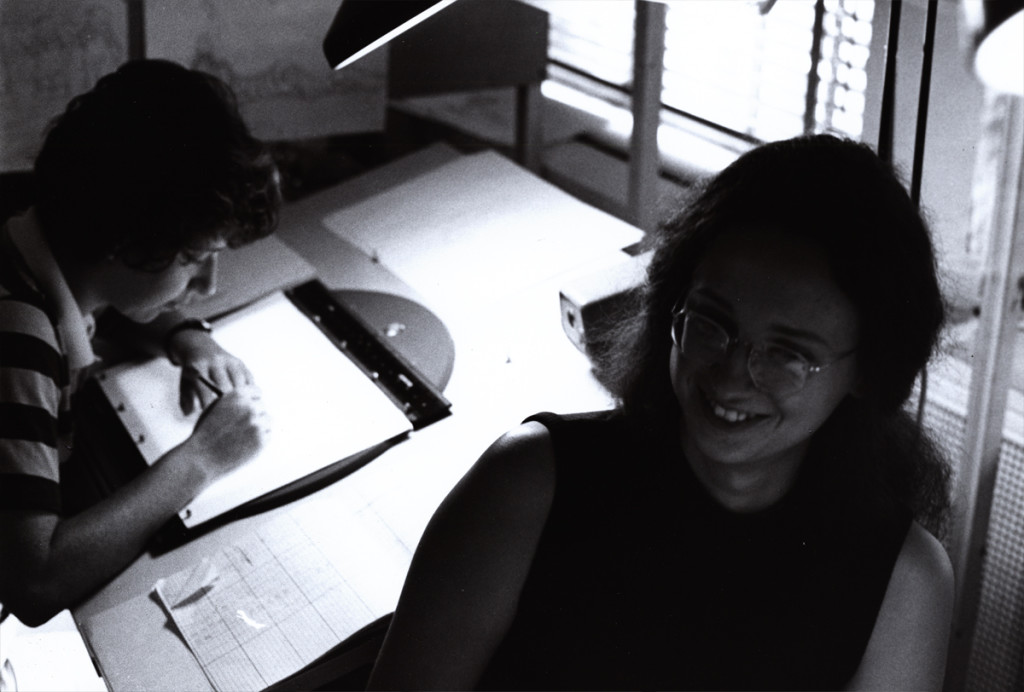 20
20
This shows two young inbetweeners that rose within the industry.
Mary Szilagyi is drawing at the desk, and Carol Millican is in
the foreground. Mary stayed in NY ultimately doing children’s books
and Carol went to the West Coast working for many studios.
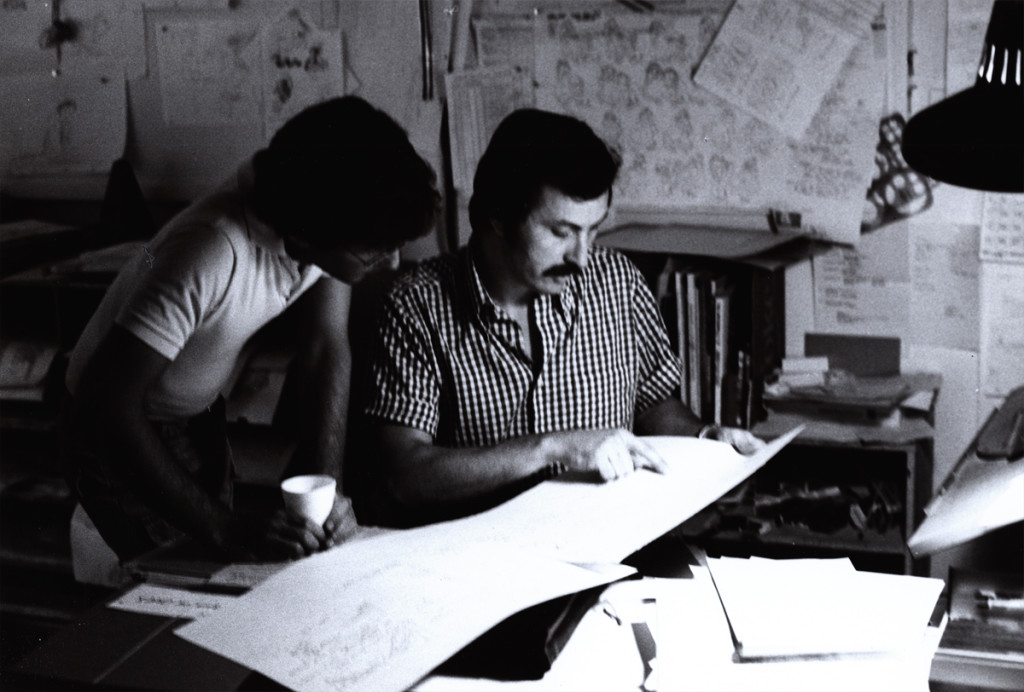 21
21
The Asst Director, Fred Berner, looks over the shoulder of
Associate Director, Cosmo Anzilotti. Fred left animation
and produced a number of excellent theatrical features before becoming the
lead producer on Law & Order: Criminal Intent. Cosmo went
out to the West Coast to take a lead position at Hanna Barbera before they
closed their doors. He helped during the transition period as the turned into
Turner Animation Studio. He retired notlong after.
They were both good friends. I still run into Fred every once in a while,
usually at Academy meetings.
Commentary &Independent Animation &Photos 11 May 2013 06:04 am
Lookout
- I’ve been trying to think of what the new version of The Great Gatsby reminds me of, and in a conversation with Heidi, she smack dab put her finger on it. There was a film, called Idlewild, done in 2006 by hip hop artists, Andre 3000. That was it. I was in love with that film and wrote an exuberant review. See here.
Idlewild was a rich looking, spirited film about the mob in the 1920s. The screen burst with rhythm and excitement frame after frame. Animated objects appeared everywhere in George Pal like additions.
The difference between the two films – Ixdlewild and Gatsby – other than about $100 million, and the throng of “AAA” celebrities like Leonardo DiCaprio is that Idlewild has a hell of a lot more imagination. The two equal each other in exuberance and style, and Gatsby is adapted from one of the great books of the 20th Century. I suggest you rent a copy of this 2006 film from Netflix or whoever before or after or instead of seeing Gatsby. As a matter of fact it’s time for me to see Idlewild again; I’ll rent it, myself.
Camp Levy
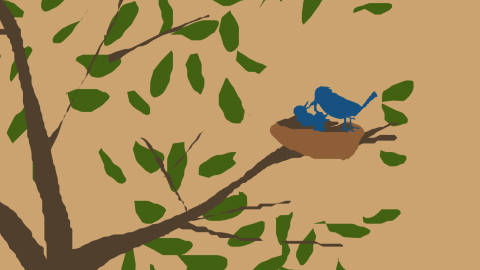 David Levy recently announced to the world that he’d completed a new film. This time it’s a half hour movie animated to the narrated storytelling of Bob Levy‘s (Dave’s father) story of his trip to camp. This was a service for inner city poor children. Dave’s father actually received supprt to go for several summers, and tells the story of those Camp outs. He had a full $8 to spend for the first summer, and plays it to the max.
David Levy recently announced to the world that he’d completed a new film. This time it’s a half hour movie animated to the narrated storytelling of Bob Levy‘s (Dave’s father) story of his trip to camp. This was a service for inner city poor children. Dave’s father actually received supprt to go for several summers, and tells the story of those Camp outs. He had a full $8 to spend for the first summer, and plays it to the max.
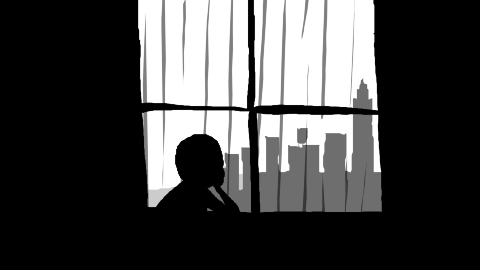 The film is the third, done in a strong graphic style and uses material from the memory of Dave’s father.The other two films David animated: “Grandpa Looked Like William Powell,†and “Turning a Corner,†both made an impression. This short, “Camp Story,” exploits the father’s narrative without taking too many animation curves. Howard Beckerman used to say there was full animation and “Limited” animation, but
The film is the third, done in a strong graphic style and uses material from the memory of Dave’s father.The other two films David animated: “Grandpa Looked Like William Powell,†and “Turning a Corner,†both made an impression. This short, “Camp Story,” exploits the father’s narrative without taking too many animation curves. Howard Beckerman used to say there was full animation and “Limited” animation, but  he’d discovered a third style – “Enough” animation. “Limited” when it can be and full when it has to be. This film is “Enough” animation. More of an iconic graphic trip, often depending on silhouttes to relay the story. Using bold colors and large solids, it uses its Flash animation to the max. (I’m pretty sure it’s Flash though it might have been done on Toon Boom.)
he’d discovered a third style – “Enough” animation. “Limited” when it can be and full when it has to be. This film is “Enough” animation. More of an iconic graphic trip, often depending on silhouttes to relay the story. Using bold colors and large solids, it uses its Flash animation to the max. (I’m pretty sure it’s Flash though it might have been done on Toon Boom.)
The sound track is a solo guitar that’s played pretty low on the track, so it’s particularly unimposing. I don’t hear many effects if there are any, so the track is somewhat simple. This helps put a focus on Bob Levy’s voice as he narrates the qiet story.
The film will succeed in many festivals. The story roams a bit telling of many summers he’d experienced. There are times when it takes a bit too long to get there, so my preference is the last of the shorts David did, “Turning a Corner.†But this is a fine addition to Dave’s library. He’s found his metier. I just wonder if the story supports the length. I have to give him credit, though. It takes some kind of fortitude and determination to come home from work daily only to start work on your animated film.
And to keep it up. As a matter of fact, Dave has me questioning my own enthusiasm. It’s time for me to put some energy out there as well.
Keep your eyes open for this movie; it’s a truly Independent film and needs support.
Daily Motion and The Congress
The last time I felt such inspiration was when I contemplated Yoni Goodman‘s daily animated pieces for his blog, the Dailymotion. Perhaps you’ll remember my excitement for Mr. Goodman’s daily animated tests which he offered us. Anyway, his output was so inspiring it actually had me doing some personal animation. Unfortunately that didn’t last long enough to be productive.
I wondered what has happened to Yon Goodman’s “Daily Motion” pieces, so I went back.
He was the animation director for the Israeli feature, Waltz with Bashir. His blog was a way for him to keep it going for himself. It turns out, Mr. Goodman has been the animation director for another feature film, The Congress. This film will make its debut at Cannes this coming weekend. You can see some stills and get some information here.
It’s half animated and half live action. Stars include Robin Wright, Paul Giamatti, Jon Hamm and Harvey Keitel. It’s an animated adaptation of Stanislaw Lem’s novel “The Futurological Congress”. (From thte short synopsis I’ve read, this sounds like a very imaginative idea for a film.)
It’s another good film to watch for; one that was done in 2D. (Only in America are they afraid of that medium.)
A Public Reading of an Unproduced Screenplay
About the Death of Walt Disney
Yes, that is the title of the play which opened yesterday at the Soho Rep. A Public Reading of an Unproduced Screenplay About the Death of Walt Disney was written by Lucas Hnath and the play was directed by Sarah Benson, the artistic director of the Soho Rep. The show stars Larry Pine as Walt Disney. The actor has performed in many films and plays, usually as a positive role model of a character. Yesterday’s review in the NYTimes, by Charles Isherwood, takes the play to task for re-imagining Walt as someone impatient to prop himself up into someone more important 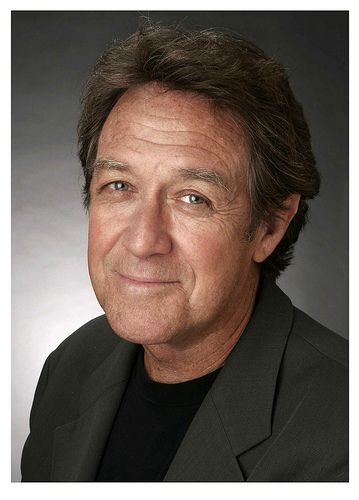 than he is. “. . . Walt is not “one of the most important people who ever lived,†as he grandiosely aspires to be, but just a mortal like anyone else. While apparently devoting his public life to bringing pleasure to millions, Mr. Hnath’s Walt Disney had a horror of being considered one of them.”
than he is. “. . . Walt is not “one of the most important people who ever lived,†as he grandiosely aspires to be, but just a mortal like anyone else. While apparently devoting his public life to bringing pleasure to millions, Mr. Hnath’s Walt Disney had a horror of being considered one of them.”
The show is completely sold out for its limited run (likely these are subscribers who knew of the show in advance and pre-bought tickets as part of a package.
It’ll be interesting if they do a filmed version of this play. I wonder what the rights are to such a thing. There’s a book I always thought would make a good film about Walt: The Oranging of America by Max Apple.
Larry Pine as “Walt”
More information about the play can be found here.
Coming Soon
I thought I’d give you an idea of what I’m planning for the coming week.
- We’ll complete the Raggedy Ann photos which finish John Canemaker’s collection of images he shot for this book, The Animated Raggedy Ann and Andy
- We revisit Norman McLaren with some odds and ends that he wrote in the last years of his life. Of course, he was a smart erudite guy right up to the end, and I believe that comes across in this writing.
- We’ll also look back at the career of Lilian Friedman Astor, the first woman to have animated in a major U.S. studio. From 1933-1939 she worked for the Fleischer studios, and we have a list of all the scenes she did. Perhaps we can showcase some of them.
- And we’ll begin to look at the Frank Thomas & Ollie Johnston book, The Illusion of Life. Bo do I have a couple of problems to discuss with these two masters.
- And of course there will be some surprises in store for both of us.
John Canemaker &Layout & Design &Models &Photos &Rowland B. Wilson 05 May 2013 05:55 am
More Raggedy Ann Photos – 2
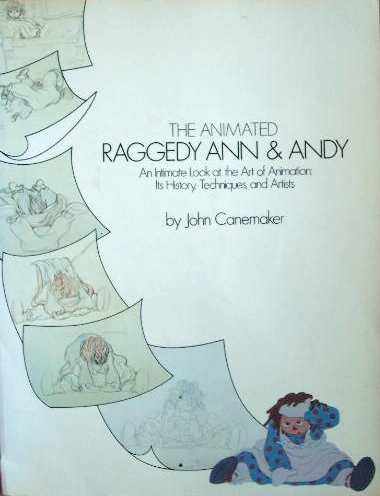 - Last week, I posted a stash of photos taken by John Canemaker for the book he wrote called, “The Animated Raggedy Ann and Andy.”
- Last week, I posted a stash of photos taken by John Canemaker for the book he wrote called, “The Animated Raggedy Ann and Andy.”
John Canemaker took all the photos, himself, which led to a more intimate look at an animated film. There were no photo decisions by committee; it was decided to use a photo if it told the story John was trying to relay. For that reason, the book really is one of the best “Art of . . .” type books on the market. (I’m not just saying that because there were photos of me in there – though that would be a good reason, too.)
The book was as exciting – in the making – as was the film. Too bad at the last minute the train of a film ran wildly off the tracks. In a way, I wish the book were written after the film was completed so that we could read the true story of what happened in those last six months of chaos.
The decision was slow in growing and fast when it finally fell, that the movie was enormously over budget. I was in on all the morning production meetings where managers and supervisors and directors would all meet. Those had started off nicely, at the beginning of the film, and went insanely wrong before long. There was the time when I was ordered to fire – that day – two inbetweeners. I was told that we had to give the staff a lesson that they had to work harder. (That might have been hard to do since everyone was giving it their all.) It so happened that one new inbetweener, on her first scene, ignored my instructions (and her immediate supervisor’s) by erasing all of Jack Schnerk‘s drawings. She felt she could animate the scene better, and she set out to prove that.
One down. The second person to fire was someone I was told (by Dick Williams, himself,) that I had to fire. It was obvious that there was a personality conflict since the guy was a great artist and definitely someone who should have stayed on. I was able to arrange for him to be switched to the BG department, thus fired by me from doing inbetweens and hired by them, in the same day, to do watercolors. He continues on, even today, working at a top position in design at Blue Sky. I don’t know about the woman, but I hope she gained a little humility that day 30-something years ago. That story didn’t make it into the book.
What there was in the production was a great first year of production where the art of animation was treated in its highest form. We were all out to make the greatest film of all time and bring it to the big screen. We had some of animation’s finest animators gathered to work on it. Assistants and Inbetweeners in New York were offered classes, after hours, which tried to teach animation to the new. With teachers like Tissa David and Art Babbitt and more experienced Assistants; a lot was conveyed. I was usually too busy to make it to many of these classes, but I always kept a close eye on what was taught. It really was fun and incredibly valuable to many of us.
At some point along the way, the LA studio was closed and key people from there came here. All of our space was overcrowded and uncomfortable. The Xeroxing in NY, a sweet grey line that took a while to construct, was replaced by a thick back line, when management sent work to Hanna-Barbera to outsource the xerography and some of the painting. Shadows were eliminated. Color copiers were rented. Scenes that had been animated in a non-photo blue pencil on 16 fld paper were being copied and reduced, at the same time, in B&W so that they could use 12 fld cels to color the art. A penny saved is a penny gained; I guess. This meant that a number of my inbetweeners were used to put 4 sets of crosses on the animation drawings so that there’d be some form of registration on the reduced artwork. Certainly the registration went all to hell in the process, thus allowing the latter half of the film to have a lot of slippage on the big screen. Lots of weaving animation in scenes that were rushed.
Emery Hawkins‘ amazing taffy pit took a big hit when it was animated more like a limited animation movie. All that beautiful rolling motion Emery had created on the cinemascope screen suddenly hits the wall and stasis sets in. The film was never going to be a classic of he silver screen, but it should have been a hell of a lot better.
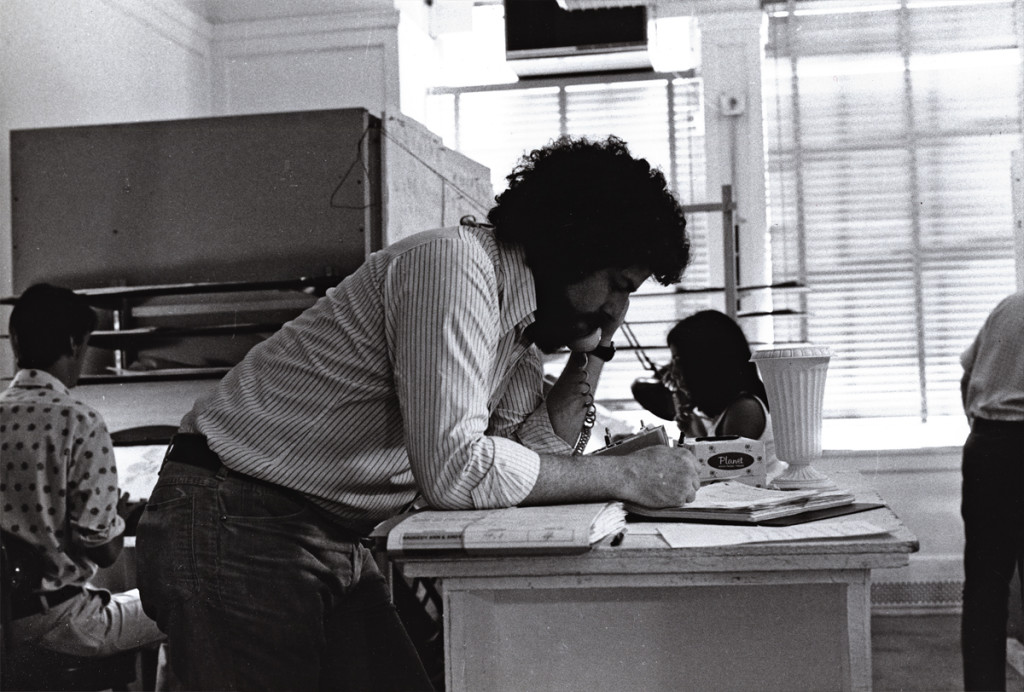 1
1Here I am doing what I did most of the day.
I talked on the phone. Ennervating stuff.
A young Kevin Petrilak is in the rear left. He was an inbetweener
in the Taffy Pit. Dan Haskett ran that group of people.
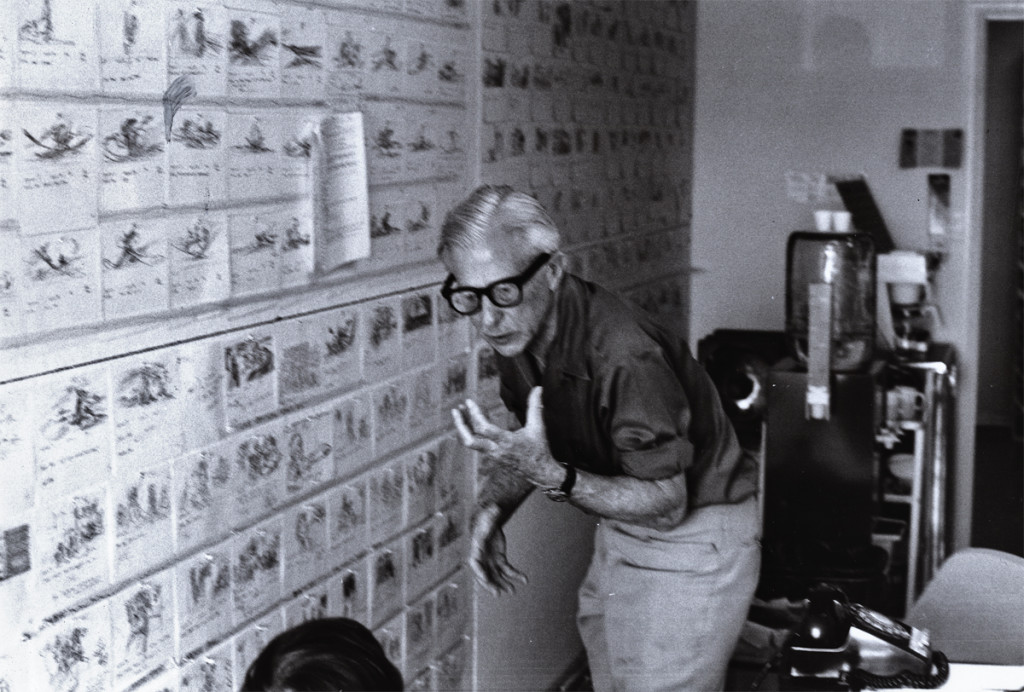 2
2
Here’s Art Babbitt teaching. He loved doing that. Dick tried to
recreate the classes he’d had in London a couple of years earlier. We – all New York -
sure appreciated the two weeks of lessons. I have Dick’s notes from these sessions.
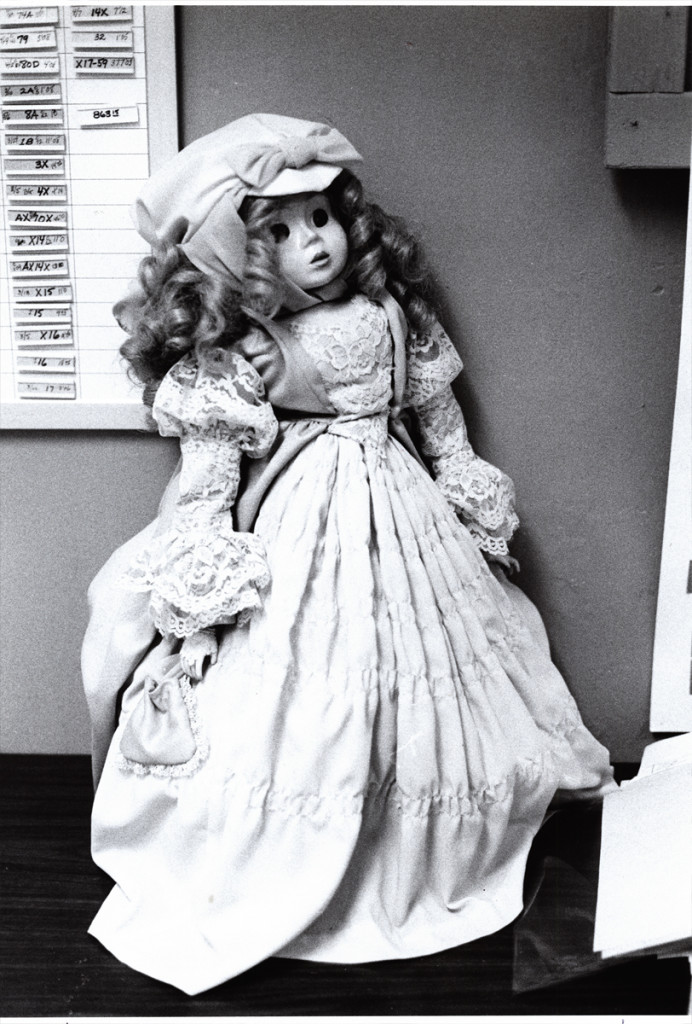 3
3
This is a beautiful doll. Babette. She was at the film’s center.
The Pirate kidnaps her and takes her to sea. Raggedy Ann & Andy
take off in pursuit of her to bring her back to the playroom.
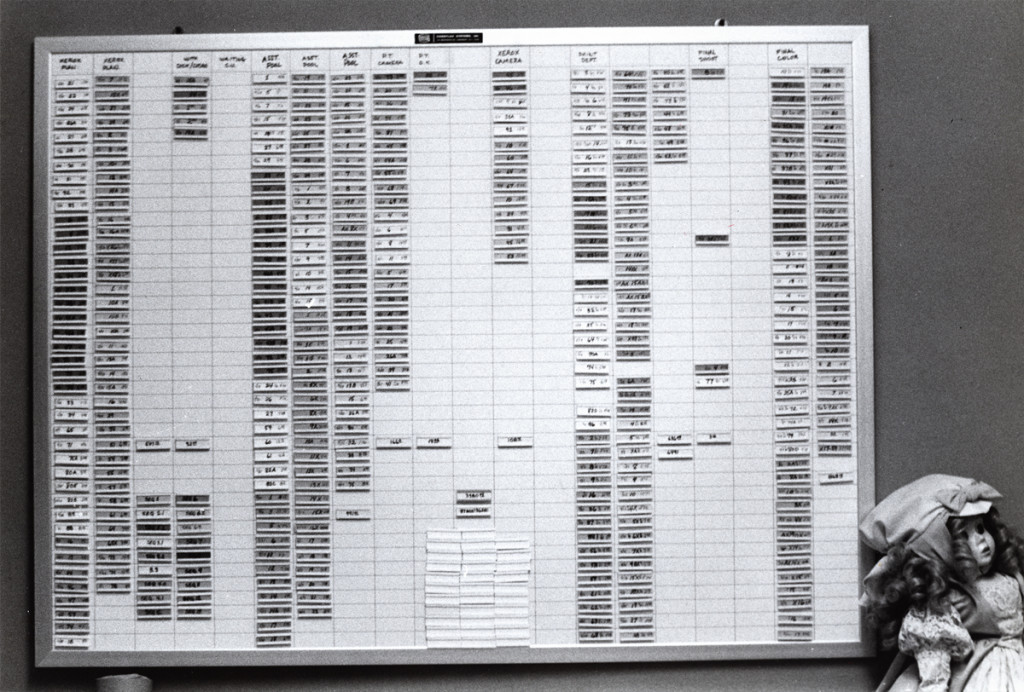 4
4
This is a wall of stats. It represents footage counts produced in
every department working on the film. This hung in Mike Sisson’s office.
He was the production manager who tried to usurp the entire production.
A couple of weeks before everything changed, managerially, on Raggedy, Sissons
approached Cosmo Anzilotti and me at lunch. He saw us at the restaurant and came
over to us. He wanted to lead a take over cutting Dick out of the film and
putting Cosmo in to finish directing the film. I’d be made Cosmo’s assistant.
I had no intentions of being another Iago, and said as much.
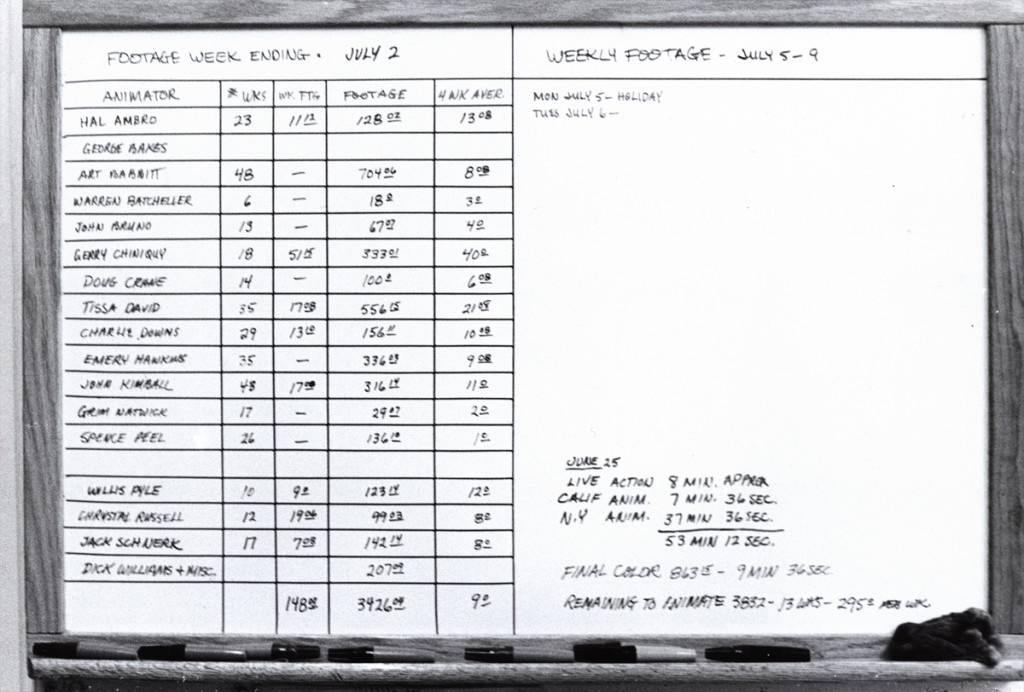 5
5
This chart covered the animators footage counts. A running record.
I told Cosmo that Dick had brought me onto the film, and I’d do anything for
him. If it meant leading a large group to quit the show, I’d do that. Cosmo
seemed relieved. He wanted to do the same and we both told Sissons how we
felt. He greeted our news with an ass’ smile and thanked us. We were no
longer on the winners’ side, and I watched closely to know when to exit.
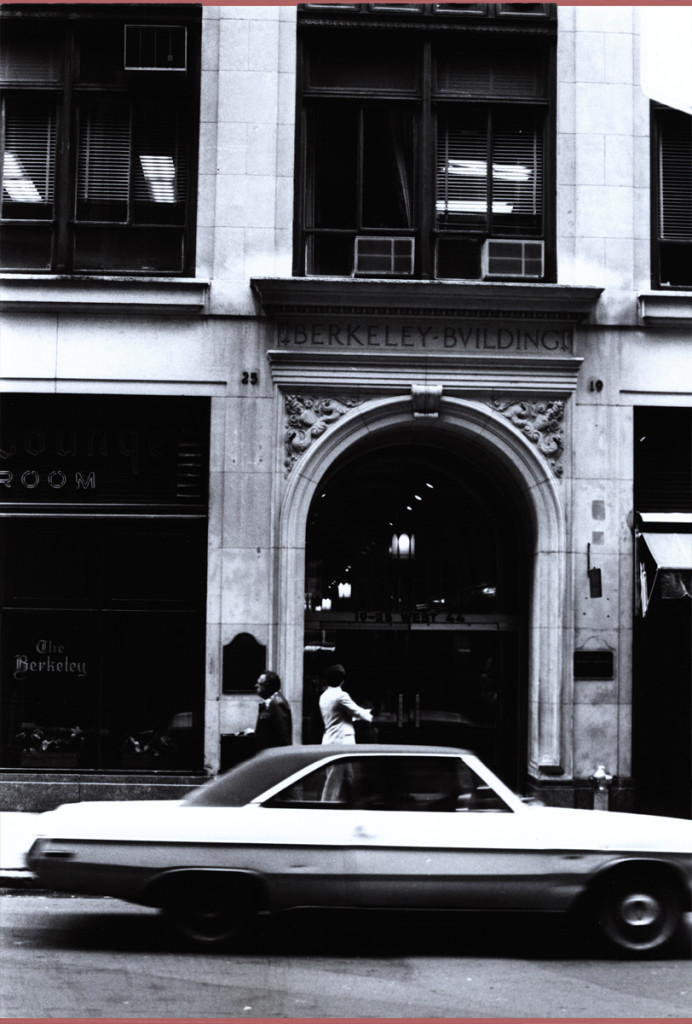 6
6
This was where the NY headquarters were planted. In the middle of 45th Street.
Most studios in the forties and fifties had places on 45th Street. Paramount,
Hal Seeger’s studio, lots of other smaller studios such as Pablo Ferro or Ray Seti’s.
![]() 7
7
Didi Conn was the actress who voice Raggedy Ann. When the VOs were coming
to an end, Didi worked late and her mother was with her. They needed help
getting home (Long Island.) The mother was afraid to drive. I volunteered
and drove them home. I took the Long Island Rail Road back to the City.
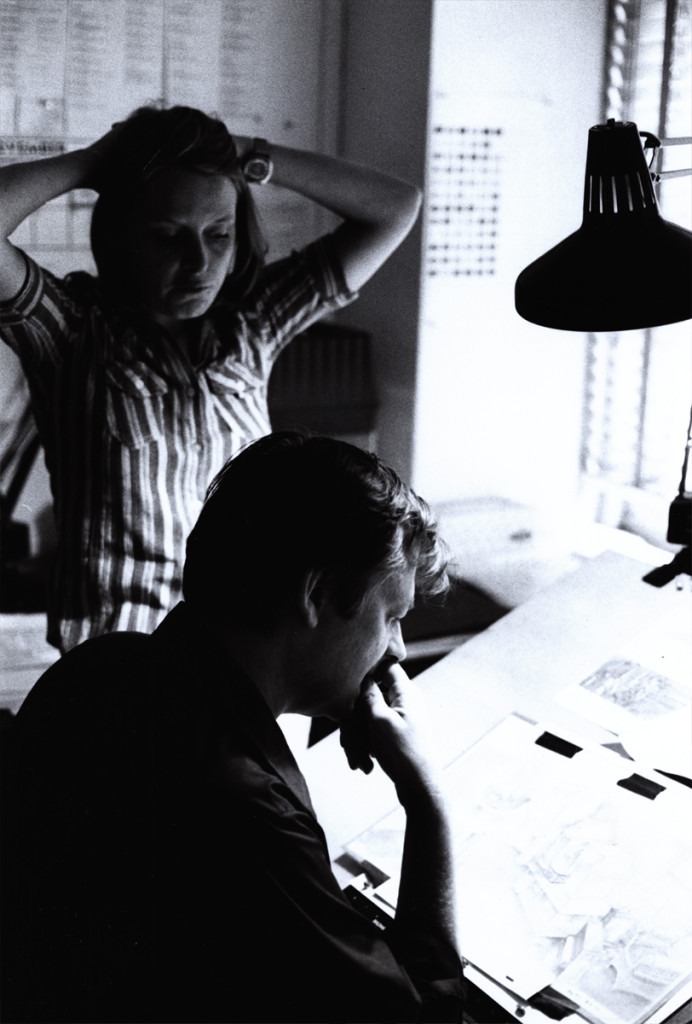 8
8
This is Sue Butterworth with Dick Williams. She was the watercolorist who
led the BG department and designed the wc style of the film. I thought her
work a bit inconsistent and often lacked the dynamic look good BGs require.
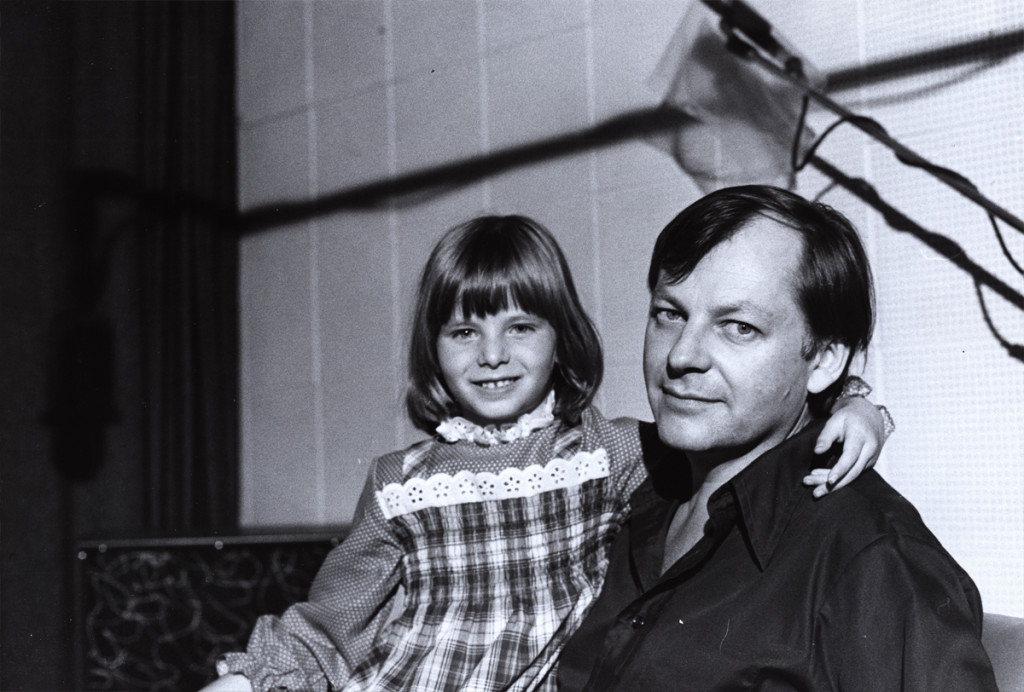 9
9
Here’s a picture of Dick Williams with his daughter,Claire.
Claire played the part of Marcella, the little girl at the film’s start.
They shot the live action in Boonton, NJ during the first days of the
production. All those hours they were out filming, I watched the shop.
Alone in an enormous darkened most of the time in the enormous office,
I could only spend time reading and rereading the script and sketching
my idea of some of the characters.Infrequently, the financial manager
of Lester Osterman Prods., the production company, would pass through.
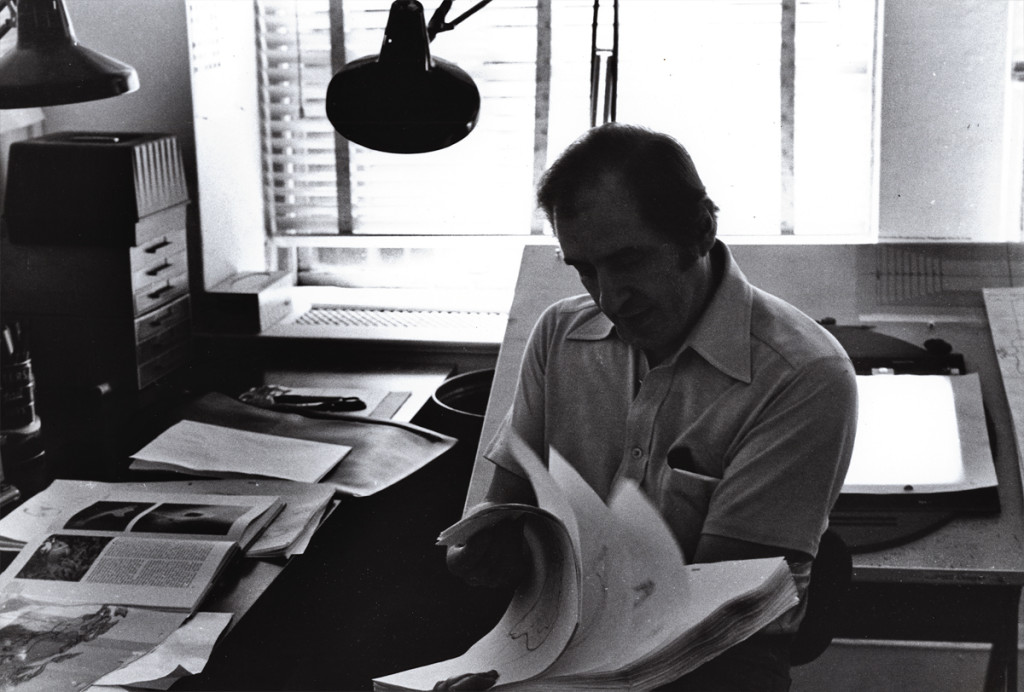 10
10
George Bakes was a fiercely independent animator who worked a short
while on the film. He must have started at Disney on Sleeping Beauty. He’d often
show a lot of Milt Kahl drawings he’d had from that film.
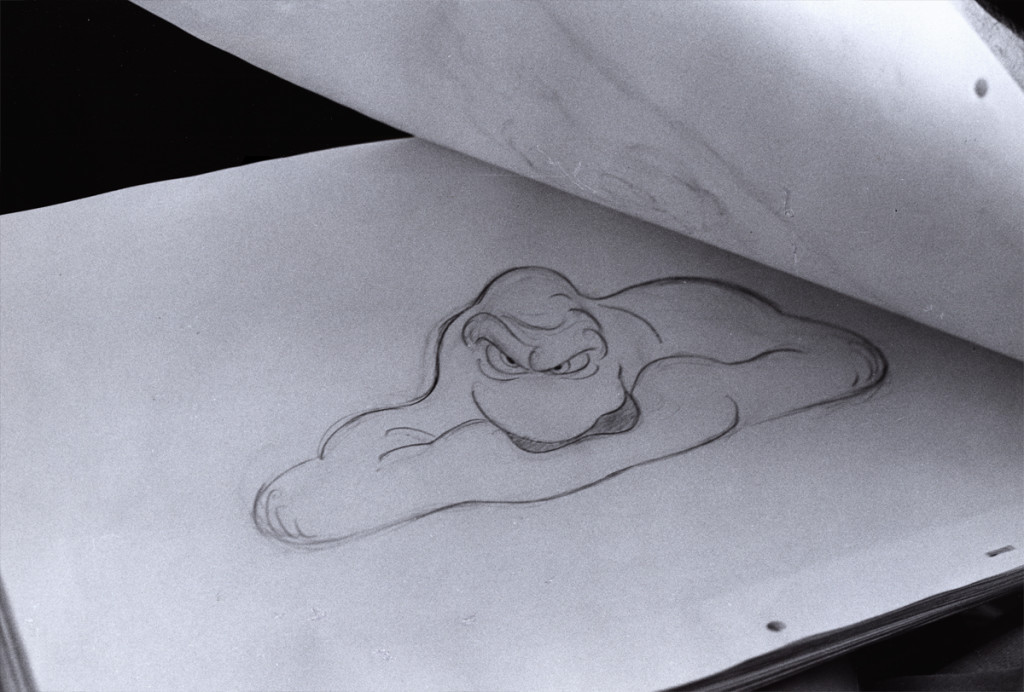 11
11
Baskes animated many of the cereal commercials of the day -
Trix, Honey Bee, Sugar Crisp bear, etc. For Raggedy he did the “gazooks.”
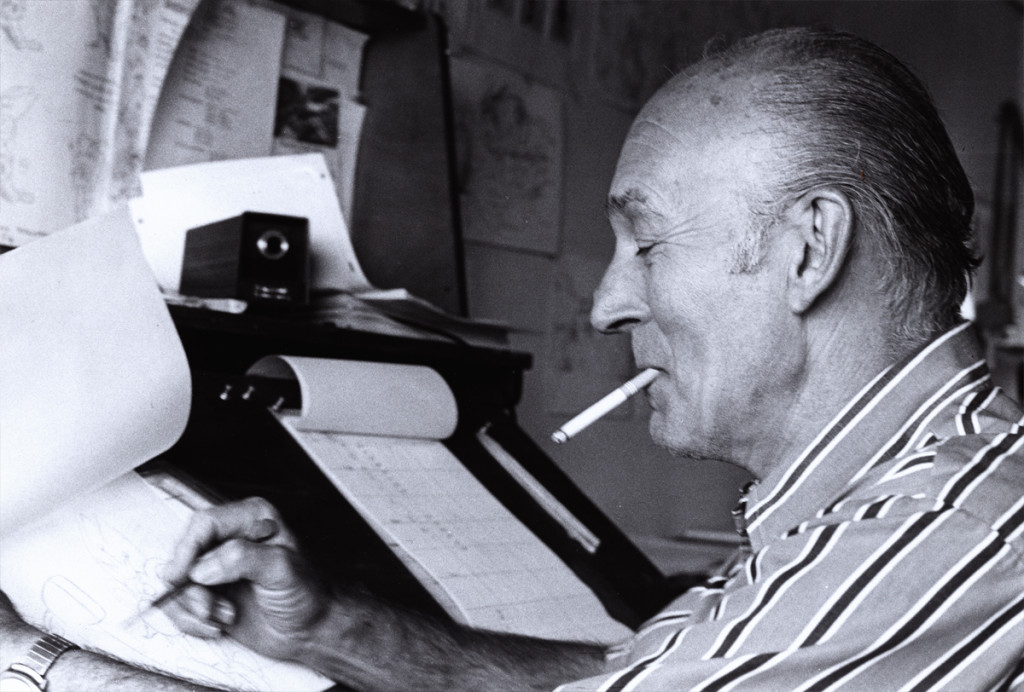 12
12
Gerry Chniquy was a brilliant animator straight out of WB.
He’d done a lot of Yosemite Sam animation for Friz Freleng.
It wasn’t far to go to cast him as the blowhard of a King, King Coo Coo.
Marty Brill voiced the character. Gerry Chiniquy,of course, did a fine job,
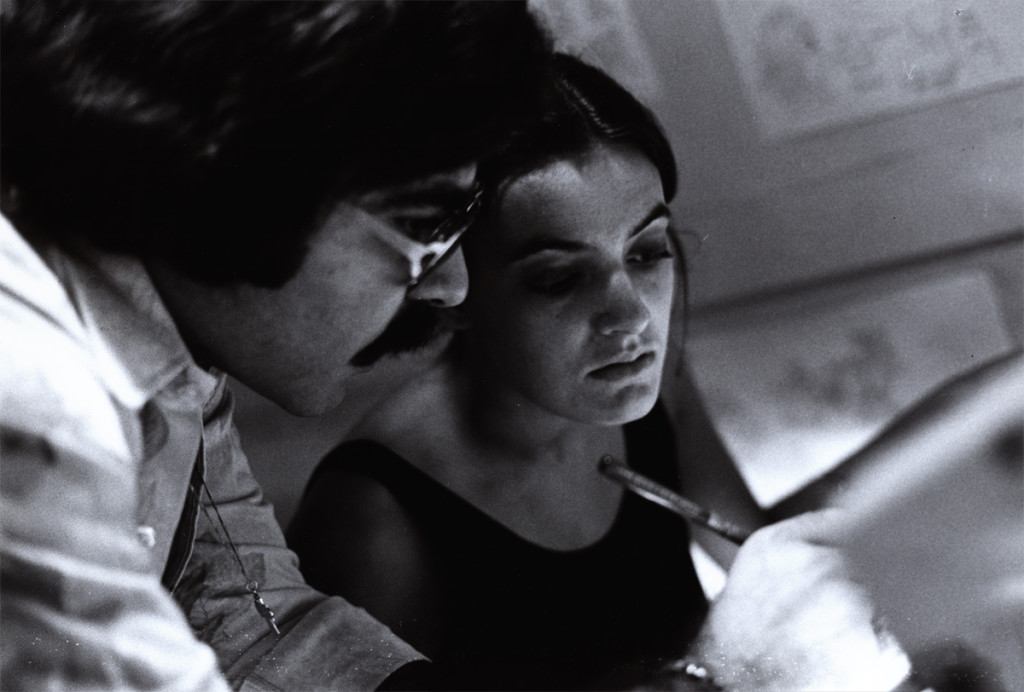 13
13
John Celestri had a style all his own although he idolized Bill Tytla.
Not a bad person to pick for a role model. John was an Assistant on
the film. Here he’s working with inbetweener, Amanda Wilson. Amanda was
the daughter of the great cartoonist and animation designer, Rowland Wilson.
The last of these photos will come next week. Many thanks to John Canemaker for the loan of the images. Any opinions tossed about here, are all mine and John is not to blame for them.
Books &Commentary &John Canemaker &Photos 28 Apr 2013 05:55 am
Raggedy Ann Photos
- John Canemaker recently loaned me a stash of photos of the Raggedy Ann crew. These were pictures that were used in his book on the “making of”. It was a better book than movie (as they often are). There are also some photos that didn’t make it to the book. John Canemaker shot all the photos, himself and all copyright belongs to him.
I thought I’d post the pictures and add some comments that pop off the top of my head. Hopefully, a couple of interesting stories will show up in my memories.
There are enough photos that it’ll probably take about three posts to get them all in. The next two Sundays are booked, I’d guess.
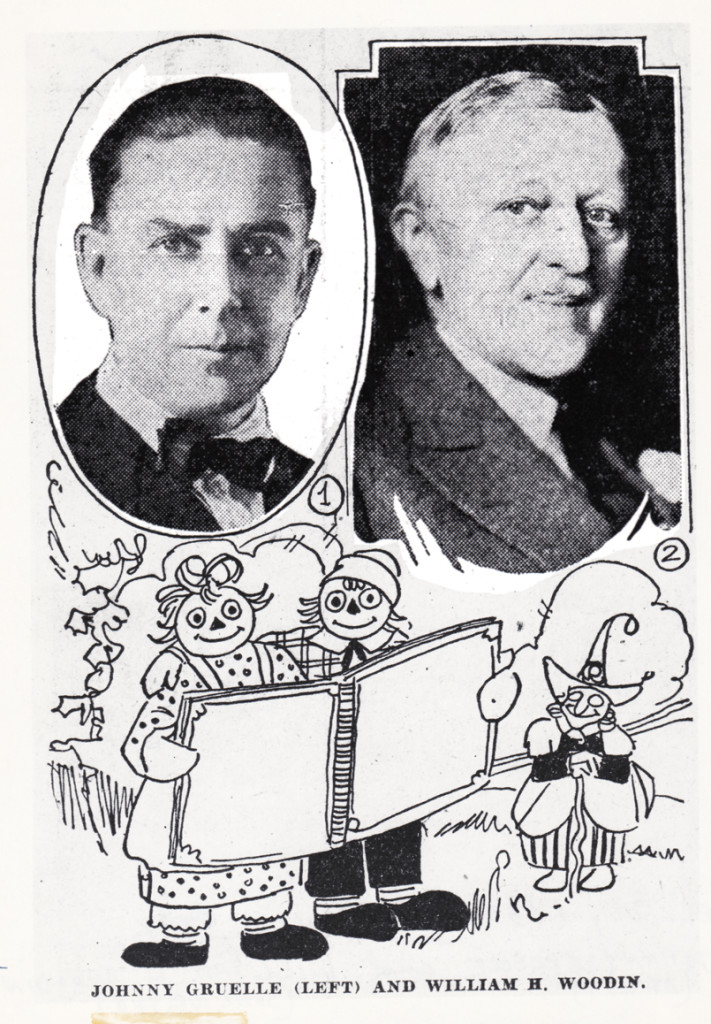 1
1Johnny Gruelle (artist, writer) and William H. Woodin (song writer)
Dec.28, 1930 Indianapolis Star – “Raggedy Ann’s Sunny Songs”
This was apparently a theatrical piece Johnny Gruelle
put together with his very successful characters.
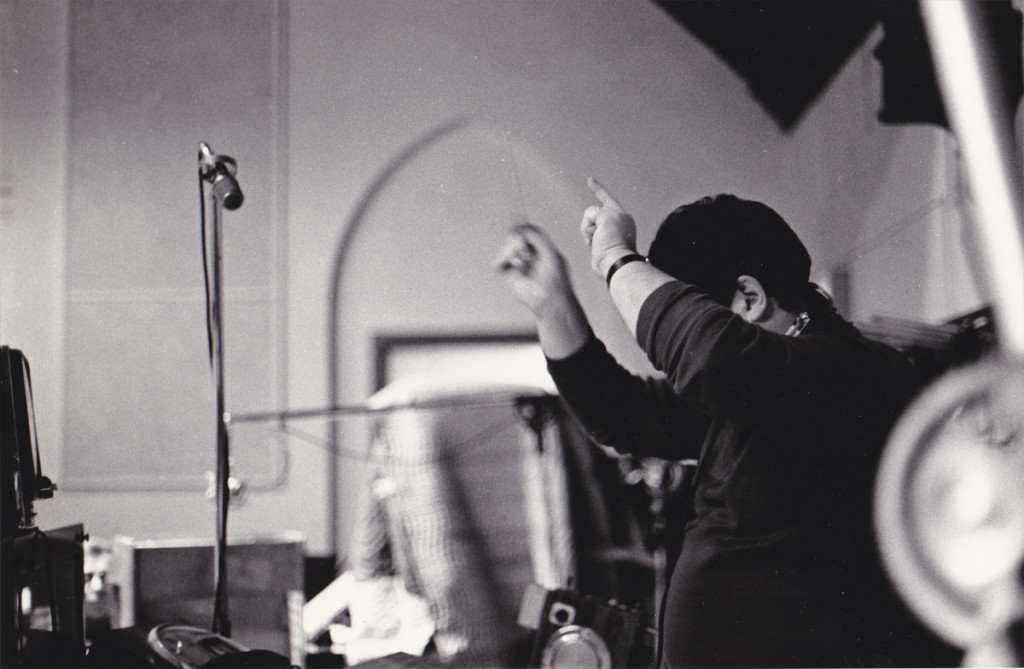 2
2
It all started with Joe Raposo, the composer of “Bein’ Green”
and many other hit Sesame Street songs. He wrote a musical for “Raggedy Ann
and Andy” and was made to see that it would make a wonderful animated musical.
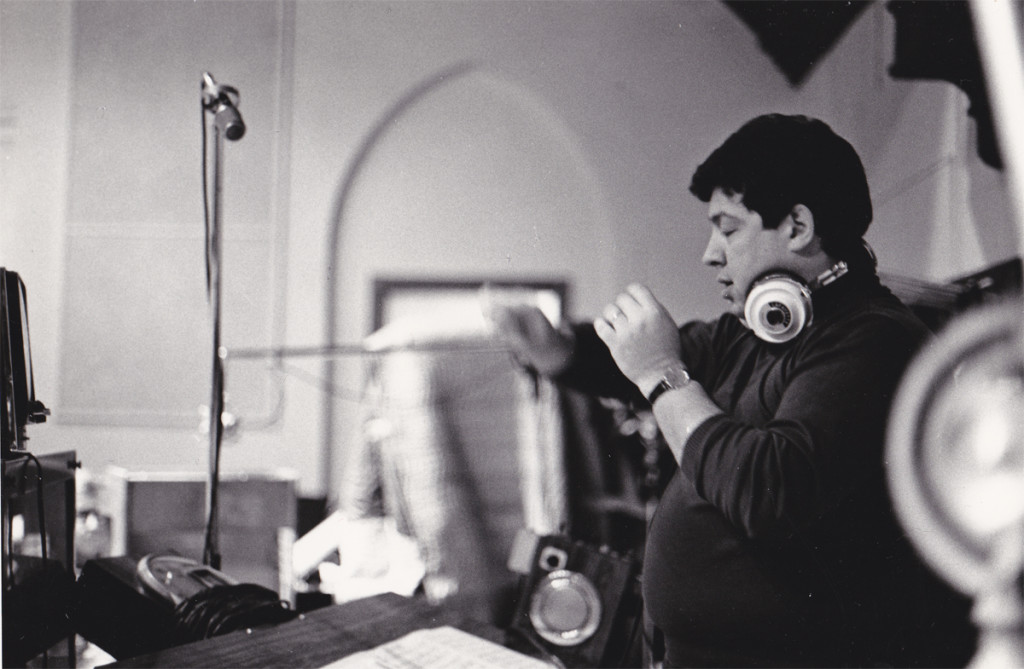 3
3
He wrote a lot of songs for the slim script and they prerecorded
the songs for the animation. We lived with a soundtrack of about
a dozen musicians playing this very nice score to the delicate voices
that sang the tuneful pieces.
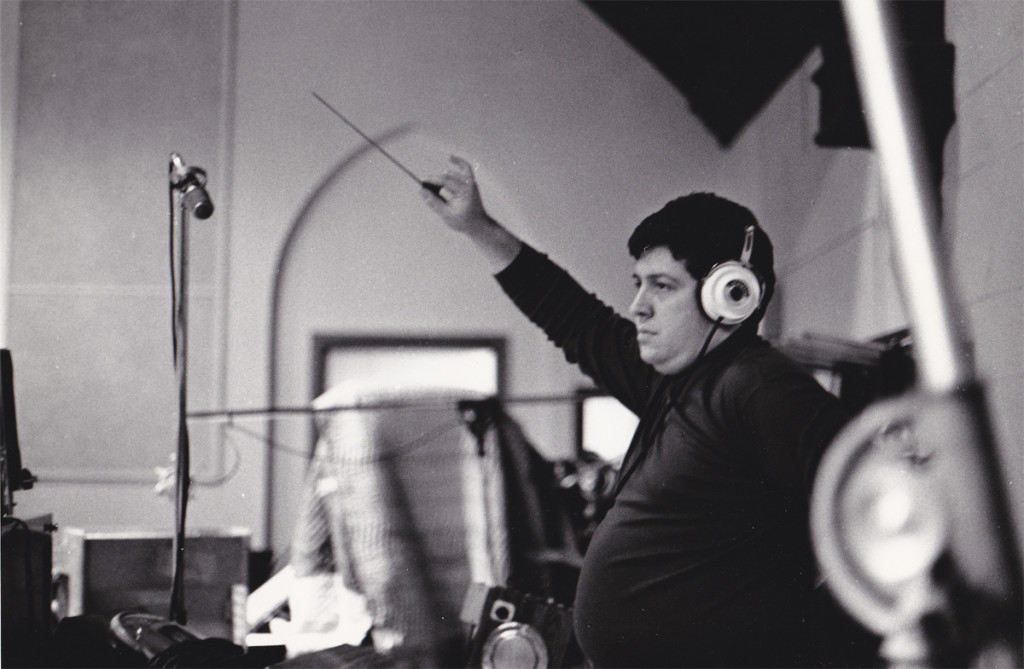 4
4
We heard this at least once a week as the animatic/story reel
grew into a full animated feature shot completely in Cinemascope.
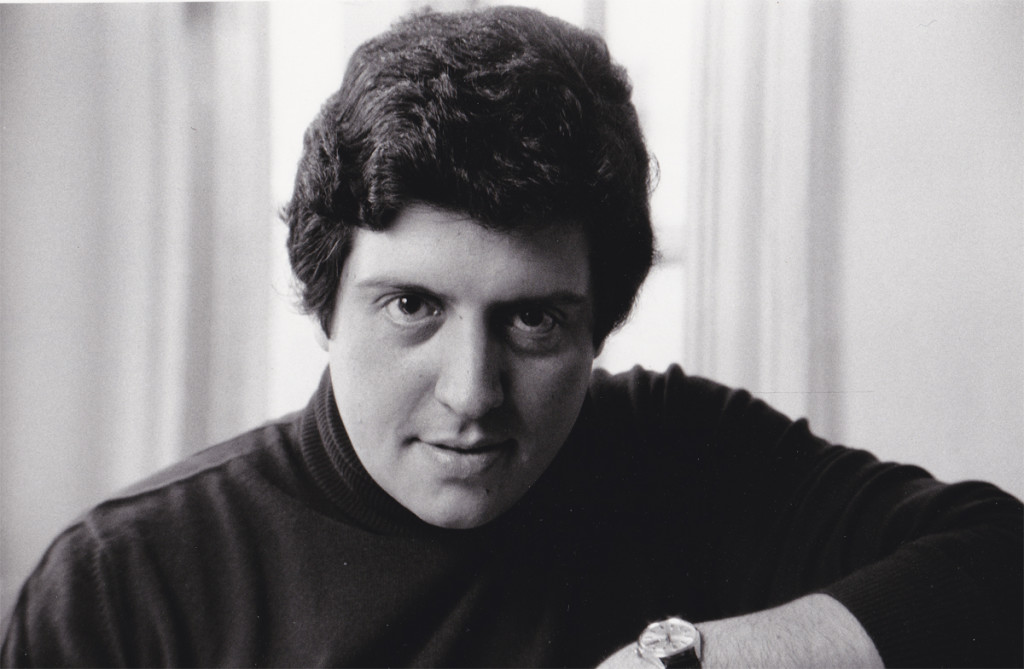 5
5
When the final film was released, that 12 person orchestra
became 101 strings and a big over-polished sound track.
No matter where you went the music was there and in the way.
It was too big, and the movie was too small. It was bad.
The track was incredibly amateurish. The composer had too much control.
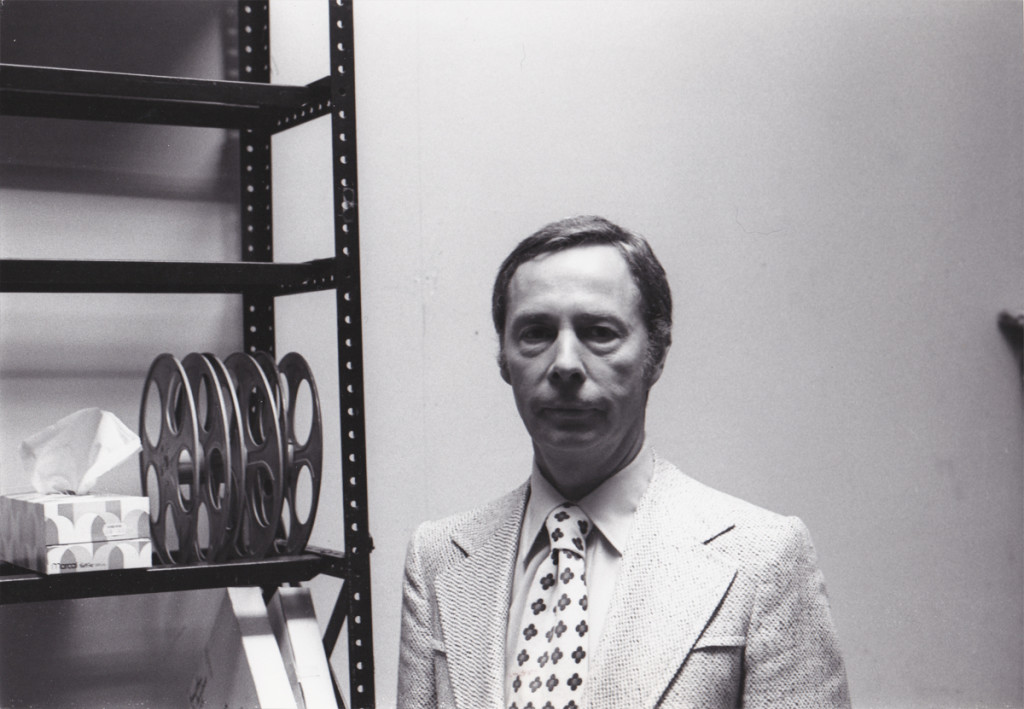 6
6
This was Richard Horner. He was one of the two producers of the film.
Stanley Sills (a Broadway producer and Beverly’s brother) was the
other producer who didn’t know what he was doing.
They represented Bobbs-Merrill who owned the property.
I really liked Mr. Horner. We met again a number of years later
when Raggedy Ann was distantly behind us. I’d offered to take Tissa to church,
one Easter Sunday; Richard Horner and wife were there. He asked to meet with me.
He sought advice on some videos of artists and their work that he was producing,
and hoped I could offer my help in leading him to some distributors.
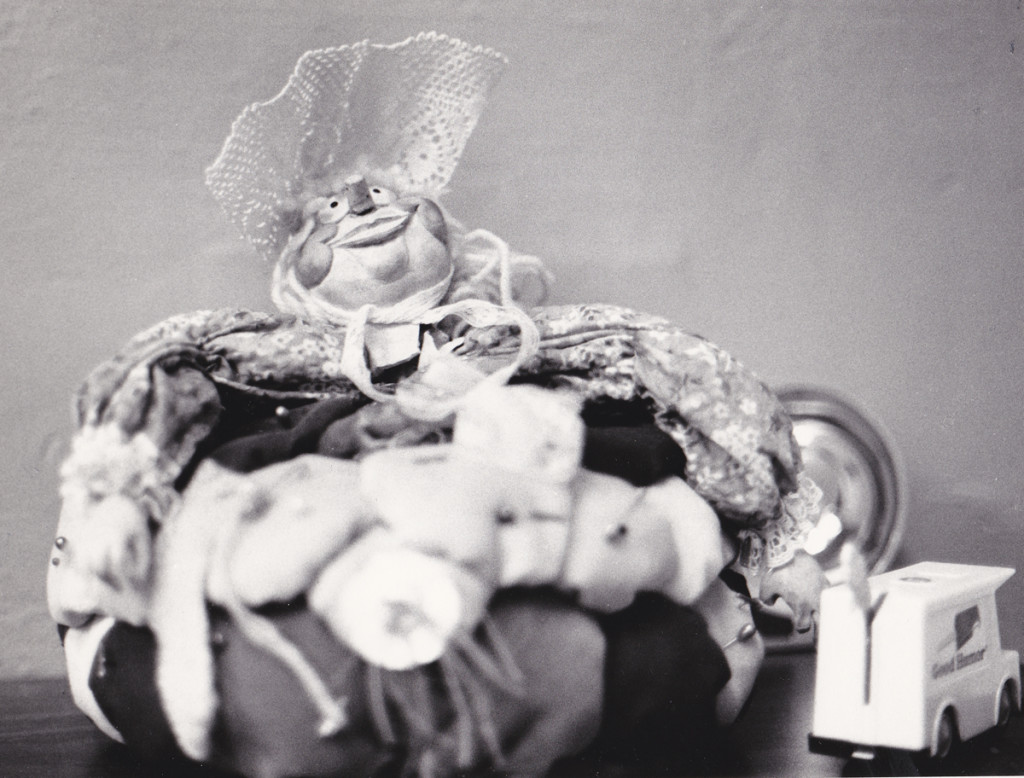 7
7
This is one of the dolls in the play room,
Susie Pincushion. She was charming.
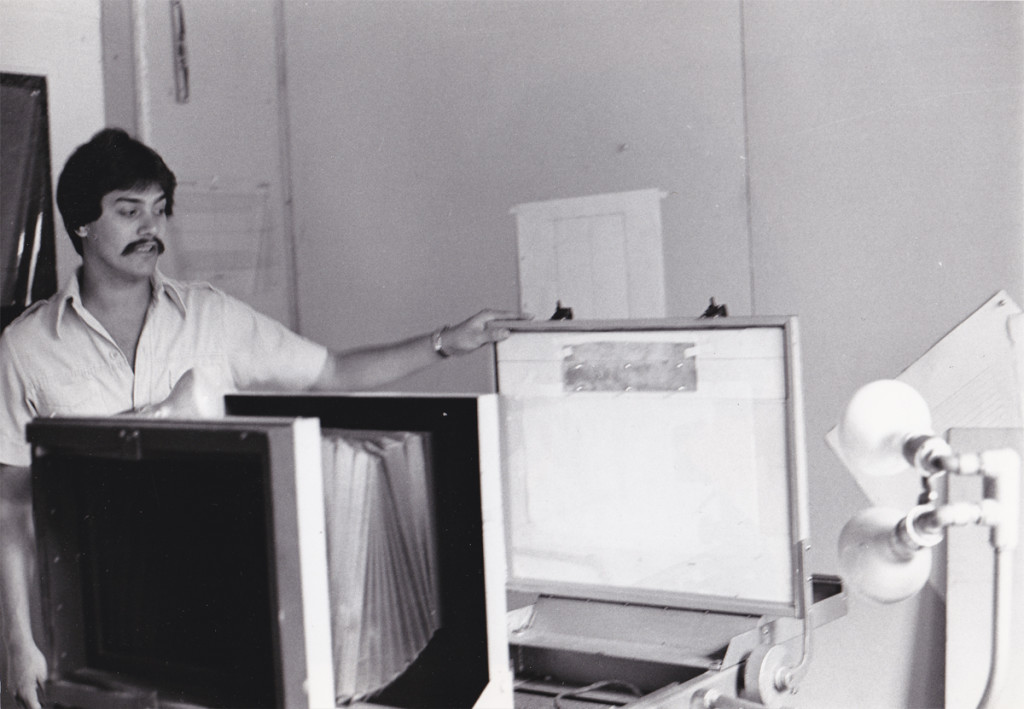 8
8
This is Cosmo Pepe; he was one of the leaders of the Xerox department.
It was Bill Kulhanek‘s department, but Cosmo really did great work.
They had this room-sized machine that they converted drawings into cels.
It was all new to NY, and the whole thing was so experimental.
Especially when Dick decided to do the film with grey toner rather than black.
The film always felt out of focus to me (even though it wasn’t.)
In the end when they rushed out the last half of the film, Hanna Barbera
sub-contracted the Xeroxing, and it was done in a sloppy and poor black line.
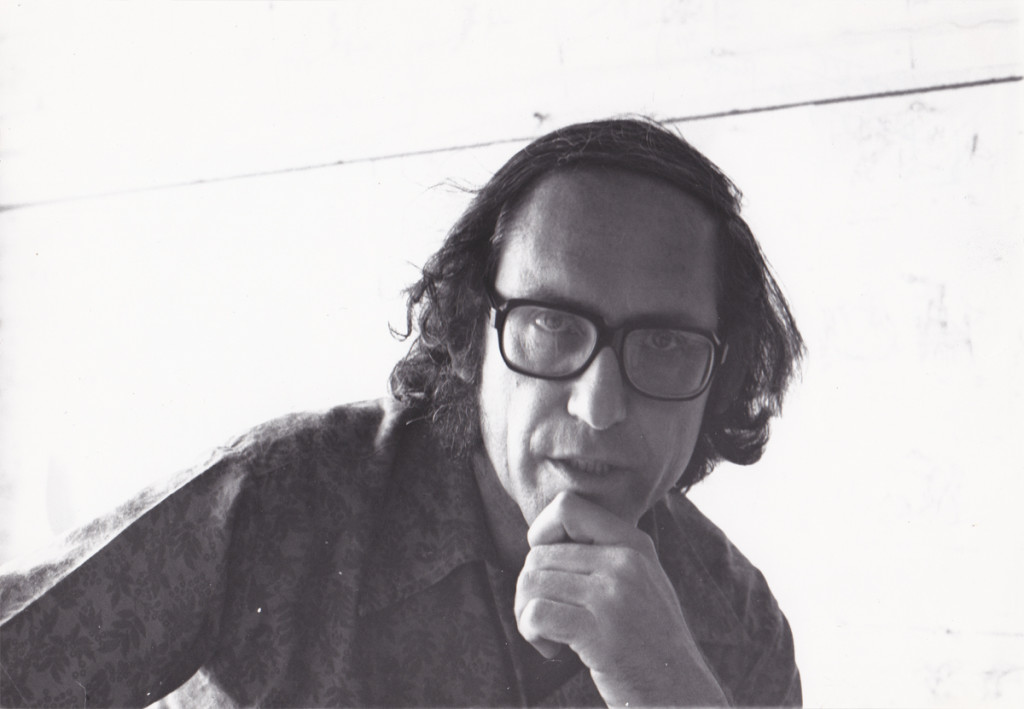 9
9
This is Corny Cole. He was the designer of the film, and all the great art
emanated out of his Mont Blanc pen nib. Or maybe it was a BIC pen.
Whatever, it was inspirational.
I wrote more about him here.
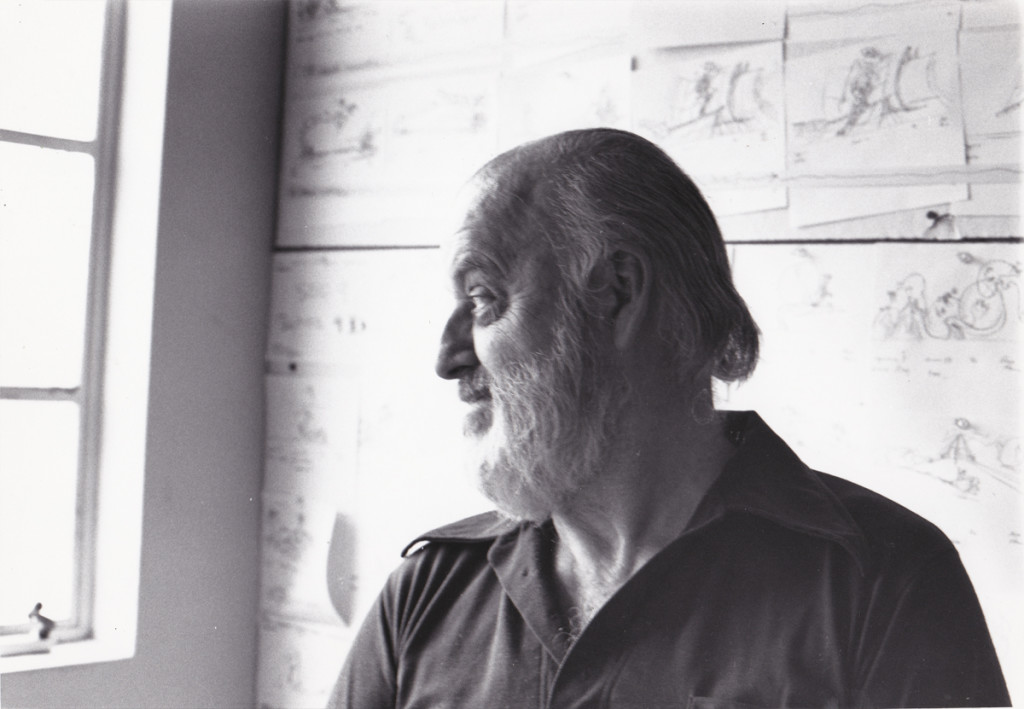 10
10
The gifted and brilliant animator, Hal Ambro. Can you tell that
I admired the man? I wanted badly to meet him during this production,
but that never was to happen. Now, I can only treasure his work.
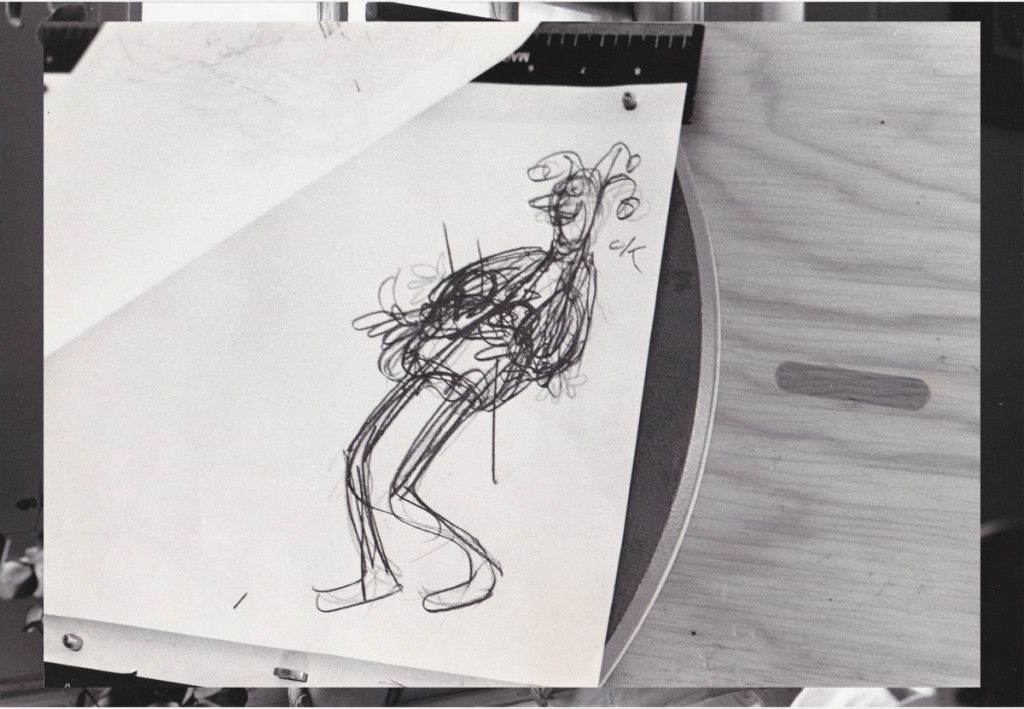 11
11
This is a very rough planning drawing that Grim Natwick did on
the Jack-in-the-Box he animated. See the scene here.
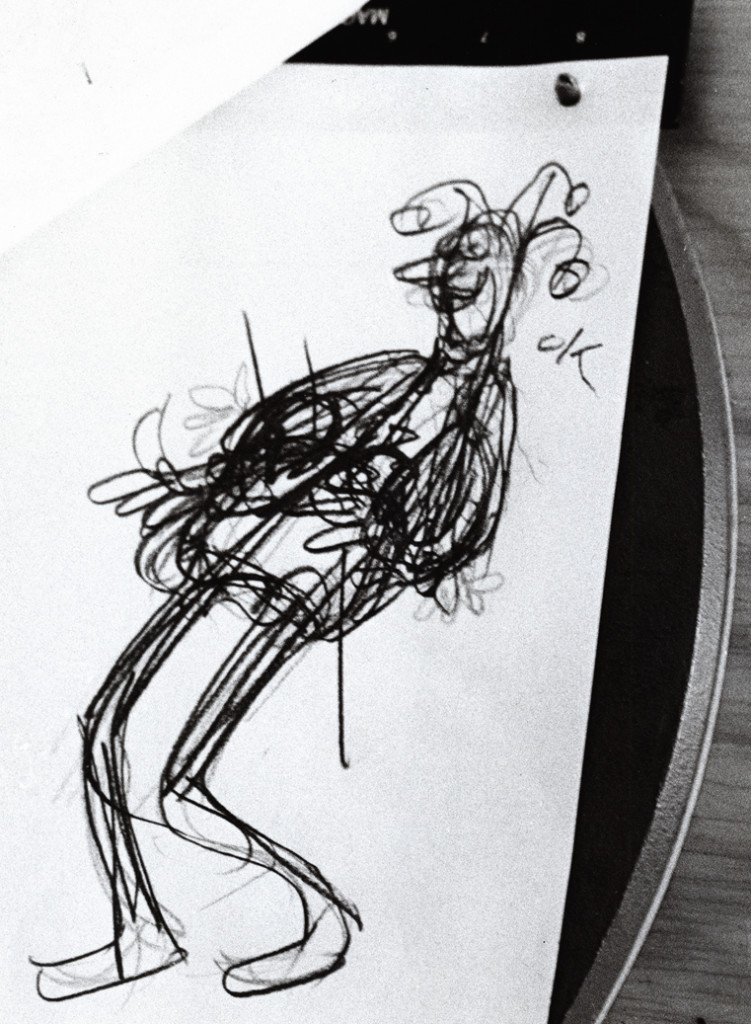 12
12
Here’s a close up of that very same drawing.
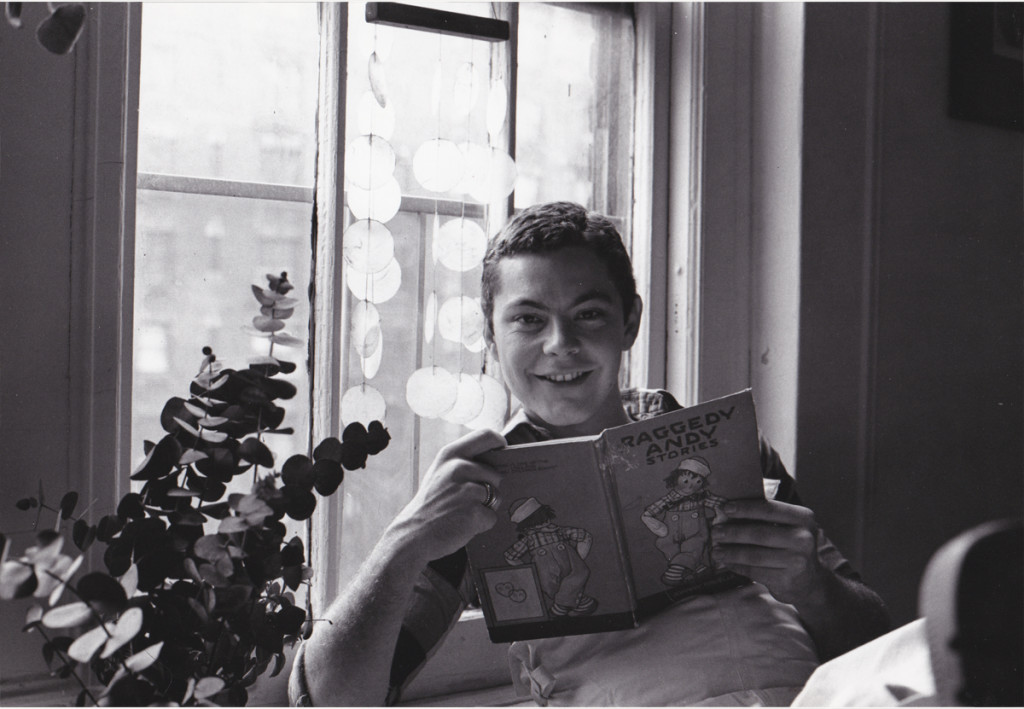 13
13
Mark Baker did the voice of Raggedy Andy.
He’d won the Tony Award as Best Featured Actor in the musical, Candide.
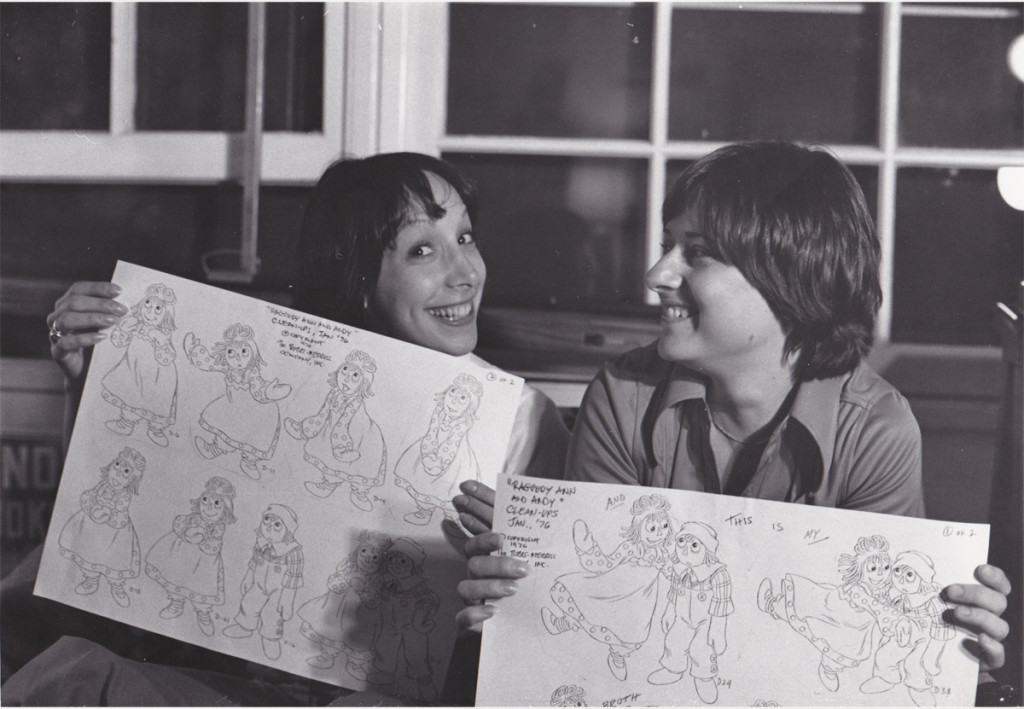 14
14
Didi Conn, the voice of Raggedy Ann, with Chrystal Russell, an animator
of Raggedy Ann. She backed up Tissa David who was the primary actor for
that character and did most of the film’s first half. Chrystal did many
scenes in the first half and most of the second.
She had a rich identifiable style all her own.
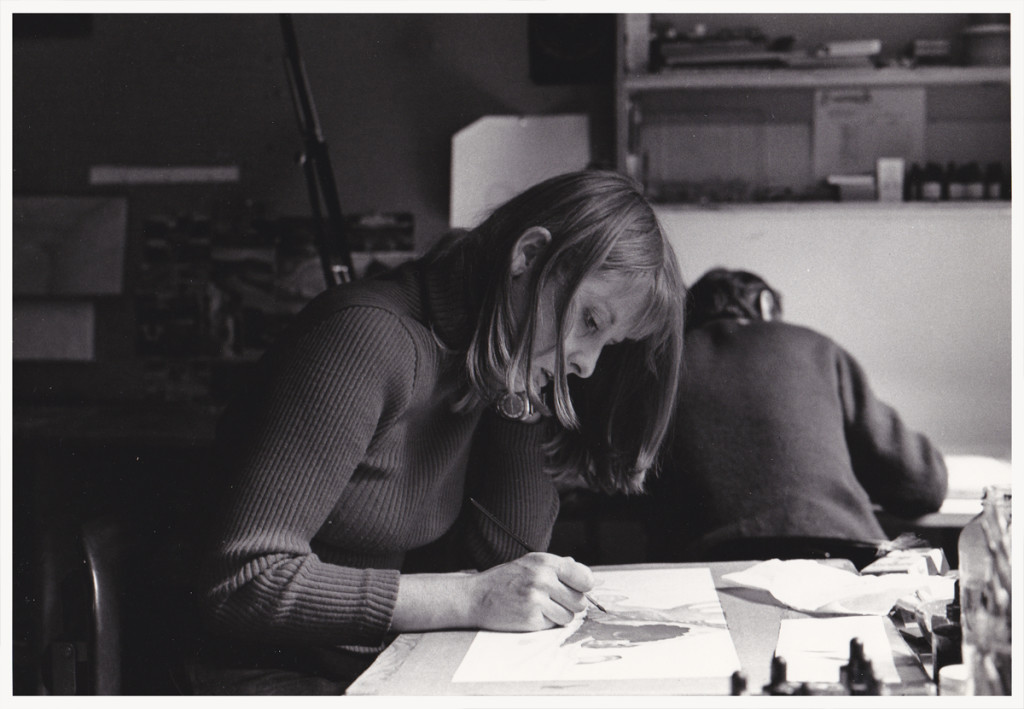 15
15
Sue Butterworth, head of the BG dept who designed the watercolor style
of the film. Michel Guerin, her assistant, can be seen in the rear.
Bill Frake was the third part of that BG department.
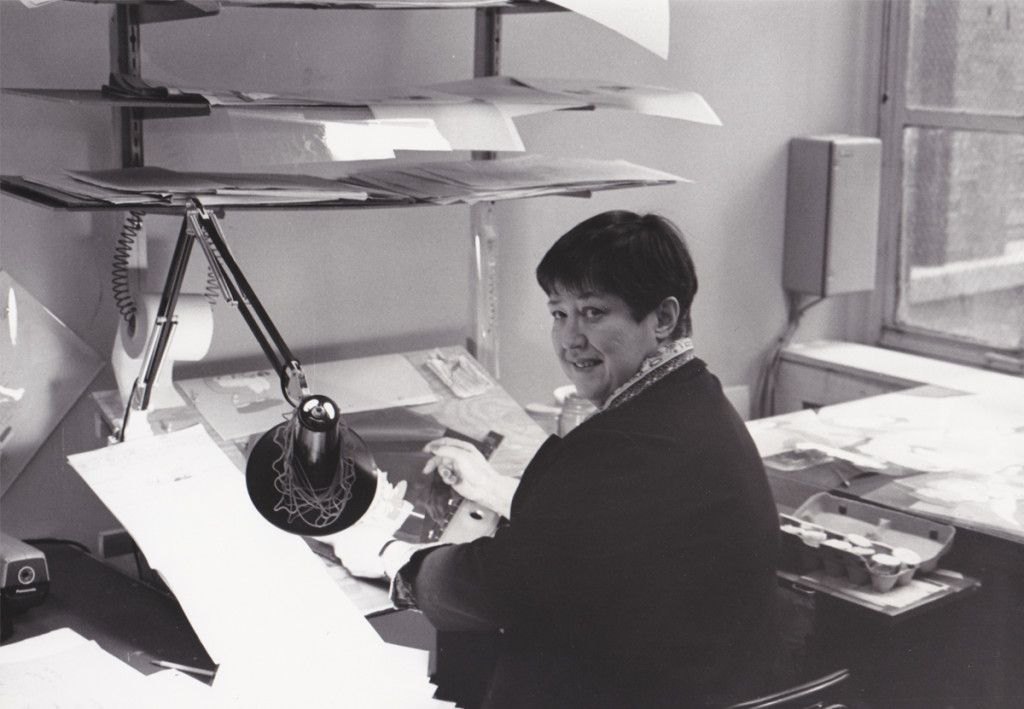 16
16
Painter, Nancy Massie. A strong and reg’lar person
in the NY animation industry. She’d been working forever for a reason.
On the average, I spent about an hour a day down in the Ink & Pt dept.
Often they had problems to resolve with some animator’s work. Either the
exposure sheets were confusing or they didn’t match the artwork, or there
was some question that they found confusing. My being available made it
helpful to them, and I did so without hesitation.
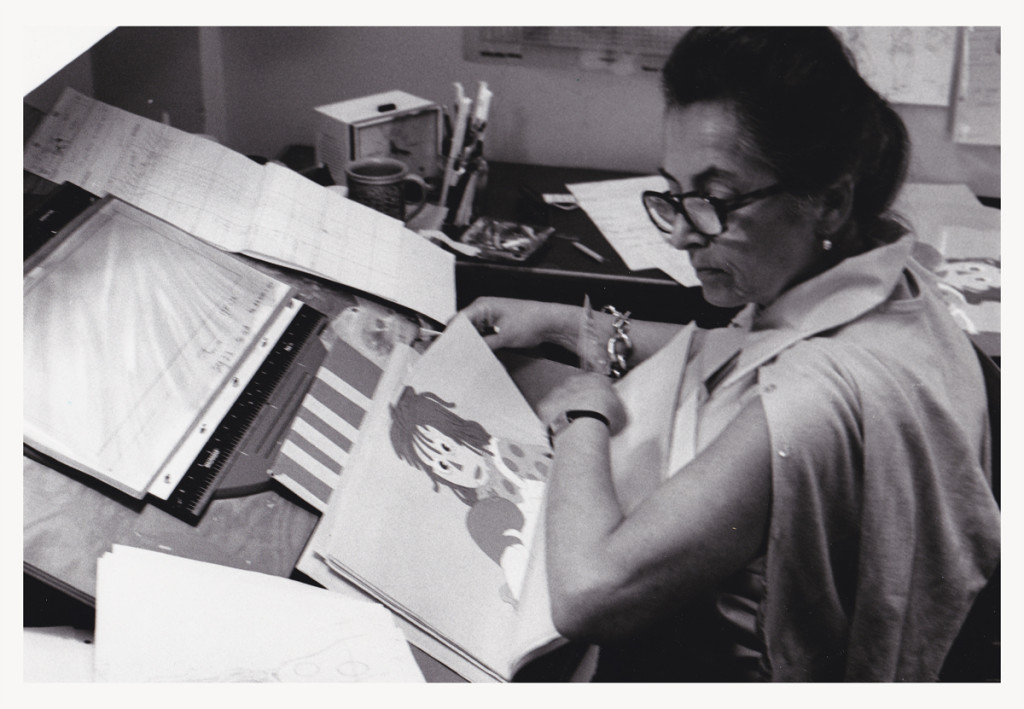 17
17
Checker, Klara Heder. Another solid person
within the NY industry.
Generally, before a scene left my department for the I&Pt dept., I’d
have studied the exposure sheets and felt I knew the scenes before
they were handed out to the Inbetweener or Assistant. It meant taking
a lot of time with the work in studio so that I was not only prepared
to answer questions of a checker but the Inbetweener as well.
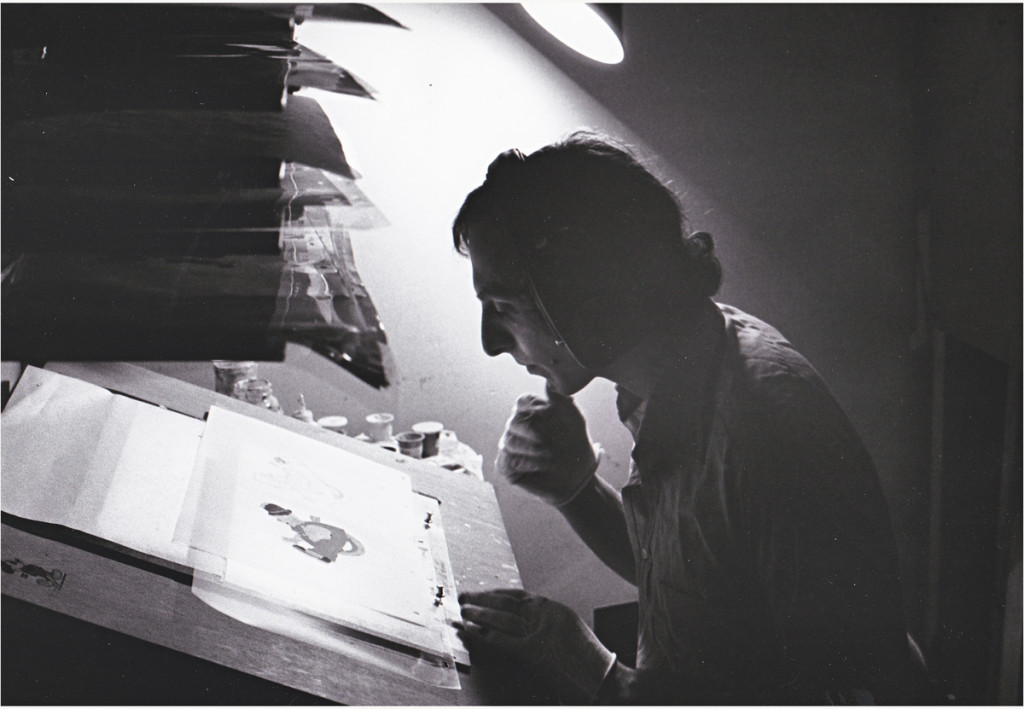 18
18
Sorry I don’t know who this is. If you have info,
please leave it for me. For some reason, I’d thought
he was an inbetweener (which would’ve made it odd for
me not to recognize him by name.) Apparently he’s a painter.
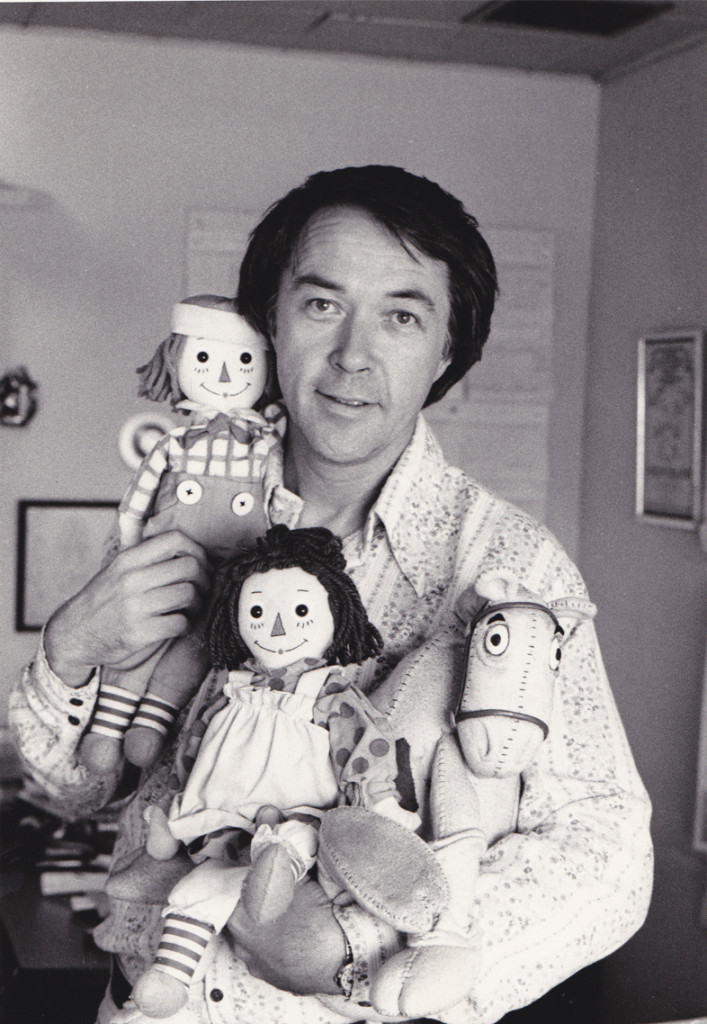 19
19
Carl Bell was the West Coast Production Coordinator.
We spoke frequently during the making of the show.
When I left the film, I went to LA for a couple of weeks.
Chrystal Russell threw a small party for me, and Carl came.
(I think he might have brought Art Babbitt, who was there.)
The group was small enough that we could have a talk that we all
participated in. We talked for some time (though not about
Raggedy Ann.) It was great for me.
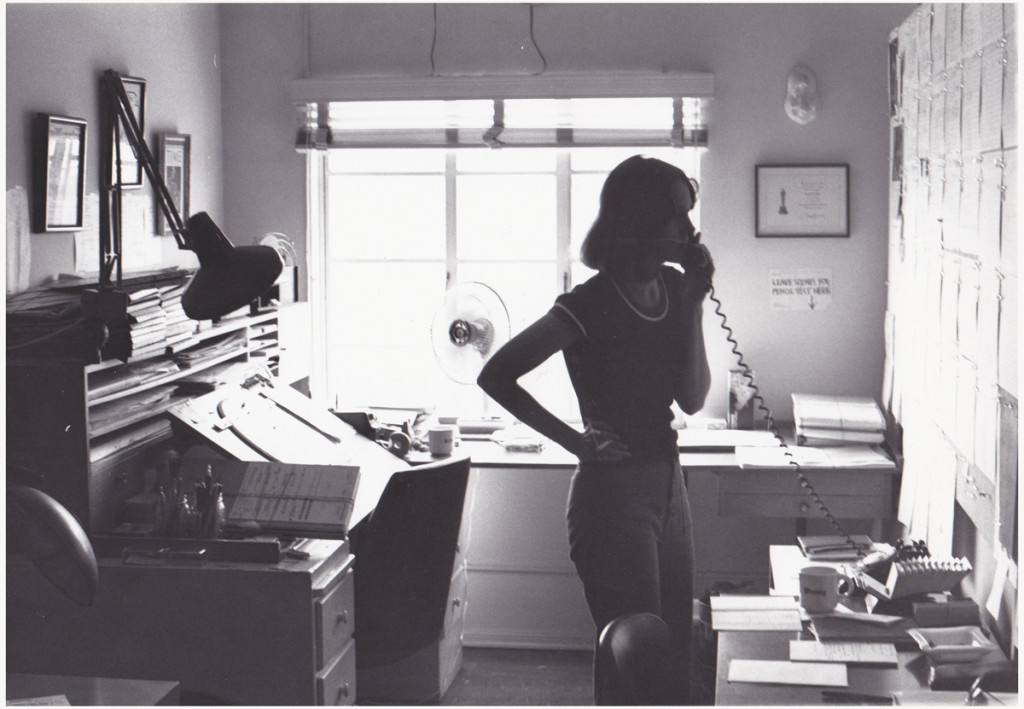 20
20
Jan Bell, Carl’s wife, was the West Coast Office Manager.
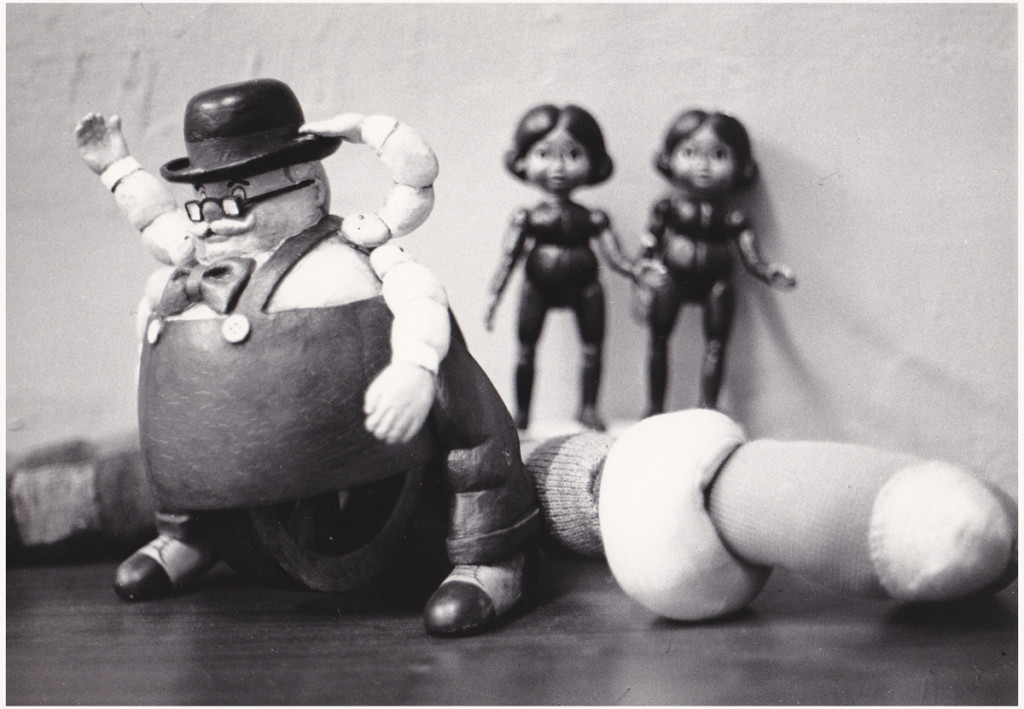 21
21
Maxie Fix-it. This was a great doll that wound up to get the legs going.
He rolled around the floor beautifully. The “Twins” in the back were animated
by Dan Haskett. though I’m not sure they gave him credit for it. I was a bit
embarrassed by these characters. They were just a naked bit of racism running
about our cartoon movie for very young children.
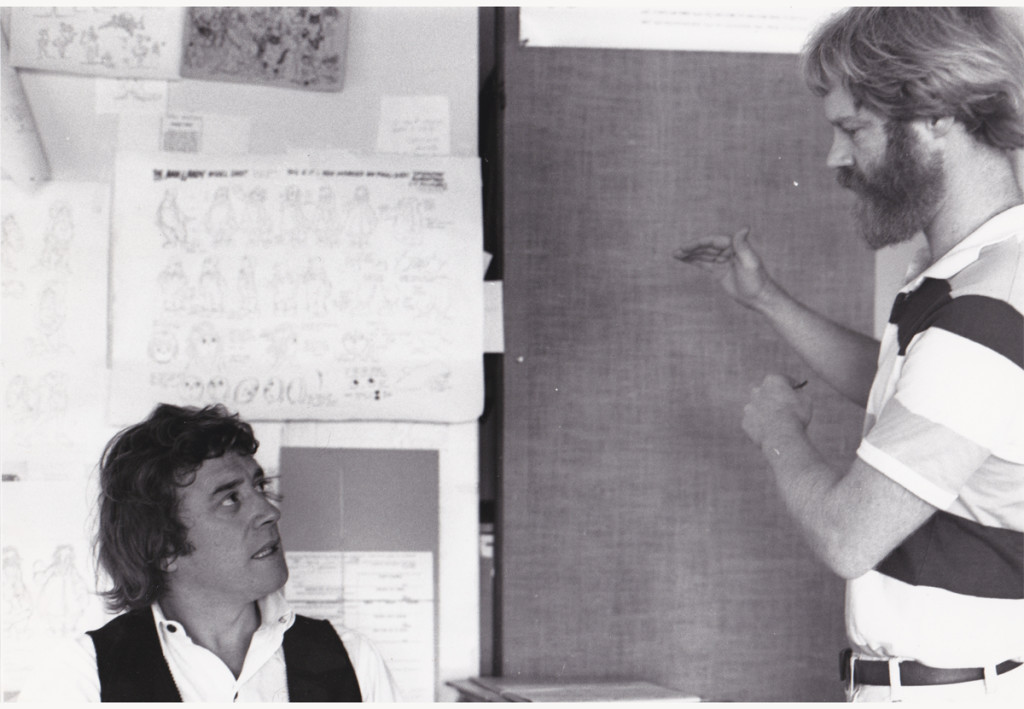 22
22
Gerry Potterton (left) and John Kimball (right).
Gerry was one wonderful person. I always enjoyed spending time with him.
He produced/directed a number of intelligent, adult animated films.
This includes an animated Harold Pinter‘s Pinter People.
After Raggedy, I tracked Gerry down to get to see Pinter’s People. It was
rather limited but full of character. Gerry knew how to handle the money
he was given, unlike some other directors.
John Kimball was, at the time, not in the caliber of Babbitt or Ambro or
David or Hawkins or Chiniquy. However, he did some imaginative play
on a few scenes which were lifted whole from strong>McCay’s Little Nemo
in Slumberland. One of these scenes I animated but was pulled
from it before I could finish it. I had too much else to do with the
tardy inbetweens of Raggedy Ann (an average of 12 drawings per day)
and the stasis of the taffy pit (an average of 1 inbetween per day).
Too many polka dots on Ann and too much of everything in the pit.
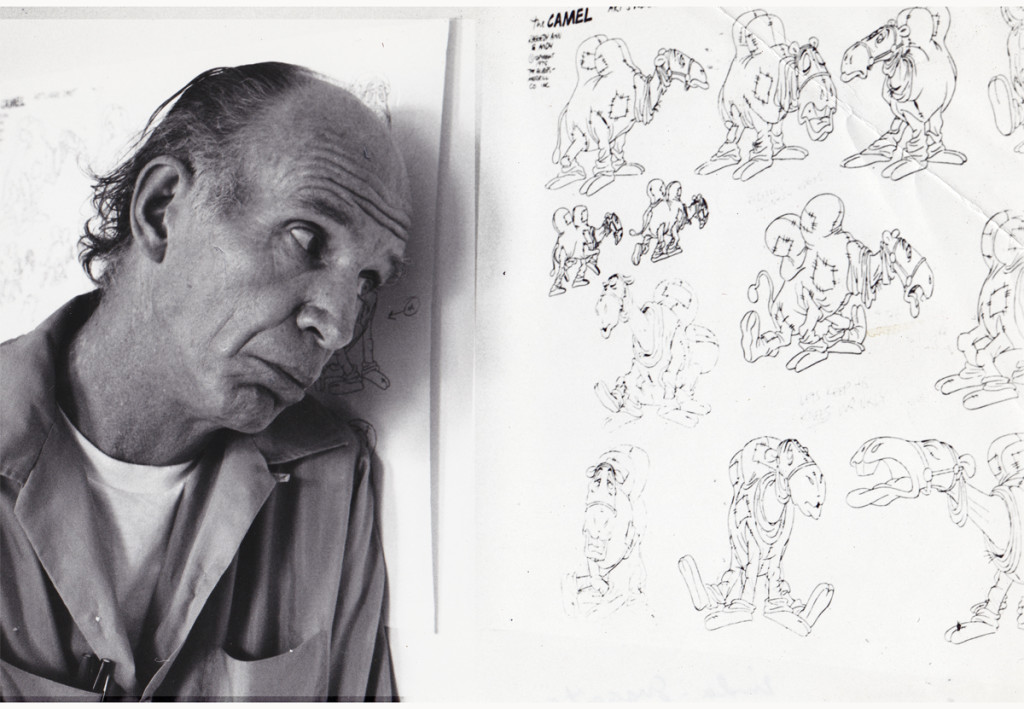 23
23
Fred Stuthman, the voice of the camel with the wrinkled knees.
He did add a great voice for the camel, though for some reason
I remember his being a dancer, predominantly.
All photos copyright ©1977 John Canemaker
.
Commentary 13 Apr 2013 05:49 am
Bruising the Squiggle
M’friend, Steve Fisher, sent a really nice little essay (not for posting but just something he wanted to share with friends). Unfortunately, anyone who sends me anything has to be prepared for it to end up in the public’s hands. It’s a quick read:
Once upon a time, far, far away… actually, it was really yesterday, and it was at the nearby Metro Mall in Middle Village.
I found that I was early for a meeting of Weight Watchers because I was confused as to what day it was, but that’s another story. In any case, I decided to walk around the area until the meeting time rather than return on another day for a different meeting. As the correct meeting time neared, I sought the men’s room of the adjoining Kmart.
As I completed using the facilities there, I heard someone enter the room. When I left the stall, I saw a young, black man standing alongside the lavatories. I have to admit that a hint of racial-profiling stirred to a conscious level. In my defense, though, I believe I would have been suspicious of this individual regardless of race because he was just standing there in a men’s room, not using the sink, the urinal, or the second vacant toilet stall; my New Yorker wary mind asked myself, What is this guy up to?
I walked past him in order to use the lavatory and he said, “Good morning.†This seemingly innocent comment raised more red flags, Who chats it up in a men’s room with total strangers? In a tone that did not invite further talk, I grudgingly responded, “Morning.â€
As I began to wash my hands, he said, “Can I ask you a question?†I looked up to face him, trying to judge just what was going on, sensing a dangerous situation developing. I took a closer look at him for the first time; I saw that he was probably not yet twenty years old. He wore a long-sleeve white dress shirt which hung out almost to the knees of his black jeans; a baseball cap was cocked at an angle on his head. I said, with hesitation undoubtedly palpable in my voice, “Okaaay.â€
He pointed to his own shirt and inquired, “Should I tuck this in?†“Do you work here?†I asked. “Interview,†he responded. “Yes,†I said definitely, relieved to finally understand where this fellow was coming from. “Thank you,†he replied, and proceeded into a stall, presumably to tuck his shirt into his pants. Here was not a threatening pervert, but a polite young man concerned to make a good impression at his upcoming appointment. As I left the men’s room I called out to him, “Good luck,†and he rejoined, “Thanks.†I hope he got the job.
The lay Offs
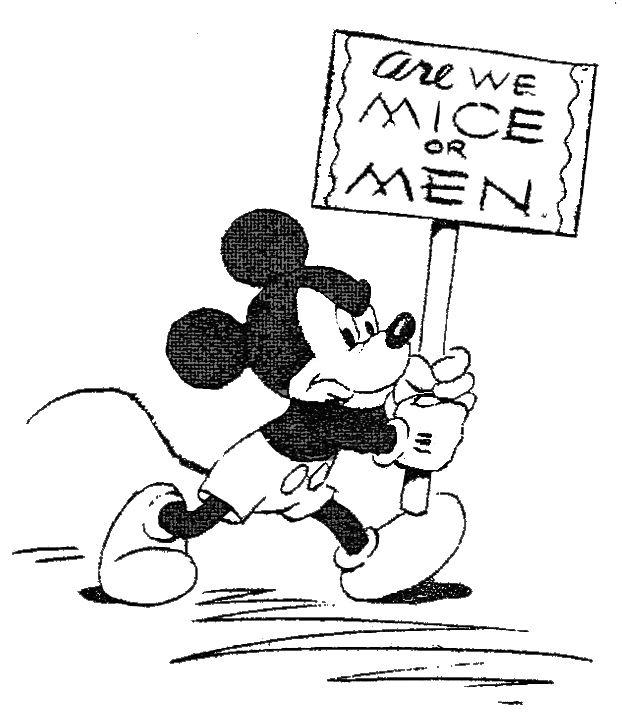 The reports started flying fast and furious on Thursday late afternoon. “Disney 2D animation had been gutted!” “Sad day for hand drawn animation.” As it turns out, the theatrical division of Disney, which has a small remaining staff of 2D animators finally let go of the majority of their staff. These are people who have not worked on any real projects since Winnie the Pooh. Everything done has been exploratory in the past year. Iger, himself, announced at the Disney board meeting that here was no 2D animation in progress, to his knowledge.
The reports started flying fast and furious on Thursday late afternoon. “Disney 2D animation had been gutted!” “Sad day for hand drawn animation.” As it turns out, the theatrical division of Disney, which has a small remaining staff of 2D animators finally let go of the majority of their staff. These are people who have not worked on any real projects since Winnie the Pooh. Everything done has been exploratory in the past year. Iger, himself, announced at the Disney board meeting that here was no 2D animation in progress, to his knowledge.
What did people think was going to happen? The studio was not going to continue to finance a division that wasn’t in production. Since Winnie the Pooh, the only real 2D division has been the television production staff.
There were announcements all last week about 150 people being let go at Disney’s studio. No one cried for the marketing people that were let go. I guess letting go the 2D theatrical people became an obvious symbol. A symbol that was too juicy for the likes of the chefs at Cartoon Brew and other internet muckrakers. Yet the obvious was just that. Wasn’t it clear that there was a real reason that Andreas Deja and others left the studio last year? Why is anyone acting surprised?
Sequester anyone?
The Real Effect
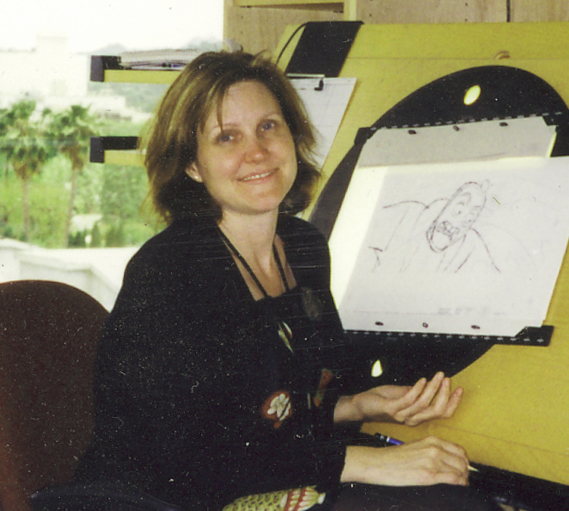 - Kathleen Quaife is an animator working in feature animation in Hollywood. Point of fact is that she’s an EFX animator. She’s done a lot of water in studio films of the 21st Century. She offers a couple of sample reels on her blog. I really enjoy animated effects, especially the hand-drawn kind. Computer animation seems, to me, to be an animation effect, in itself. Drawing all those waves and bubbles and cascading ripples by hand gets my attention.
- Kathleen Quaife is an animator working in feature animation in Hollywood. Point of fact is that she’s an EFX animator. She’s done a lot of water in studio films of the 21st Century. She offers a couple of sample reels on her blog. I really enjoy animated effects, especially the hand-drawn kind. Computer animation seems, to me, to be an animation effect, in itself. Drawing all those waves and bubbles and cascading ripples by hand gets my attention.
I suggest you take a look at the extraordinary samples on her blog here (lotsa clips from Disney). While you’re there, if you have the time, there are links to specific effects you can watch (e.g. water, fire, rain etc.).
Her resume is full: Hercules, Tarzan, Pocahonatas and Ferngully. Tummy Trouble, The Runaway Brain, and Pups of Liberty. The Land Before Time, Rockadoodle, Dragon’s Lair and An American Tale. She’s been doing great work for a long time, and she deserves a bit of attention.
She also has this entertaining video showing her drawing an animated splash.
Animating a Splash
Animation Scoop is Real
Yep, it’s real. The new animation site, Animation Scoop, was publicly announced by webmeister, Jerry Beck, and sure enough it was still there the next day. And Thursday, and Friday and today. I guess that means it’s lasted longer than most of the blogs out there, so we’ve got to say it’s a real thing. Let me jump to the front of the line to say I’m glad. I wouldn’t want any of the mass of animation news to pass under our noses, and another blog will certainly help us to keep track of it all. On top of that, it’s from Jerry Beck. You’ve got to love it. All we need now is some real animation. All we seem to have is product that’s been dredged up by a computer somewhere. We need something animated, something with dignity.
But seriously, congratulations Jerry, and more power to you. I love having another stop in the mornings.
Political Animals
I thought of this story while responding to a comment on the Splog:
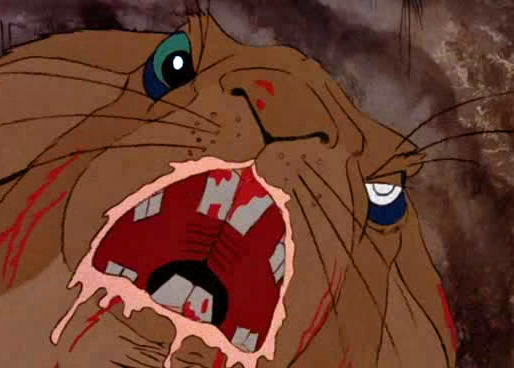 There was the day at the Hubley Studio when we knew that John had gotten the position of directing the film version of Watership Down. He’d take off for England in a few months and they’d set him up not too far from the office in an apartment.
There was the day at the Hubley Studio when we knew that John had gotten the position of directing the film version of Watership Down. He’d take off for England in a few months and they’d set him up not too far from the office in an apartment.
At one point during the day he and I were alone in my room. I told him I was glad he was doing it, Watership Down; I enjoyed the book. I went on about it saying it seemed like a more current version of Animal Farm. John said that he thought that Halas had really screwed up that film, and it was too bad. There was a lot of meat there, and he didn’t think they got it all in the film version. John felt that he wouldn’t make the same mistakes with Watership Down. We talked only briefly about Animal Farm.
I made plans to move on to Raggedy Ann & Andy. I had been writing to Dick Williams for years about my possibly working for him. Tissa David (the very first person Dick had hired; she did a 30 second sample Pencil Test which clinched the film for Dick) had broached him about hiring me, and I was offered a job as an inbetweener. (That turned into supervising all of the Assistant Animators and Inbetweeners.)
Several weeks later, after John Hubley had made a few trips to England preparing to start on Watership Down, he called me into his room. John said that he wanted to keep the US office going, at the very least doing a short that he had in mind. Tissa would animate it. (The short was going to be an extension of the section in Everybody Rides the Carousel which Tissa had animated. The piece where the two young lovers argue over her having cut her hair without getting his permission.) John wanted to know what it would take for me to stay on supervising the NY production work. I thought about it overnight and asked for him to match what Raggedy Ann was going to pay me to inbetween. It was about $20 a week more than I’d made working on the “Carousel.” John offered $5 less, and I decided to say, “No.” We parted amicably, and John didn’t keep his studio going for the time he worked on that feature.
I went back to work for him immediately on leaving Raggedy Ann. They were about to start Doonesbury, and I would supervise the production. I started at the same salary I’d made as an inbetweener at Raggedy Ann, including that extra $5.
Unfortunately, John was to have an urgent operation some three weeks after I’d started work on the new film. It was arranged that I’d leave and come back once he’d recovered and we could get back to work. John died on the operating table.
commercial animation &Errol Le Cain &Illustration &Independent Animation &repeated posts &Richard Williams &Rowland B. Wilson &Tissa David 10 Apr 2013 05:55 am
Dick’s Christmas
Richard Williams, when he had his own studio, was known for doing everything in a LARGE way. All of the commercials, title sequences, shorts were all done with a large, elaborate vision.
The Charge of the Light Brigade was a collection of 19th century graphics that are completely wrong, stylistically, for animating. All those cross-hatched lines. God bless the artists that pulled that off. The same was true for The Christmas Carol.
If the rendering style wasn’t impossibly difficult, then the animation was complex. Think of any of the scenes from Dick’s dream-feature, The Thief and the Cobbler. The many scenes where backgrounds were animated, with those backgrounds complete with complicated floor patterns or an entire city to be animated. Raggedy Ann was covered in polka dots and Andy was clothed in plaids. Both of the characters had twine for hair with every strand delineated. The commercial for Jovan featured a picture-perfect imitation of a Frank Frazetta illustration. Even the mountain on the background had to be animated and rendered.
Well, when it came to Christmas cards, Richard Williams was the same. Enormous and beautiful cards were printed and signed by anyone who knew the recipient of the card. You were lucky being on the receiving line for these stunning cards. Tissa David once gave me a number of these cards. I held onto my copies of the cards until my space was flooded and the cards were damaged. I thought I’d post a few.
With card #1, a take-off of Muybridge with frame grabs from several of the better Williams commercial spots from that year, capped off by a number of key staff personnel positioned to continue the Muybridge motif.
(Here, I first post the entire card, followed by a break up of the card into sections
so you can more ably see the details.)
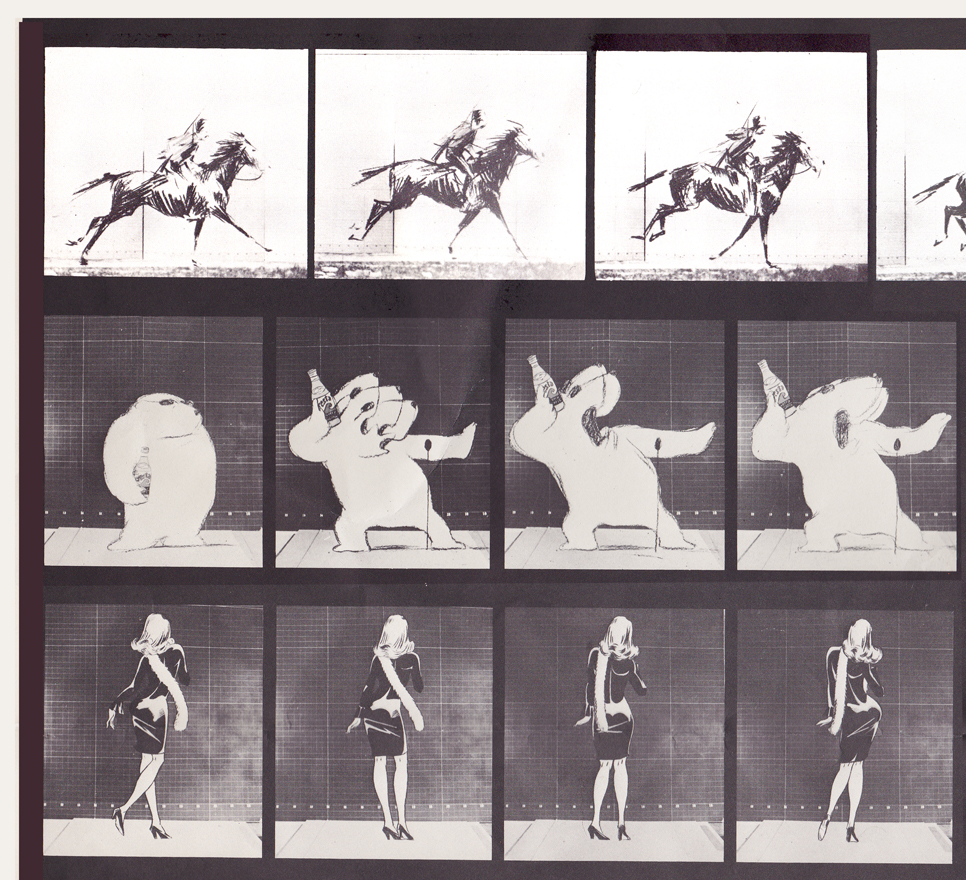
Top rows left side / Row 1: Pushkin Vodka ad
Row 2: Cresta Bear ad / Row 3. Tic Tac ad
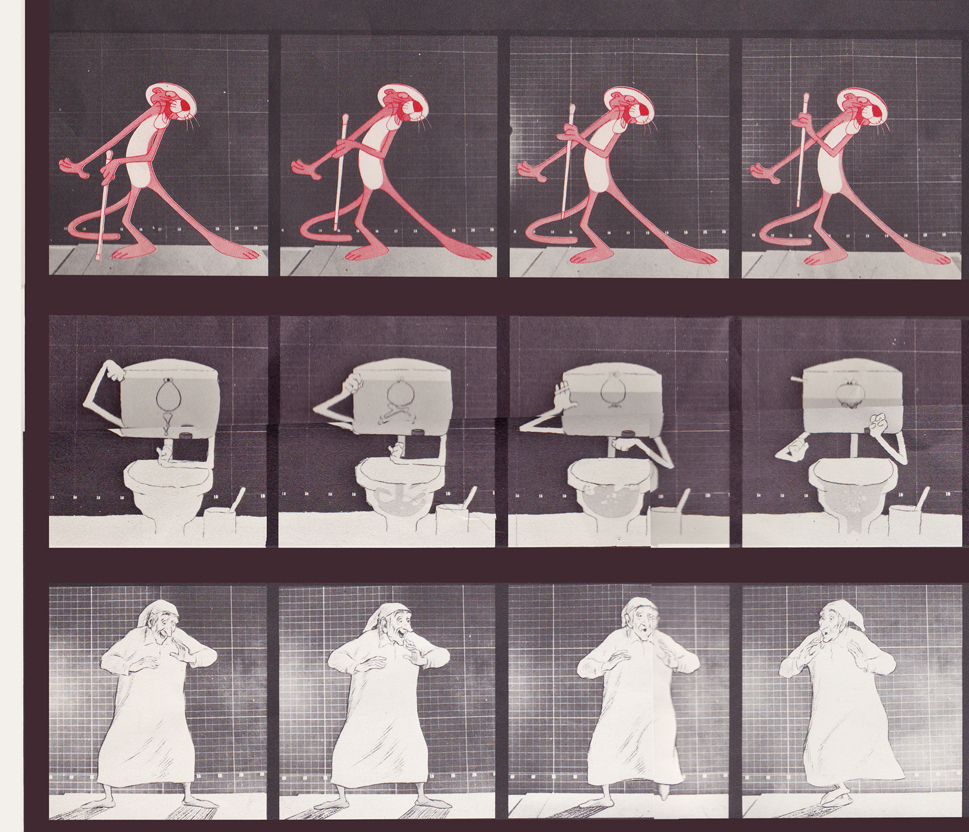
Middle rows left side / top row: Pink Panther titles
Middle row: Bloo toilet cleanser ad / Bot row: The Christmas Carol
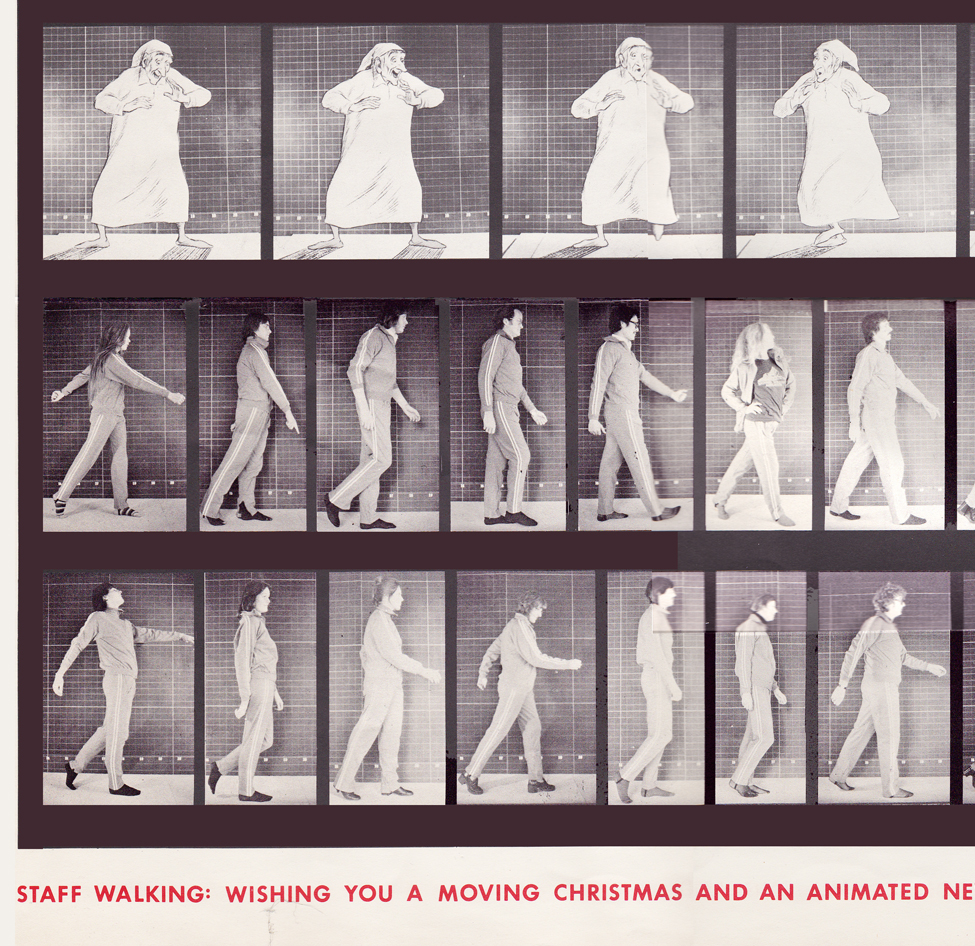
Bottom rows left side / top row: The Christmas Carol (repeated)
Middle row: staff / bottom row: more staff
With card #2 we see Soho Square. The green front door
marks the location of Dick’s studio at 13 Soho Square.
(As with the first card, I posted the entire Christmas card,
followed by a sectional divide so you can enjoy the details.)
This is a folding card.
It comes folded so that you see the far left of the card
revealing part of the far right.
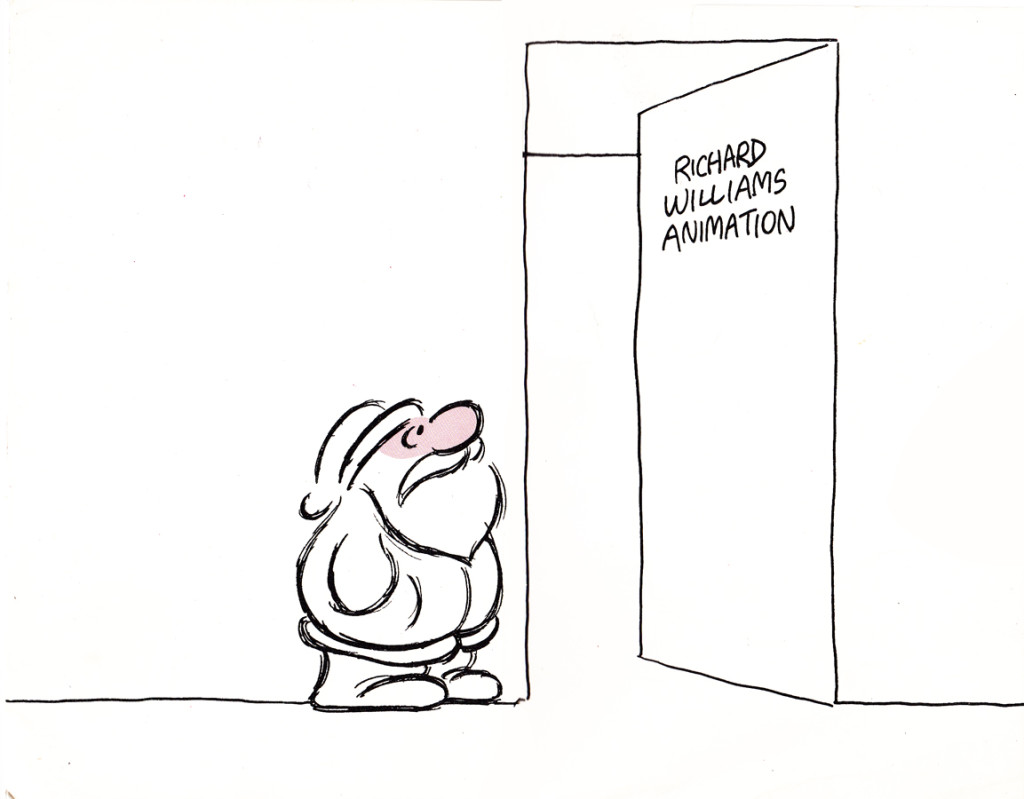
The card comes folded like this.
The left side (Santa up to doorway) is on the left side of the card.
The right side, on bottom, reveals the empty office.

It unfolds to reveal this long line of Santas.
Each Santa is in the style of the many illustrators’ styles
of those who designed ads for the studio in the prior year.
Suzanne Wilson sent in a Pink Panther Chistmas card; it was drawn by her late husband Rowland Wilson:
Below is a close up of that same card.
Here’s another full card.
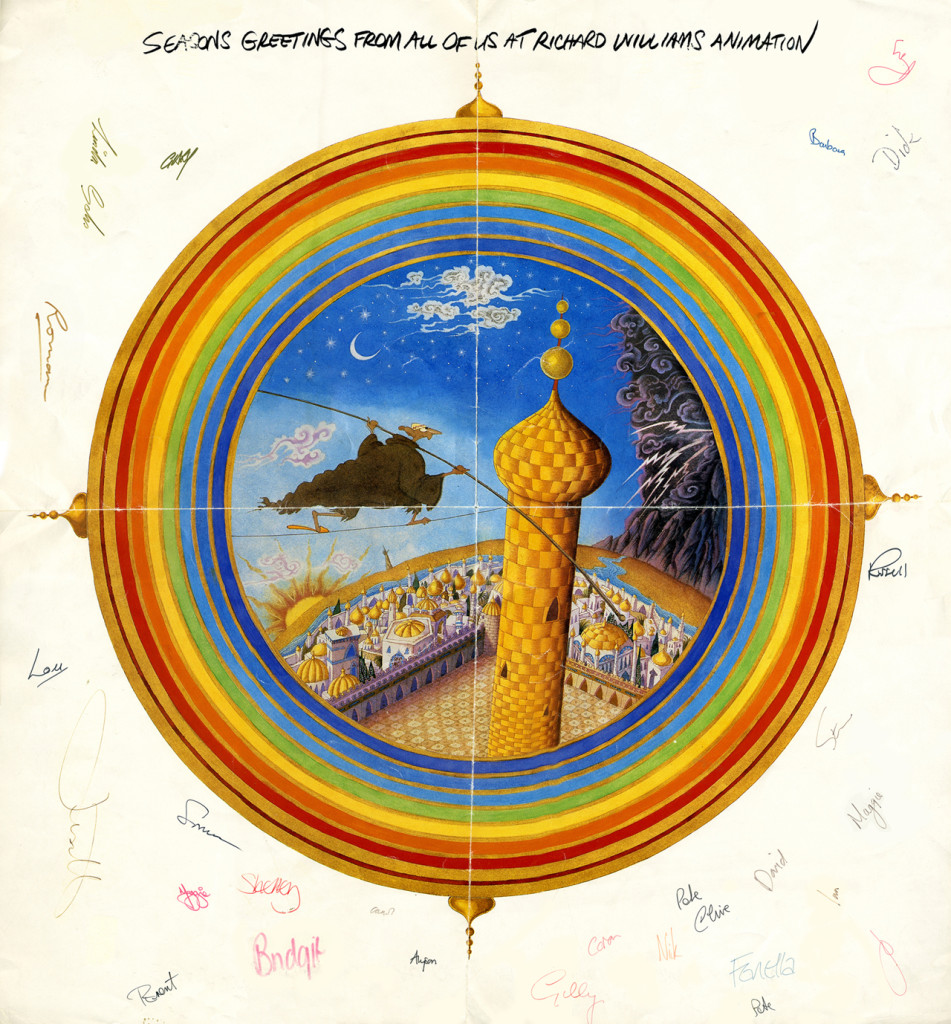
This one is designed after the McGuffin of Dick’s feature,
three golden balls over the city.
from The Thief and the Cobbler.
